How to List Publications on a Resume With Examples
Quick Navigation:

When to list publications on a resume
How to list publications on a resume, types of publications to add to a resume, examples of publications on a resume.
Having one or more published works listed on your resume can help you stand out as an applicant to a job or graduate program. Listing your publications on a resume also provides employers with proof of your writing and research skills which can help to highlight your qualifications. This article explains how to modify your resume format to include relevant publications and when to enhance your resume with published material.
The common situations where a list of publications can be most helpful to your resume include:
Academic resumes
Publications can be an important part of a resume when applying for colleges, graduate programs or jobs in academic research. Your publications show the admissions or hiring board the type of research you have done and that you have experience in writing academic content.
Scientific resumes
When applying for a position in a scientific field, you should include any scientific writing that you have published. This shows familiarity with the scientific process and the specific style of writing required in many academic fields. It can also show your interests and indicate productive lab or research projects.
Resumes for a relevant industry
If you have writing in a publication that is specific to the industry of a job you are applying for, consider including it on your resume. Publishing work in a trade journal can display your technical knowledge of a particular field.
Notable publications
Publications that are well-known in your community or on a national level can make your application more prestigious. Many companies are interested in employees who will bring a positive reputation, making candidates that have work in an established journal or newspaper more attractive.
Before listing publications on your resume, consider whether they are relevant to your job application. Resumes have a limited amount of space to leave the best impression on an employer, so it is important to only include publications that support your application.
These steps will help you add publications to your resume:
1. First, create a separate section
Just as most resumes have a section for experience and education, include a separate section with the heading ‘Publications.’ If you are writing an academic resume, consider listing the publications near the top of your resume. For professional resumes where your publications are not the focus of your work, include this section near the bottom of the page.
2. Second, summarize or create a list
You can either list your publications as bullet points or write a short summary of where you have published writing and what topics you have published. Lists are generally more appropriate when you have several specific items you would like to include, while a summary allows you to talk more generally about your writing.
3. Third, format consistently
If you are listing multiple publications, make sure that you use the same format for each item. There are no specific guidelines for how to cite publications on a resume, but be sure to include your name and the names of any co-authors, the title, the place it was published and the date of publication. This makes your resume more readable and will help employers find your writing.
4. Finally, follow industry rules
When including publications on an academic or scientific resume, you might consider using the formatting rules of a particular field such as APA or MLA. This demonstrates your knowledge of the industry. If you choose to use a specific citation format, check your work to avoid any mistakes.
Once you have decided that sharing your publications will contribute positively to your resume, you can easily modify your resume to include them. Depending on how many publications you have and the purpose of your resume, you can decide on a variety of different formats. Regardless of the type of publications you are listing, they should be relevant and organized.
Common types of publications that can be added to a resume are:
- Academic journals
- Trade publications
- Online articles
There are many types of publications that are useful to include on a resume. Any of your published writing can be listed, but content that is not peer-reviewed such as a personal blog should be professional quality. You should remember that employers or application boards will likely read one or more of your publications after reading your application.
Use these examples as a model for including publications on your resume:
List format publication section example:
Relevant Publications
- Kafer, Julien. ‘Microbiology and medicine.’ Undergraduate Biology Journal. Volume 15: pages 23-30. 2018.
- Kafer, Julien and Walker, Marcella. ‘Native fungi of Colorado.’ Denver Nature Journal. Volume 3: pages 5-8. 2019.
Summary format publication section example:
Publications
During my college education, I made several contributions to Modern Business Magazine about the use of innovative marketing techniques online. After my first article, published in 2016, I began writing a quarterly column for Modern Business Magazine that highlighted unique marketing projects in an informative and entertaining way.
When adding publications to your resume, include a separate header, decide on a format and organize list items clearly by date or title.
How to List Publications on a Resume: A Guide for Researchers
In This Guide:
What kind of publications can you include on your resume, should i include publications on my resume, how do you list publications on a resume, publications not yet published, how to put publications on your resume: takeaways.

You have written publications, but you don’t know whether and how to list them in your resume?
Don’t worry, you are not alone.
Publications on a resume are not among the most famous sections to include.
It’s crucial to list them in an organized manner and present them according to their relevance and significance regarding the position.
Even if you are not an Academic or a Scientist, you may have suitable writing work. Including these articles could help you to be noticed among the other participants.
Stay with us, and you will learn how to include your publications on a resume and prepare for a job interview using this guide for prospective Ph.D. students.
What is more, you could build your own unique resume using our resume builder .
What are publications on a resume?
Publications, also called academic publishing, distribute academic research and scholarship. Most of this work is published in academic journal articles, books or thesis’ form. Most scientific and scholarly journals, and many academic and scholarly books, though not all, are based on some form of peer review or editorial refereeing to qualify texts for publication.
What counts as a publication?
Is a website considered a publication?
It depends.
If you are a Marketer, Copywriter, or similar, you could include website articles, even if they are not peer-reviewed.
However, when you are applying to a strictly academic position, be cautious to only include publications and articles that are in industry journal publications and trade association websites.
What counts as a peer-reviewed publication?
A peer-reviewed publication is also sometimes referred to as a scholarly publication. Peer-reviewed publications are articles, scholarly works, researches, or ideas written by experts and reviewed by several other experts in the field before published in the journal in order to ensure their quality.
Do blog posts count as publications?
Avoid listing blog posts published in magazines or nonscientific publications. If your thesis was not published in a journal, better list it in the “Education” section of your CV.
The simple answer is that if you have publications that are related to your job application, you should include them on your resume to allow the Hiring Manager to see your work first hand.
Of course, when the type of publication is not suitable or relevant to the vacancy or the subject matter does not have any relation to the position, leave it off. You can include many more suitable things in your resume.
Sometimes it is not appropriate to cite publications in a resume If you do not have a number of publications that warrant its own section. Then you can include the publications in other sections of the resume.
Step by step:
- Cite publications in resumes with either MLA or APA style.
Choose a style for your citations and follow it through all of your publications. You can use MLA or APA style.
Good to know is that humanities fields such as philosophy, history, and language often follow MLA style, while science and engineering fields typically follow APA style.
MLA format:
[LAST NAME], [FIRST INITIAL]. “[ARTICLE TITLE].” [JOURNAL NAME] [VOLUME NUMBER].[YEAR] ISSUE NUMBER: [PAGES]
APA format:
[LAST NAME], [FIRST INITIAL]. [ARTICLE TITLE]. [JOURNAL NAME] [VOLUME NUMBER] ([ISSUE NUMBER]) [PAGES]. [YEAR]
- List peer-reviewed publications first.
To gain more credibility for your publications in the eyes of the Hiring Manager, be sure to list your peer-publications first. It is better if the publications you include for an academic position are all peer-reviewed, however it’s not absolutely necessary.
- Show books first, then book chapters.
When you write your publications, first include the name of the book, article, or magazine, and after the chapter or the pages, you have written.
- Create a list of publications by year
Start with your most recent publication, and list the rest in descending order until you get to the first work you had published.
- Include the date for each publication
Don’t forget to include the date for each publication. It’s important for the Recruiter because it would be easier to find your publication.
- Write author names first, then title and publication.
Write first all of the names of the authors. Then include the title of the publication. It’s not a problem if there is more than one author, you can separate them with “and”.
- List other non-peer-reviewed publications last.
We said that it’s best if all of your publications are peer-reviewed. However, if you have non-peer-reviewed articles, you could also include them, but leave them last.
- Last, add information about volume and issue.
You have written the authors, the title, and the year of the publication. After that add what are the volume and the issue of your article.
After following these rules, you are ready.
Where to put publications on my resume:
- In education section
If you don’t have peer-reviewed publications or your articles are listed in magazines or nonscientific publications, it’s better to include them in your education section.
What is more, if you only have one publication, you should also list it under your Education. There is no need to make a separate section for only one article.
- In a separate section
When you have more than one peer-reviewed publication, you could make a separate section in your resume called “Publications”. There you could easily follow the step-by-step guide we made earlier in the article.
Examples of Listing Publications on CVs & Resumes
- Example 1 – list this as a sentence/paragraph
Kafer, Julien. ‘Microbiology and medicine.’ Undergraduate Biology Journal. Volume 15: pages 32-46. 2020. Kafer, Julien and Johnson, Marcella. ‘Native fungi of Colorado.’ Denver Nature Journal. Volume 3: pages 7-9. 2017.

If needed, you can add a sentence or two to go into specifics like the example above.
Example of researcher resume
In Enhancv there are thousands of different resume examples you can see.
Now, we are on the topic of how to list publications, however, it’s not an absolute necessity to have peer-viewed articles for you to stand out in the crowd.
Here you can see our guide on how to make an incredible Researcher resume , that would definitely get you the job.
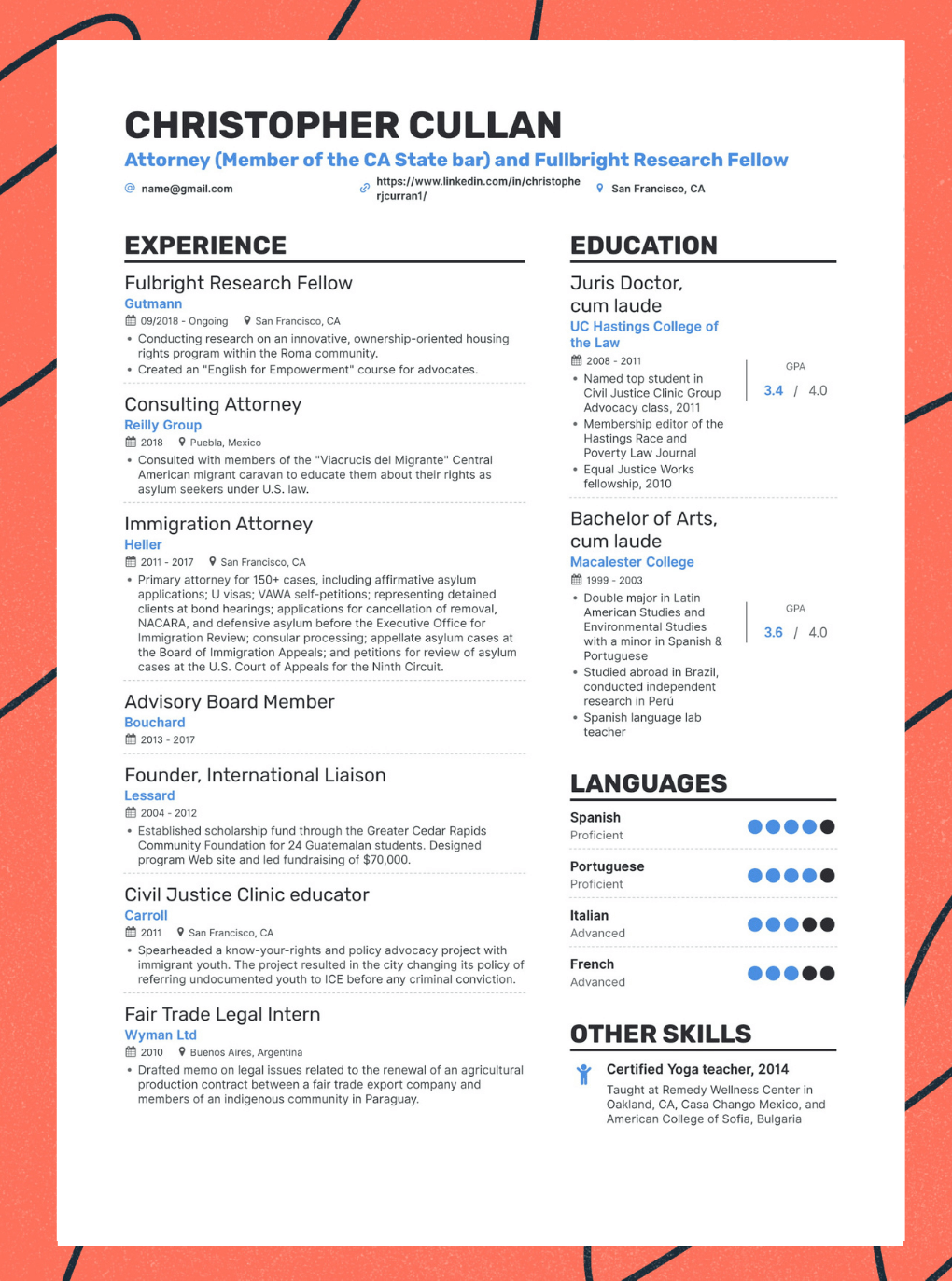
In cases where publications are in the process of being printed, but not yet available, list these as “in press”. This of course, if the article is relevant to the position you are applying for.
You could also follow the steps we gave you above.
While it is tempting to include every achievement in your life, it is important to maintain focus. Only include research and publications that demonstrate skills or show experience relevant to the position.
Your research and publications can help the Hiring Manager to identify you as a recognized expert in your field. That can only help you get the perfect job.
In this article, we gave you tips on how to list publications on a resume.
Here are the takeaways:
- If you have peer-reviewed publications include them in a separate section;
- If you have only one article, list it under the Education section;
- List publications with either MLA or APA style in your resume;
- List publications that are not published yet by writing “in press”.
*** What are your thoughts? Did you list your publications on your resume? Give us a shout-out in the comments below. We’d love to hear from you!

- Resume Guides
Can I Handwrite My Resume
What looks bad on a resume, how to list contract work on your resume, how long should a cv be, how to show security clearance on resume, robert scored a point against autism and found a job thanks to enhancv.
- Create Resume
- Terms of Service
- Privacy Policy
- Cookie Preferences
- Resume Examples
- Resume Templates
- AI Resume Builder
- Resume Summary Generator
- Resume Formats
- Resume Checker
- Resume Skills
- How to Write a Resume
- Modern Resume Templates
- Simple Resume Templates
- Cover Letter Builder
- Cover Letter Examples
- Cover Letter Templates
- Cover Letter Formats
- How to Write a Cover Letter
- Cover Letter Guides
- Job Interview Guides
- Job Interview Questions
- Career Resources
- Meet our customers
- Career resources
- English (UK)
- French (FR)
- German (DE)
- Spanish (ES)
- Swedish (SE)
© 2024 . All rights reserved.
Made with love by people who care.
Protect your data
This site uses cookies and related technologies for site operation, and analytics as described in our Privacy Policy . You may choose to consent to our use of these technologies, reject non-essential technologies, or further manage your preferences.
- Resume and Cover Letter
- How to List Publications on a...
How to List Publications on a Resume (with Examples)
8 min read · Updated on December 18, 2023

Showcase your qualifications for any position
For job seekers who want to make a great first impression on hiring managers, it's important to include the right kind of information on a resume. Of course, most people understand the need to include key contact details, skills, work experience, and notable achievements. But what if you've published research or other writings to your credit, that you feel can enhance your job search prospects?
In this post, we'll examine the types of published works that you may want to include in your resume and why employers need to see them. We'll also provide some important tips to help you learn how to list publications on your resume, along with some examples you can use as inspiration.
What are publications for a resume?
Depending on your chosen career, your resume-worthy publications may take a variety of forms. For example, if you're an Academic Researcher or Scientist, any published journal articles, research papers, books, or scientific treatises may count as worthwhile publication listings for a resume. Since most of these types of publications will be peer-reviewed, the quality of the work will often be taken for granted.
Marketers, professional writers, and those with similar careers can include book publications and online website publications.
How can you decide what types of publications to list in your resume?
Before you even think about including any publication in your resume, it's important to consider one main issue: relevance. Do you have any published material that's relevant to the job you're seeking? Relevance in this context doesn't necessarily mean that your publications line up in every way with your desired job, but the hiring manager should be able to easily identify some connection.
For example, if you're seeking a marketing position, your college physics research paper may not really be the best example of your work. However, a couple of published marketing research papers would be obvious choices for inclusion in your resume. In short, consider what you've published and then examine it with the prospective employer's needs in mind. If the piece showcases abilities and results that would spark interest in your candidacy, then add it to your resume.
Why do employers want to see your published work?
You might be wondering why employers even care about published works. After all, why bother to learn how to list publications on your resume if hiring managers have no interest in seeing them? Well, rest assured, if you're seeking a job in an industry that prizes research, academic thought, or specific skills that involve the creation of materials for publication, then any prospective employer is going to want to see examples of your past work.
That's why it's so important to know how to list publications on your resume - because it's the easiest way to demonstrate that you have the skills and experiences that you claim to possess. The inclusion of published works demonstrates that you have a solid foundation of analytical, research, and writing skills.
How to list publications on your resume
Once you've answered the question “should I put publications on my resume?” the next question to answer is “how do you put publications on a resume?” Don't worry! We have you covered there too.
The challenge of learning how to list publications on a resume can seem a little daunting at first. However, it's simple if you take it step-by-step. To help you with that process, we've compiled some great tips that you can use.
1. Decide where to put publications on your resume
There are two main options for including publications on your resume: within your education section, or in a separate section labeled Publications . Some general guidelines to help you determine which option is right for you are outlined below:
Education section . If you're an academic or scientist, include your published works in this section if you only have one or two publications, or if your only published works did not appear in a peer-reviewed journal. Others with published works in trade journals or online sites can also use this option.
Publications section . When you have several publications to your credit, it's generally best to add them to a separate Publications section. This compartmentalization can help to add gravitas to these achievements and make it easier for hiring managers to quickly locate that information.
If your publications are an important part of your qualifications, you may also want to include reference to them within your resume summary. One way to do that would be to select your most relevant or attention-grabbing publication and mention it within the last sentence of your summary paragraph.
2. Choose your citation style
It's a good idea to choose a specific citation style and use it as consistently as possible throughout your publications list. There are two commonly acceptable options when it comes to style - APA or MLA. The former is typically used for citing scientific and engineering publications, while the latter is generally used for citations to any publications in the humanities fields like history or philosophy.
APA example citation : [last name], [first initial]. [middle initial]. (year of publication). [article title]. [journal name] [volume number] ([issue number]) [pages].
MLA example citation : [last name], [first initial]. “[article title].” [journal name], [volume number], [issue number], [date], [pages]
Note that you may also want to include the URL of any website where the work is published if the publication is online. You can also use a simple format for listing published books:
[Your Last name, Your First name], [Book Title], [Name and location of Publisher], [Year of Publication]
Finally, if you have a mix of publications encompassing both technical and humanities-based works, or simply want to simplify your list, you can use this format:
“[Publication title]”, [Publisher name], [Date]
If you choose that last option, however, be prepared to provide a complete list of those publications with all relevant details if the employer asks for it.
3. List publications in reverse-chronological order
Since you will likely be using a reverse-chronological format for your resume , it's important to list your publications in reverse order too. To do that, simply cite your most recent published work first and then list the others in reverse chronology.
4. Verify the details of each publication citation
Always take the time to double-check your citations to ensure that all the relevant details are correct. That will ensure that you don't provide any unverifiable information, while also demonstrating your keen attention to detail and accuracy.
5. Consider relevance
Again, think about the relevance of each publication that you choose to cite in your resume. This is especially important if you have a long list of published works, since including them all could make it difficult for the most important works to stand out.
In addition, it's always a good idea to have your most relevant publications cited near the top of your list. If you have more recent publications that have little relevance for your current job search, you may want to consider omitting them to ensure that a more relevant work is showcased in that top spot.
6. Don't be afraid to include pending publications
If you've completed materials that are currently being reviewed for publication in a journal, it's acceptable to include those citations on your resume too. However, you should list those publications in italics, to indicate that they are not yet published. In addition, don't add details about the publisher.
Examples of publications on a resume
Naturally, it can be helpful to see some hypothetical examples of how to list publications on a resume. Below are several sample citations that you can use as templates or guidance while you create your own publication section.
Smith, J. “Analysis of the impact of wind turbines on migratory bird populations in the American Midwest”, American Journal of Bird Concerns, Vol. 2, Issue 19, 2012, 35-38.
Jones, T. J. 2021. Finding Meaning in a World Full of Ghosts. Journal of Modern Pseudoscience. Vol 3 (Issue 22) 56-72.
Presentation: Thoughts on Modern Fiscal Policy in the Age of Partisanship. Anytown Expo. 2022. Anytown.
Hines, T. “Probing Fake News' Prevalence, A Statistical Analysis”, Media Science, 2020. www.mediascience.com/probingfakenews/
Learn how to list publications on your resume to land more interviews
If including your publications in a resume is necessary to gain the right kind of attention from employers, then it's vital to do it right. By following the tips and recommendations in this post, you should be able to list publications in your resume in a way that bolsters your key qualifications for any job. In the end, that can be the best way to ensure that you make the right impression on hiring managers and earn more interviews.
Want to make sure that your listed publications are doing their job in your job search? Get your free resume review from our team of experts today to ensure that you're delivering the right message to prospective employers.
Recommended reading:
Tips to Create the Ultimate Winning Resume
100 Powerful Resume Adjectives that Can Help Make Your Resume More Compelling
How to Advance Your Career (plus 10 Insightful Tips)
Related Articles:
Do Hiring Managers Actually Read Cover Letters?
How to Create a Resume With No Education
Why You Lose When You Lie on Your Resume: Learning From Mina Chang
See how your resume stacks up.
Career Advice Newsletter
Our experts gather the best career & resume tips weekly. Delivered weekly, always free.
Thanks! Career advice is on its way.
Share this article:
Let's stay in touch.
Subscribe today to get job tips and career advice that will come in handy.
Your information is secure. Please read our privacy policy for more information.

Press Enter to search
How to List Publications on a Resume
Whether you’re applying for a job in academia or just want to show off your research skills or expertise, here’s how to format publications on a resume or CV.
a year ago • 4 min read
If you work in a writing or research-heavy field, you’re undoubtedly familiar with “ publish or perish .” Publications can help establish credibility, demonstrate expertise in your field, and show your research skills firsthand. But once you’ve done that, what comes next?
If you’re looking for a new job — or even considering one — the answer is, “add those publications to your resume or CV.” In this article, we’ll cover exactly how to do that, including:
- Where to put publications on your resume
- What publications to include
- The correct citation format to use
- Tips for highlighting specific contributions and accomplishments
Common mistakes to avoid
- The difference between a resume and CV (and how to list publications on each)
How to list publications on a resume
- Choose where to list your publications. Depending on how many publications you want to list, publications should be listed either in a dedicated Publications section or in a subheading within your Education section .
- Choose a format (more on this below) and use it consistently. Don’t switch between citation formats, even if they’re both correct. Consistency in citation format makes it easier for employers to read and compare publications and shows attention to detail and professionalism.
- List your publications in reverse-chronological order, with the most recent at the top.
- Cite the names of any authors in the order listed on the publication.
- Enter the name of the article, chapter, or book.
- Include the name of the journal, website, or conference where it was published.
- Add the date of publication.
How to list publications on a CV
- Create a section toward the end of your CV (after your education and professional accomplishments ).
- Give it a clear heading like “Publications.”
- Choose a citation style and use it consistently — generally either MLA or APA. List any relevant publications in reverse-chronological order, with your most recent publication at the top.
- Omit any publications that aren’t relevant (i.e. publications that are unrelated to the position you’re applying for or that have since become obsolete).
Examples of how to put publications on a resume
In your education section.
Your Education section is the best place to list publications if:
- You’re running low on space
- You only want to list one or two significant publications
- Your Education section is at the top of your resume (this is usually the case if you’re a current student, recent graduate, or career changer )
Here’s what it should look like:
In your Publications section
You should list publications in a dedicated Publications section if:
- You’re applying for a job where publications are expected and you want to make sure they stand out
- You’re using a CV instead of a resume
- You’re listing multiple publications
If you’re not sure if you’ve listed your publications correctly on your resume or CV, upload it to the tool below — it will provide feedback on whether you have chosen the appropriate section and format for presenting your publications.
The correct citation format for publications on a resume or CV
You should list publications on a resume or CV in either MLA or APA style .
- If the job description or application instructions specify a preference for a specific citation style, use that.
- If no preference is specified, either style is acceptable.
- Only use one style or the other. Never use a mix of both.
If you choose to use MLA style, use the following format:
[Last name], [First name] and [First name] [Last name]. "[Article title]." [Journal name] , [Volume number], [Issue number], [Year], [Pages]
For example:
If you choose to use APA style, use the following format:
[Last name], [First initial]. ([Year]). [Article title] . [ Journal name ], [Volume number] ([Issue number]), [Pages].
Tips for adding publications to a resume or CV
Which publications should you include on a resume or cv.
The short answer is: Anything you’ve published that’s relevant to the job you’re applying for.
The long answer is that resume-worthy publications can include:
- Any work you’ve published or are about to publish
- Peer-reviewed publications
- Academic books or book chapters
- Research papers
- Scholarly articles
- Conference papers
- Trade presentations
- Publications in an industry journal
- Newspaper or magazine articles
- Online publications
How to highlight your contributions
Don’t just expect your publications to speak for themselves. Actively highlight your contributions by:
- Indicating your role in the project
- Emphasizing your authorship position, e.g. creating a separate section for first author publications or bolding your name in the author list
- Including related accomplishments in your Work Experience section
- Listing any awards or honors related to your publications
- Including talks, presentations , or media coverage
DON’T include publications that aren’t directly relevant, especially if you’re applying for jobs outside academia.
DON’T forget to update your Publications section when you update your resume or CV. Check your citation metrics, add new publications, and remove old ones as they become outdated.
DON’T underestimate the value of collaborative projects. Even if your name is further down the list of authors, you can still list it (especially on an academic CV) along with accomplishments relating to that project.
DON’T skip the ethical considerations. Make sure you properly credit all authors (including sticking to the official order of authorship), avoid plagiarism, and adhere to the policies of the journal or publisher.
- Career Advice
Spread the word
How long do employers look at a resume, how to upload a resume to linkedin, keep reading, how to show bilingualism on your resume (with examples), oops what to do if there’s a mistake on your resume, getting the basics right: resume line spacing, subscribe to our newsletter.
Stay updated with Resume Worded by signing up for our newsletter.
🎉 Awesome! Now check your inbox and click the link to confirm your subscription.
Please enter a valid email address
Oops! There was an error sending the email, please try later

Thank you for the checklist! I realized I was making so many mistakes on my resume that I've now fixed. I'm much more confident in my resume now.

Publications On Your Resume: How to List Them

Getting published is a huge accomplishment. For some professions, published works are almost as important as job experience or professional certifications. So, if you’re seeking a position in academics, science, or other fields that put an emphasis on published works, by all means be sure to include details on your resume.
Not only will listing publications on a resume show potential employers that you possess writing and research skills , but it will also demonstrate your organizational skills, perseverance, and level of experience. Like a professional certification , publications will also display your knowledge of and dedication to your field.
Not sure how to add publications to your resume ? Or where to list them? We have some resume examples that show you how to do exactly this.
So, be sure to go over these examples before you use our online resume builder to put together a champion resume that is sure to put you in the running for the next position you seek.
This article includes:
Who Should List Their Publications on a Resume?
Some professionals who should list their publications on their resume include:
- Assistant professors
- Book authors
- Researchers
- Research scientists
- Research assistants
- Laboratory directors
- Marketing professionals
- Public relations professionals
What Kind of Publications Can You Add to Your Resume?
The types of publications that you would generally include on a resume are:
- Scientific journals
- Magazine articles
- Speaker presentations
- Research papers
- Newspaper features
Where Can You List Publications on Your Resume?
Typically, you would list publications on the resume in their own section , “Publications.” Or, perhaps “Research and Publications.”
This section is generally placed following the education section . However, it depends entirely on you and your situation when it’s time to decide where to put your publications on your resume.
Ordinarily, a resume is a one or two-page document , and if you can fit your publications within the body of the resume, that’s great.
If the position you are applying for puts more weight on publications , and you wish to include as many as possible to help your resume stand out and reflect your ability to assume the role for which you are applying, it is acceptable to have publications listed on a separate page.
Add publications under a heading “ Additional Activities ” if you have only a few but believe that listing them is relevant to the position you are seeking.
You might even list publications after the skills section , as published works reflect various skills. You can check out some resume examples to see what might work best for you.
Using APA and MLA Style to Add Publications to Your Resume
APA style (developed by the American Psychological Association ) is a writing style and format for academic documents such as scholarly journal articles and books in specific fields, such as psychology or engineering.
So, if you’re listing journal articles or books you authored or co-authored, they should be formatted as such:
Publications
- [Last name, First initial. Middle initial. (Year of publication). Book title: Subtitle. Location: Publisher.]
When listing books, the same format as above is used.
Note: When using APA style, only the first word of the title and not the entire title is capitalized.
MLA ( Modern Language Association ) style can also be used for resume publications. MLA is used mainly in fields such as literature and the humanities. MLA format looks like this:
- [Last name], [First initial]. “[Article title].” [Journal name] [Volume number]. Issue number: [Pages]
Book publications in MLA style follow this format:
- [Author’s name. _Title of Book: Subtitle. _Publisher, Year.]
Example of APA Style Journal Article and Book Listed on a Resume
A journal article listed on a resume in APA style would look like this:
- Parker, P. & Smith, S. (2018). A comparison of body structures of insects and arachnids. Journal of Insect Life, 147, 160-171.
For book publications , a listing in APA style would look thus:
- Freud, S. (2019). Cognitive development: a psychological overview. New York City: American Association of University Presses.
Example of MLA Style Journal Article and Book Listed on a Resume
Here is how to list publications on a resume when it comes to journal articles in MLA style:
- Kent, Clark. “The Origin of Superman.” International Journal of Comic Heroes, vol. 30, no. 2, 2016, pp. 100-106.
If you have books to list on your resume and are using MLA style, your publications would look like this:
- Campbell, Sebastian. Canine Metabolic Disorders: Obesity-related Metabolic Dysfunction in Dogs. Duke University Press, 2014.
How to Include Blog Publications on Your Resume
For blogs, if you are applying for a position that includes blogging and have experience in that field, then details can essentially be added in the Experience section. For example:
Conservation Blogger Today’s World
January 2020 – Present
- Research, write, and edit two blogs per day covering species extinction and environmental subjects such as climate change or pollution.
- Publish through a Creative Commons model, leading to re-publication in various social media platforms and online publications.
- Increased readership by 45% over a six-month period.
You can add additional information such as any awards your blogging might have garnered, or if your blogging allowed you to develop specialized skills, such as search engine optimization, site sharing, or bookmarking.
How to Include Presentations and Public Speaking on Your Resume
Being a keynote speaker or presenting a paper at a conference can also be included in a publications list on a resume.
To include a presentation or speech on a resume, you would start with the role you played, followed by the topic or paper title, the name of the conference or forum, and then the location and date of the conference.
Conference Keynote
- Presenter, “The Next Decade in SEO” Digital Search Habits, University of North Carolina at Chapel Hill, June 2020.
How to Include Research Publications on Your Resume
Did you complete an extensive graduate research project? Oversee research for a professional project? Have you collaborated with a research team in a professional setting to prepare a report?
Including research among, or in addition to, your resume publications shows potential employers your ability to:
- Gather and analyze data
- Apply critical thinking
- Communicate
- Pay attention to detail
- Effectively organize yourself and your material
- Problem-solve
- Work efficiently in a team
- Demonstrate technical knowledge
- Schedule and plan
You can put research into your publications section , add it under a skills section, or list it under your experience if the research was completed in one of your last positions.
Example of Research in the Experience Section of Your Resume
Let’s see an example you can follow to list your research experience on your resume:
English Department, University of North Florida
February 2021-December 2021
- Key participant in a research project on the works of Edgar Allan Poe.
- Analyzed his use of imagery and symbolism in selected stories and poems to prepare a paper intended for publication in major literary journals.
- Collaborated with other members of the research team to evaluate selected literary works and gather research from outside sources, including scholarly papers and reviews.
- Analyzed similar works of gothic horror by key authors of the same time period, who employed the use of imagery and symbolism to draw parallels.
- Prepared research findings in a 25-page report.
- Presented findings to heads of the English department.
We hope this post has helped you understand which publications to put on your resume, when, and how to do so.
Remember, use the ResumeGiants builder to help you list your publications correctly.
In addition to our free online resume builder , you’ll also find helpful resume templates that make it quick and easy to produce the type of polished document that will catch the eye of potential employers in any industry.
Related Posts
How to List Awards on a Resume Listing awards on a resume is an efficient way to demonstrate your skills and accomplishments to an employer, but you’ll want to make sure you do it right! Updated on August 23, 2023 How to List Awards on a Resume
How To Put a Fraternity or Sorority on Your Resume Want to show off your fraternity or sorority experience? Learn how to showcase your Greek life experience on your resume to get the job of your dreams. Updated on March 30, 2023 How To Put a Fraternity or Sorority on Your Resume
When and How to Add the Dean’s List to Your Resume Is being awarded the Dean’s List worth adding to your resume? Find out when and how to include it with our guide. Updated on October 4, 2023 When and How to Add the Dean’s List to Your Resume
- Career Development
How to List Publications on Your Resume: A Guide for Researchers (+Examples)

Job seekers whose experience includes research and publications often wonder how to include that information in their resumes. After all, few resume templates are designed to highlight such accomplishments, and most people are reluctant to significantly alter those widely-accepted resume formats.
So, how can people in the scientific, literature, or academic fields properly showcase their research and publications on a resume or curriculum vitae (CV)? We have the tips you need to properly document those important achievements and citation examples you can use as a helpful guide.
Why publications matter on a resume
If you have experience doing academic/scientific research or writing publications, then you have skills that set you apart from most job seekers. Your research and publications identify you as someone with clear writing skills.
They also demonstrate analytical skills – which employers tend to value highly – and a capacity for being a thought leader. Those qualities are important qualifications for anyone seeking a job in academia or any science and engineering field.
For published authors and writers, having material go through to publishing can speak volumes about your experience and the quality of your work.
Publications on a resume example
Regardless of which option you choose, it is important to use the proper APA formatting for publications when including your publications on your resume. Be sure to use a consistent format when listing publications and describe your research, focus, and efforts as briefly as possible. Consider the following examples.
Published article or paper
[Your Name], [Title of article], [Title of publication], [Publication date], [Pages]
Authored Book
[Your last name, Your first name], [Title of your book], [Place of publication and publisher], [Year published]
Your options for including publications on a resume
Fortunately, you have several options when it comes to listing publications in your resume. The option you choose will probably depend upon the nature of your research and publications and the type of position you’re seeking.
There are three main options for including these details in your resume in an organized manner: creating a separate section, using a summary, or documenting them on a separate page.
Option # 1: Create a separate section for your research and publications
One way to highlight your publications is to create a separate section for them.
(We wrote a good post here on what sections a resume should include )
You should only consider this option if you have a limited number of citations to list or if your work has appeared in important industry journal publications.
By separating them in this way, you can help to focus attention on these accomplishments. At the same time, that separation helps to ensure that your other skills and achievements are not overshadowed in any way.
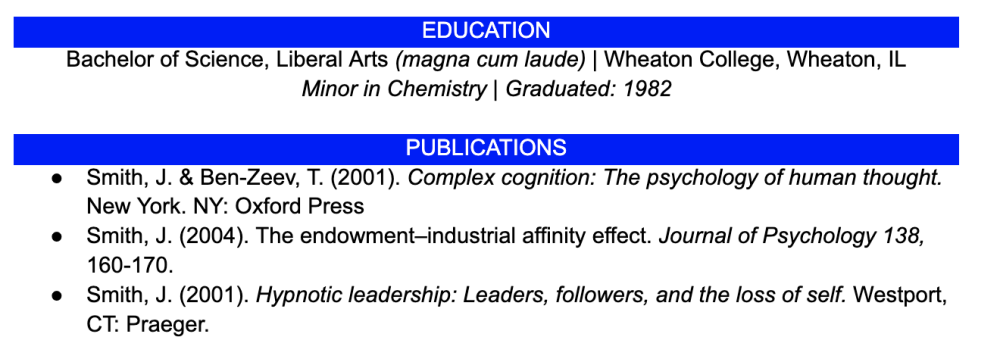
Option # 2: Using a summary for your publications
Another great way to showcase relevant publications in your resume is to include them in a short summary. This option is best used when the achievements are not crucial to landing a job. It's also a good option when there are only one or two citations to list.
Simply insert a bullet point or two at the end of your achievements section and include the appropriate details.
Option # 3: Create a separate page for your publications
If you have a substantial number of accomplishments that involve research and publications, you could consider a separate page for those details.
Simply create a list of these citations for a page titled “Publications” or “Research.” There, you can list all relevant citations in reverse chronological order. If you choose this option, be sure to mention in your cover letter that you've included the list.
What are research skills?
As we move on from talking about publications to discussing research, let’s first define research skills. Research skills are all those skills needed to investigate and analyze a subject and then communicate your findings to others. In short, there is no simple easily-defined skill that encompasses all these talents. Instead, your ability to research involves the effective use of a range of other skills, including
Critical thinking
Data interpretation
Information synthesis
Effective communication
Research skills are highly prized across a wide spectrum of industries. The fact is that researchers are invaluable for many employers and hiring managers. After all, new ideas often come only after an exhaustive analysis of existing practices. Is it any surprise, then, that many of the most innovative companies in the world look for employees who possess these skills?
The good news is that most of us possess at least some skill in researching. Unfortunately, too many of us don’t recognize those skills or why they matter to employers. Most of these skills relate to critical thinking in some way. They involve accumulating information and using it to draw reasoned conclusions. Naturally, those conclusions need to be conveyed to others with effective communication skills.
Research skills are among the most highly-prized transferable skills employers are looking for in today's competitive job market.
Employers value these skills because they are essential to progress. Innovation only comes from research and inspired insight. As a result, companies that rely on innovation to remain competitive tend to rely on employees who are talented researchers. Obviously, there are entire fields of industry that use researchers only for that purpose. In a more general sense, however, research skills are widely used by many different types of employees. And they use them in almost every industry in the marketplace.
How to list research on a resume
Including information about your research skills on a resume can be challenging because people perform research in a number of different capacities. Regardless of if you were the lead researcher or part of a team, it’s encouraged to include your research projects on your resume. You can detail how your efforts helped them move the project forward and what contributions you made.
Even if your findings weren't published, or are in the process of being published, you should include your work in research on your resume still. This is because the skills acquired during research are, again, highly prized by employers. It’s less about the result and more about what kind of professional qualifications your research efforts are able to embody.
Including research on your resume:
To describe your experience performing research on a subject, summarize your accomplishments in a brief section. You should include a description of your role in the research, the topic that you were exploring, and some information about your findings.
Example of research listed on a resume:
Economics Research Project, Dynamic University
Dec 2017 – Apr 2020
Key participant in research project examining blockchain technology’s potential impact on financial intermediation. Explored use case studies for cross-border payment systems, intrabank transactions, and microtransactions for e-commerce.
Designed model simulation to study blockchain-based payment system
Worked in tandem with Alpha and Delta Finance to create simulated intrabank transfers using digitalized tokens
Studied e-commerce script integration for cryptocurrency payments
Member of a 3-person team tasked with presenting findings to 2018 National Banking Technology Conference
You can also combine your research with other sections:
Research and Publications
Research and Professional Development
Educations and Research
Why the cover letter may be a superior choice
There are some very good reasoning for using a cover letter as a vehicle for talking about research and publication citations. That option can help you avoid confusion within your resume and keep the resume length under control. It can also help to ensure that your cover letter is more than just a rehash of your resume. Most importantly, using the cover letter in this way can help to establish your expertise right away.
If you have a lot of experience in research, it can help you save space on your resume too. Your resume can have lists of your participating research and publications, but that list doesn’t always represent your efforts well. In your cover letter, you can expand upon the specific professional skills that you developed from your experience.
Even though the cover letter is formatted differently than a resume, when including research and publications in a resume or cover letter, make sure you use proper citations and give credit where due.
Research and publications can land coveted interviews
While it is tempting to include every noteworthy achievement in your life, it is important to maintain focus and perspective. Only cite publications that enhance your qualifications or demonstrate skills relevant to the position. Anything relevant to your industry or skill set obviously falls into this category. Casual articles published in a hobbyist magazine probably don’t need to be shared.
However, your research and publications can help employers to identify you as a recognized expert in your field. That can only help to enhance your chances of landing a great job. So, choose your resume options carefully and make sure that you use proper citation formats to convey this important information to every prospective employer.
ZipJob’s team of professional resume writers knows how to properly showcase your publications on a resume to get past an ATS and impress a hiring manager.
Recommended reading:
10 Best Skills to Put on Your Resume
Resume Format Types: Examples & Which Option Is Best?
How to Include Research on a Resume
Emma Elizabeth, Resume Writer, Emma Elizabeth, Resume Writer
Emma is a certified employment specialist with over 6 years of experience in career mentorship and employment training. With an affinity for technical writing, Emma is passionate about developing training, policy, and procedure manuals. In 2020 she helped design Colorado’s first state-certified training program for people with disabilities entering the workforce.

Our resume services get results.
We’ve helped change over 30,000 careers.
Get a free resume review today
Our experts will review your resume’s grammar, layout, and ability to pass ATS — all free and delivered straight to your inbox.
PROTECT YOUR DATA
This site uses cookies and related technologies for site operation, and analytics as described in our Privacy Policy. You may choose to consent to our use of these technologies, reject non-essential technologies, or further manage your preferences.
Resume builder
How to List Publications on a Resume or CV
If your career path is related to science or academia, you need to know how to list publications on a resume or CV. Highlighting them is an excellent way to make your knowledge and accomplishments visible to recruiters and show off your writing and analytical skills, which can help you beat the competition and increase your chances of landing a lucrative job.
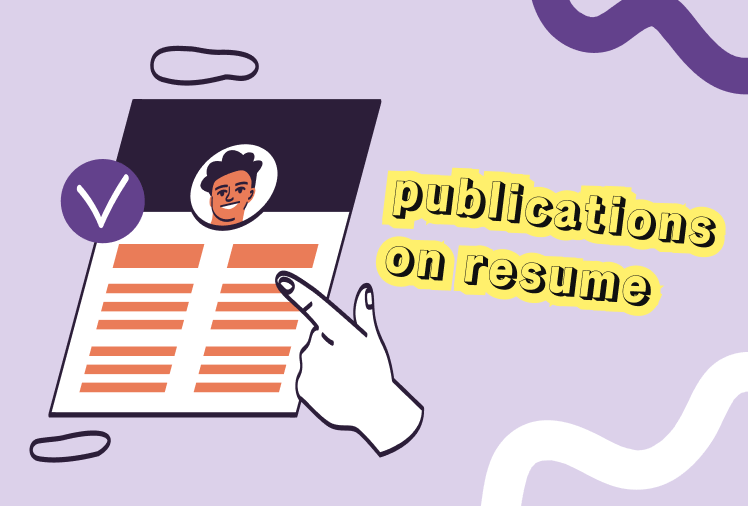
Table of Contents
What Publications to Add to Your Resume or CV
While you may feel tempted to list everything you have ever published online or offline, this is certainly not the best strategy. There is no room for inappropriate or questionable writing experience on your CV or resume as it can repel hiring managers and diminish your chances of scoring interviews.
You need to illuminate your publications the right way if you want to accelerate your job search when applying for any of the following academic or scientific positions:
- Research Assistant
- Research Associate
- Assistant professor
To begin with, to be included on your resume or CV, a publication should be relevant to your career and the job you are applying for. Second, it should be authoritative, which means you have enough experience in your specialist area and use only credible sources. Another best practice is to include only peer-reviewed articles since those demonstrate validity and reliability due to being critically assessed by experts in corresponding fields.
Here is a list of publication types that are the best fit for academic CVs and resumes:
- Scholarly articles or papers
- Academic books or book chapters
- Published research papers
- Research papers that are currently under review
- Conference articles, papers or presentations
- Publications or articles in trade association journals, magazines or periodicals
Also read: Cover Letter vs. Resume
How to Include Publications in a Resume
Employers want to see results on your resume, and impressive publications may open many doors across the entire academia. Here are a few tips on how to list publications on a resume:
1. Choose the most fitting publications
Remember, relevance is everything here. There is no need to include all your publications – an overstuffed resume is something that neither you nor the reader wants to see. Just focus on those that are up to date, illuminate your most appropriate skills and knowledge, and reflect your current career aspirations. A good idea is to add publications that have titles containing keywords relevant to the position you wish to land. If you have an important publication whose title is a bit less revealing, consider providing some explanations.
2. Decide on the format
While there are no universal rules for listing publications on a resume, it is essential that you check guidelines accepted in your professional field. You can choose a formal style or an informal one, but make sure to apply it consistently across your resume.
3. Use reverse-chronological order
Your most recent publications should go first. Then list the rest in descending order. This approach will help recruiters see that you are up to date with the latest trends in your research field.
If you want to add a publication to a resume, make sure to include
- the title of your publication, whether an article, book or chapter;
- the title of the journal/magazine/conference/book where your publication appeared; and
- the year it was published.
When deciding where to put publications on your resume, pay attention to how many of them you want to add. If there are only a couple of publications you want to include, you can list them under your Education section. Here is an example:
Education Colorado State University, Boulder, CO – May 2020 B.S. Computer Science – GPA 3.8/4.0 “Natural Language Processing: A Modern Approach,” Computer Languages & Systems (2020) “Artificial Intelligence on the Forefront,” Hardware and Software Impacts (2019)
If you want to add more than two publications, your best bet is to create a dedicated section for them. Here is an example for your reference:
Publications “Monetary Policy Aimed at Macroeconomic Stability,” Research in Politics and Economics, November 2022 “Economic Resilience during the COVID Pandemic,” Journal of Economics and Strategy, September 2021 “Top 10 Management Tools to Apply,” chapter from Management Strategy & Economics, 80–99, October 2020
How to List Publications on a CV
An academic CV should scream research, and adding your publications to it is pivotal if you want to achieve that goal. Here are a few guidelines on how to include publications in your CV when hunting for an academic or scientific job:
1. Create a separate “Publications” section
A dedicated “Publications” section is an important aspect of a well-crafted academic CV. Your writing experience should be easily located, and recruiters will use it to evaluate your professional expertise and achievements.
2. Choose the right style
MLA and APA are the most commonly accepted styles for listing publications on CVs. APA is more common in engineering and scientific papers, while the MLA format dominates spheres like humanities and liberal arts.
3. Include all relevant writing experience
Be sure to add all publications that are relevant to your research interests and academic career. It’s best when your most recent publications are the most important and relevant. This will show the reader that your career develops in the right direction.
4. Stick to reverse-chronological order
Make sure you start by listing your most recent publications first. Then proceed backward in time for every subsequent publication. This way, you will let the reader see your most up-to-date writing accomplishments first.
Depending on your type of work, you can use the following templates and examples for reference.
Here is how you can list a journal publication using the APA style:
Your Last Name, Your First Initial. Your Middle Initial. (The Year of Publication). The title of the article. The title of the journal, the volume (issue), the page range.
Williams, J. L. (2015). Recent Advances in Dog Nutrition. Journal of Animal Science, 20(1), 8-12.
Here are a template and an example on how to add a journal publication using the MLA style:
Your Second Name, Your Name. “Your Article’s Title.” The Journal’s title , the volume, the issue, the year of the publication, the page range.
Smith, Anna. “The Origins of Trade Issues.” International Journal of Economics, vol. 20, no. 5, 2021, pp. 90-96.
This is how you can list a book on a CV using the APA style:
Your Last Name, Your First Initial. Your Middle Initial. (The year of publication). The title of your book : The book’s subtitle . The Location: The Publisher of the Book.
Doe, J. O. (2020). Business and Uncertainty: Changes in Dynamic Markets. New York City: AUPresses.
You can use the template and example below for reference when listing a book using the MLA style:
Your name. The Title of Your Book: Its Subtitle. The Name of the Publisher, The Year the Book Was Published.]
Barnes, Alice. Linguistic Turns: The New Paradigms of Language History. Cambridge University Press, 2018.
Adding Publications to a Resume vs. Listing Publications on a CV
Both a CV and a resume are vital documents when it comes to a job search, yet they are different in nature, which results in different approaches taken by job seekers when listing their publications.
You create a resume to apply for a specific job. You tailor it to each position you are interested in and include only the most relevant skills, accomplishments and qualifications, so it is usually brief and straight to the point.
Resumes are used more often when hunting for a job in industry rather than in academia. This nuance results in publications being an optional entry on your professional resume and lack of a particular format for listing them.
Nonetheless, you may have authoritative publications that are highly pertinent to the industry work you want to be engaged in. In a case like this, listing them on your resume may skyrocket your chances of winning out the job competition. Your goal here is to help the recruiter see that you are the perfect candidate for the job, and an impressive publication demonstrates that you are respected in your field.
That said, you should only add those publications that are highly relevant to the position you want. While your other papers may be of high scientific value, your resume is a place where you should focus on highlighting that you can close a specific industry gap with your skills and experience.
A CV is mainly used when pursuing a career in academia. It is a more comprehensive document as it encompasses all your academic achievements and accomplishments. Since your publications allow your potential employer to evaluate how deep your knowledge in a particular scientific area is, they should shine on your CV.
Your CV is a universal, in-depth description of your career journey. It should be up to date and display your consistent progress. Therefore, you should include all publications that show that you are an expert in your domain.
Listing publications on a CV is a bit less flexible when compared to the freedom you enjoy when adding them to your resume. You are expected to follow a major style guide here, such as MLA or APA, depending on your area of expertise.
Resume & CV Publication FAQs
How to list co-authored publications.
If you want to add a publication that you have co-authored, add the names of its authors, separating each by a comma and adding “&” before the last name, and place your name in bold.
Here is how you can include a co-authored publication on your CV:
Roberts, C. C., Wilson, A. V. , & Garcia, L. A. (2015). The Origin and Purpose of the Human Decision System. Journal of Neuroscience, 23(2), 10-20.
How to add publications under review?
You are free to include pending work that is still being reviewed. Place it into italics, omit the journal you have submitted your paper to, and list it as “in press”. Be sure not to add publications that have not been approved.

Should online publications be included?
It is not recommended to include non-scientific or non-academic publications like blog posts and magazine articles in your CV or resume. However, if you want to add an authoritative online publication that highlights your research skills and academic interests, you can do so. Just make sure to include the corresponding URL after citing it using a format accepted in your field.
Listing publications on a CV is a must in academia, so it is essential that you make the most of the section in question: introducing your writing experience in a thorough and convincing way will help you advance your career and reach greater heights. When it comes to a career in industry, adding the right publication to your resume can also be a game changer: it will show hiring managers that you are a renowned expert that can push things forward and put you above other candidates.
Leave a Reply Cancel reply
Your email address will not be published. Required fields are marked *
Save my name, email, and website in this browser for the next time I comment.
A Guide to Listing Research and Publications on your Resume or CV
With there being only so much room on your resume or CV, space can get taken up very easily…
Making you wonder…
Should all my publications and research get listed on my resume?
It’s a big question with a simple answer.
If you’ve got work or papers that:
Then you most definitely should include them on your resume. You want your prospective employer to be able to see exactly what you’re capable of and the actual work you’ve done is perfect.
You want to make it easy for the person thinking about hiring you to see your range of experience and knowledge in your field; this is what citing your published work will do.
Papers will also demonstrate some soft skills like good writing and the ability to analyze data .
When you’ve got a good library of publications, how do you choose which ones to include?
What format should you use in your citation?
For answers, you’ve come to the right place.
We’ve pulled together the rules and tips you need for adding your publications to your resume or CV to help get things perfect.
The right time to add publications to a resume or CV
The first thing you need to do is assess the job role that you’re applying for and decide if your published work is relevant.
You only have a small amount of space and it gets full, quickly.
The best advice you’ll get is to only include publications that match the job you’re applying for and support the points you’re making elsewhere in the resume.
To make it easy to follow, here are the main times you’re going to find listing your publications to be useful on your resume or CV:
Deciding which publications to use on your CV or resume
Your first instinct is probably to add everything you’ve ever achieved in life, but you need to make sure you’re targeting your information to the person reading your document.
- When you have papers that confer kudos, make you look more qualified, or demonstrate key skills for the role, these are the papers that you include.
- When you’ve got industry-specific publications or ones that really highlight a skillset, make sure you add them on.
- Articles about hobbies or casual subjects probably aren’t going to impress the hiring manager and can be omitted.
With all of this to think about, you’re probably thinking about which publications are the right ones to add to your resume or CV.
For your curriculum vitae , note down anything that has authority in its field that has been or will soon be published.
These could be:
- Books for academia
- Journal and publication research papers
- Not-yet-published research papers
- Articles of a scholarly nature
- Papers presented at conferences
The right type of publications to list on your resume include:
- Presentations at trade conferences
- Chapters of books or whole books
- Trade association magazine articles
- Industry journal publications
Pro-Tip Not every publication belongs on your CV. Don’t include blogs, website content, or nonscientific or magazine articles. Also, if your thesis didn’t get published, it belongs in your “ Education ” section.
Why are resumes and CVs different for listing publications?
The question of the difference between a CV and resume should probably be tackled first!
Your resume contains a summary of your skills and experience in brief, covering just one or two pages.
Conversely, your CV is packed with detail and will run well over two pages in length.
You should be writing a different resume that’s specific to each position you’re applying for, whilst your CV remains static and you tailor your cover letter for each job you go for.
How does all of this affect how you show your published work?
This breaks it down for you:
Getting to the nitty-gritty…
Examples for listing publications on a resume
You’re here because you’re wondering…
Let’s answer that for you…
We’re going to give you the rules you need to follow for citing publications on your resume. It includes the order you need to use and the simple structure to follow to give you the perfect Publications section of your resume:
- Use a dedicated section called “Publications” so it’s easy for the recruiter to find
- Order it using reverse chronology , meaning you start with the most recently published and give each publication its own bullet point. Pick out your recent and relevant works so you can conserve space for all the other important things
- Pick the right style for your list. You don’t need to follow MLA (Modern Language Association) or APA (American Psychological Association) styling, rather you can make a list that covers the title of the work, where it was published, and the date it was featured. As an example: “Components of Neo-gothic Churches in Nineteenth-Century England” British Journal of Architecture, June 2018
Pro-Tip APA style is a writing style and format for academic documents such as scholarly journal articles and books. It is commonly used for citing sources within the field of behavioral and social sciences. It was developed by The American Psychological Association. MLA style is the leading style of documentation for literary research, as well as academic papers in the humanities field. It was developed by The Modern Language Association.
For including a written publication, it should look like this:
- Title of article or chapter, then the name of the journal/magazine/website
- Last name of the author, then first and middle names or initials
- Publication year
- Issue or publisher’s number, and volume and page numbers where applicable
- If the paper is available online, be sure to add the URL too
To cite a paper presented at a conference:
- Note your role, such as presenter, panelist, or keynote speaker
- The topic or title that was discussed
- Conference or forum name
- Where and when the presentation took place
Imagine you’re looking for a SEO consultant role and the skills you need to be showing are around SEO.
This is an example of how you’d cite relevant publications for these key skills:
- Panelist: “Native SEO and How to Host It” HostCon, 2019
- “SEO in the Next Decade” Internet Trends, June 2019
- “Best Advanced SEO Techniques” Content Guru, Turin Publishing, Dec 2018
- “Hold the Front Page: Modern SEO” Searchzone, Feb 2018
Want to whip up your resume whilst dinner is cooking? Use our resume builder to easily make an effective resume. We’ve got ready-made content that you just click to use. Check out the template and choose the right one to make your resume shine. Browse examples 👈
Examples for listing publications on a CV
We’ve already established that…
Your CV, or curriculum vitae, is what you use instead of a resume in the world of academia.
Rather than picking out the best bits of your publication history for your resume, on your CV you get to show absolutely everything you’ve had published during your career, except obsolete one.
There are a few different things to consider when you’re formatting your publications to go on to your CV :
- Have the right format. With only a few publications to cite you can just add a section called “Research and Publications” within your CV, when your list is more comprehensive you’ll need to use dedicated pages for your citations
- Be consistent with your style of citations , whether you choose to use MLA or APA. A general rule of thumb is that humanities fields like languages, social sciences, and philosophy generally use MLA whilst science and engineering fields tend to opt for APA style.
- Go in reverse chronological order starting with your most recent published work and go back in descending order, all the way back to your first published article
- Don’t refer to publications that are now obsolete , you’re fine to ignore things that have been superseded or aren’t relevant to your job or field any more
- Note work that’s yet to be published but is being peer-reviewed at the time you’re writing your CV. Format these papers in italics and don’t include the name of the journal you have sent them to.
- Highlight your byline when you have co-authors or collaborators by putting your name in bold, remember not to miss out on anyone’s name
Here’s a guide to the different styles that you may be expected to use:
To give you some examples of what your listed publications would look like based on the type of work and the style you decide to use:
Pro-Tip Make sure you keep your list up to date as your career progresses and you get more articles, books, or presentations published. Each time something new goes live, add it to the top of your CV’s Publication and Research section.
When you have publications to cite on your CV or resume, it shows that you have skills, knowledge, and interest in your field. A potential employer will only see this in a positive light; they want you to be engaged in the work that you do.
It’s really important that everything that you include about your published history is correct and up to date, as well as relevant.
You can add publications to your CV or resume in a number of ways, depending on your field and purpose.
To be doubly sure that you’ve got it, here’s how to write publications on a resume and CV:
Publications on your resume :
- Put them in a separate section called “Publications”
- Include each publication in a new bullet point
- List the year and title
- Add the name of the magazine, website, or journal
- Only include publications that are relevant to the job you’re applying for
For your CV, usually, you'd include all your academic publications.
Publications for your CV :
- Include all of your academic publications
- Choose a citation style for your list and stick to it
- Start with the most recent publication and work backward
- Bold your byline when you’ve shared credit
- Don’t use outdated, disproved, or obsolete works
However, you choose to format your list, make sure that it looks tidy and well organized so any hiring manager knows exactly what they’re looking at.
Create my resume now 🔥
If you have licenses or certificates you want to put on your resume, read this article to create an effective certifications section.
Does volunteer experience require resume? How to describe voluntary roles? Volunteering is valuable so check out how to write up your experience in resume.
- Resume Templates
- Resume Examples
- Create a Resume
- Resume Writing
- Cover Letter Writing
- Career Blog
- Resume vs CV
- Resume Samples
- Product Updates
- Special offers
- [email protected]
Publications on the Resume
How to include your academic and professional publications.

Certified Professional Resume Writer
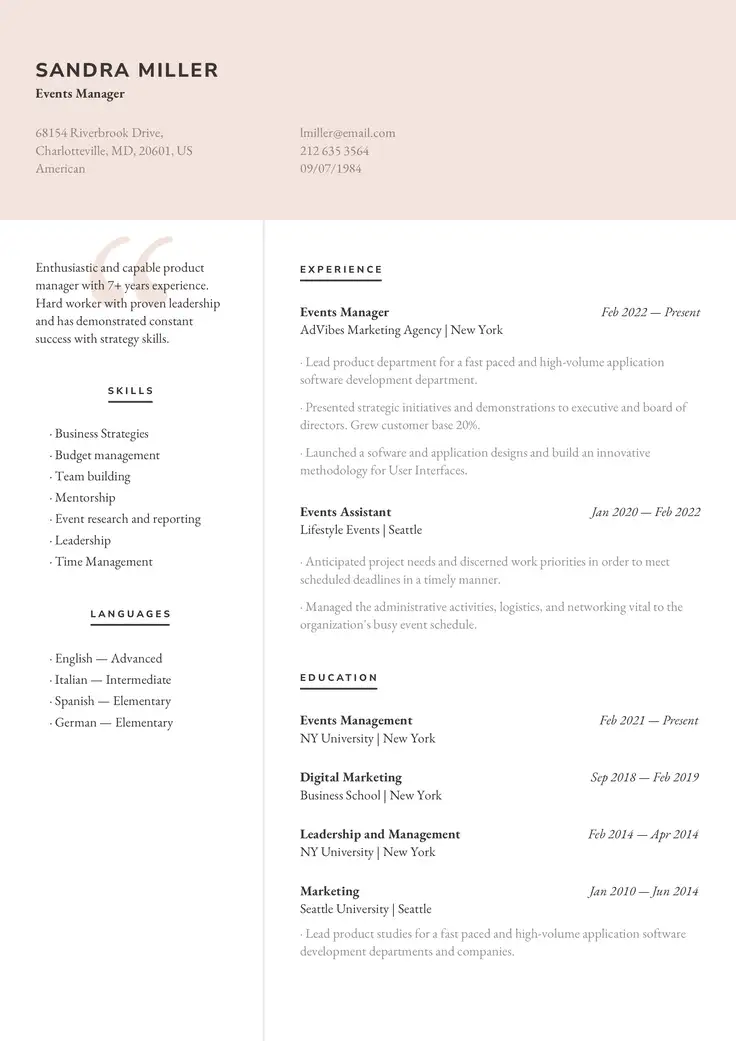
Listing publications on your resume can give you the competitive edge you need in the job market. Publications demonstrate your expertise and commitment to your field to potential employers.
By including them, you not only highlight your experience but also showcase your ability to conduct research, contribute to the advancement of knowledge, and communicate your findings effectively.
For professionals in academia, publications are especially crucial, as they exemplify your scholarly achievements and research impact.
In this article, you’ll learn :
- The different kinds of publications you should include in your resume
- How to list publications on your resume for impact
- What elements to consider when listing publications
Let’s get started!
What Kind of Publications Can You Include in Your Resume?
You can feature different types of publications on your resume, ranging from those with a broad readership, such as blog posts, to more specialized pieces, such as academic or scientific publications:
- Press publications or citations
- Books and e-books
- Industry journal publications
- Trade association magazines
- Science articles
- Research publications
- Other academic publications
While blogs can be a valuable asset, you should carefully evaluate if your blog content is relevant to the position you’re applying for. It’s also equally important to ensure you don’t include any content that contains errors or incorrect information.
Any publications cited on a resume should always be relevant and accurate.
A curious hiring manager is very likely to examine the publications you listed on your resume. Recruiters typically pay attention to your writing style, the topics you address, and the strength of the arguments you present to better assess your suitability for the role.
Use our step-by-step online resume builder for additional tips and guidance. Craft a powerful resume that includes your publications and gets you the job you’re looking for.
Key Elements to Consider when Adding Publications to Your Resume
When it comes to listing publications on your resume, it’s important to consider the industry and the job you are applying for.
Typically, professionals in academia, public relations, and marketing include publications in their resumes. However, these are particularly important for scientists too.
To make a strong impact, ensure you take the following elements into consideration :
- Relevance : Prioritize the publications that are most relevant to the position you are applying for. This could include research papers, articles, or books that demonstrate your expertise in the field.
- Chronological order : List your publications in reverse chronological order, with the most recent ones first. This allows employers to see your most recent work and track the progression of your career.
- Thorough citations : Include complete and accurate citations for each publication, including the title, authors, publication name, date, and any relevant page numbers. This helps prospective employers verify your work and provides them with additional context.
- Context : For each publication, briefly describe its significance or impact. Explain any awards or recognition it has received, and highlight how it relates to the job you are applying for. This will help employers understand the value and relevance of your work.
- Formatting : Maintain a consistent format for all your publications. Use the same citation style throughout and ensure that the formatting is clean and professional.
Remember, the goal is to display your expertise and demonstrate your ability to contribute to the company or organization. Organizing and presenting your publications effectively is essential to make a strong impression on prospective employers.
How to list publications on a resume
If you have printed work that you want to include, there are several ways of documenting publications on a resume to pick the curiosity of hiring managers.
Take a look:
Structure for Written Publications
- Author’s last name, author’s first and middle names or initials Title of article/chapter + name of journal/magazine/website etc.
- Year of publication Publishers or issue number + volume number + (if applicable) page numbers Remember to include the URL if the publication is online.
Structure for Presentations/Conferences
- Role e.g. presenter; panelist; keynote speaker.
- Title/topic discussed.
- Forum/conference name.
- Date and location.
Publication Categories on Your Resume
Categorizing your publications on your resume is an effective way to organize and present your resume in a clear and structured manner. Grouping your publications into specific categories helps you emphasize different aspects of your research and showcase your experience in various areas.
Find below several publication categories you should consider:
- Research papers : Shows your talent to conduct rigorous research and contribute to the academic community.
- Conferences : Features your ability to disseminate your findings and engage with peers in your field.
- Authored or co-authored books : Highlights your involvement in longer-form academic or professional publications.
- Journal articles and magazine features : Ideal to demonstrate your ability to communicate complex ideas to a broader audience.
- Technical reports and whitepapers : Showcases your capacity to effectively communicate technical information and expertise.
Remember to tailor these categories to align with the job application and the skills required for the position.
By categorizing your publications, you can provide prospective employers with a clear overview of your research and accomplishments in a way that is easy to navigate and understand.
Where to Put Publications on Your Resume
When it comes to including publications on your resume, there are a few options for placement depending on your preference and the structure of your resume:
- Create a separate publications section: If publications are a significant part of your academic or professional profile, it may be advantageous to create a separate section specifically for your publications. This allows you to place your research and accomplishments prominently. Add this section after your education or experience section, depending on its significance.
- Include publications within relevant sections: You can also integrate your publications within relevant sections of your resume. For example, if you have published research papers related to a particular job application, include those publications within the relevant education or experience section.
- Placement within education section: To highlight your research and academic achievements, include these under the corresponding degree or program within the education section.
- Placement within experience section: If your publications are closely tied to specific professional experiences, you can include them within the corresponding work experience entry. Recruiters will be impressed by your ability to apply your research and contribute to your field in a practical setting.
When deciding whether to create a separate section or integrate publications within other resume sections, consider the significance of your publications to the position you are applying for.
If your publications are highly relevant and demonstrate your expertise in the field, a separate section can help make a strong impact.
However, if your publications are not the primary focus or if they are closely tied to specific experiences or educational achievements, integrating them within the relevant sections can be very effective without cluttering your resume.
Ultimately, the goal is to make your publications easily accessible and highlight their relevance to potential employers. Think about the overall structure and flow of your resume to determine the most suitable placement option for your publications.
Unpublished Works
Including unpublished works on your resume requires careful consideration to accurately represent your ongoing research and achievements.
Here are some tips to present your unpublished works effectively:
- “In Press” status : If you have works that are currently in the process of being published but are not yet available, list them as “in press” on your resume. Include as much information as possible, such as author names, the type of publication, name of the publication, and any known issue or volume numbers.
- Avoid unapproved publication s: Under no circumstances should you include publications on your resume that have not been approved or accepted for publishing. Only include works that have gone through the necessary review and acceptance process, as this reflects your credibility and ensures you are not misleading potential employers.
You can accurately represent your unpublished works and maintain professional integrity on your resume by adhering to these guidelines.
It is crucial to provide comprehensive and accurate information about the status of your works, enabling employers to assess your potential contributions to their organization.
If you’re still unsure as to whether you should include publications on a resume , it may be useful to review the different resume templates to see if a publications section is ideal in your career situation.
How to List Publications on a CV
Academic positions often require a thorough evaluation of an applicant’s research experience and scholarly activities. Hiring committees and academic institutions need to assess an individual’s track record of research, publications, and contributions to their field.
A CV allows applicants to present a detailed overview of their academic accomplishments, such as the publication of research articles in peer-reviewed journals, conference presentations, and other research-related activities.
Establish a separate section on your CV specifically for your publications. Place this section after your experience and education sections and choose only one citation style.
Below are examples of publication citations in different styles :
- APA Style :
Smith, J., & Johnson, A. (2022). The Importance of Teamwork in Project Management. Journal of Project Management, 15(3), 45-60.
- MLA Style :
Smith, John, and Amanda Johnson. “The Importance of Teamwork in Project Management.” Journal of Project Management 15.3 (2022): 45-60.
- Chicago Style :
Smith, John, and Amanda Johnson. “The Importance of Teamwork in Project Management.” Journal of Project Management 15, no. 3 (2022): 45-60.
Publication Format Examples
The examples in this section cover different categories, including keynote speaker appearances, written publications, and digital publications, providing you with a clear understanding of how to feature your publications.
Use these samples as a guide to highlight your research contributions and expertise effectively:
- Keynote Speaker Appearances :
Smith, J. (2022). “Emerging Trends in Artificial Intelligence.” Keynote Speech presented at the International Conference on Technology Innovation, New York, NY.
- Written Publications:
Johnson, A. (2021). “The Role of Leadership in Organizational Change.” Journal of Organizational Behavior , 15(2), 78-95.
Johnson, A., & Smith, J. (2023). “E-commerce in plastics manufacturing.” American Plastics Foundation Monthly . 312: 111-117
- Digital Publications:
Smith, J. (2020). “10 Tips for Effective Social Media Marketing.” Digital Marketing Magazine . Retrieved from https://www.digitalmarketingmagazine.com/article/10-tips-for-effective-social-media-marketing .
- Presentation:
UX Research and Design in Online and Distance Learning . The UX Conference . 2016. London.
By following these examples, you can effectively feature your publications on your resume.
Please note that the specific format and details included may vary depending on the style and conventions of your industry or the specific job you are applying for.
Adapt these examples to suit your needs and ensure they align with the requirements of the position you are targeting.
To simplify the process of including publications on a resume , try our online resume builder . It offers on-the-go tips and practical examples to guide you craft this less known resume section.

Struggling with Resume Writing?
Ease the process with our templates
Explore Jobs
- Jobs Near Me
- Remote Jobs
- Full Time Jobs
- Part Time Jobs
- Entry Level Jobs
- Work From Home Jobs
Find Specific Jobs
- $15 Per Hour Jobs
- $20 Per Hour Jobs
- Hiring Immediately Jobs
- High School Jobs
- H1b Visa Jobs
Explore Careers
- Business And Financial
- Architecture And Engineering
- Computer And Mathematical
Explore Professions
- What They Do
- Certifications
- Demographics
Best Companies
- Health Care
- Fortune 500
Explore Companies
- CEO And Executies
- Resume Builder
- Career Advice
- Explore Majors
- Questions And Answers
- Interview Questions
How To List Publications On A Resume Or CV (With Examples)
- How To Write A Resume
- Resume Skills Section
- Resume Objective Section
- Career Objective Section
- Resume Reference Section
- Resume Summary Section
- Resume Summary Example
- Resume Interests Section
- Address On Resume
- Relevant Work Experience
- Anticipated Graduation Date On Resume
- Education Section On Resume
- Contact Information On Resume
- Statement Of Qualifications
- How To List Publications On Resume
- Accomplishments On Resumes
- Awards On Resume
- Dean's List On Resume
- Study Abroad On Resume
Summary. If you are the author of publications, you can showcase them to employers on your resume or CV. Whether or not you have publications to list will depend on your work or education history.
Including publications on your resume is not common, and you likely won’t see it on many resume templates unless you’re looking for something very specific. Including publications is very specific and often used by academics, public relations , or marketing professionals.
The addition of publications isn’t just for those looking for roles in academia or a scientific profession. If you have writing work that is suitable for the job at hand, listing it on your resume could help you stand out against other qualified candidates .
However, if the publications are not relevant to the job at hand, it would be more of a harm than a help to include them on your resume.
Key Takeaways
Adding publications on a resume is a specialized qualification, usually ony for academia, marketing, or a writing position.
Publications should be listed in reverse chronological order, avoid out of date articles, works not relevant to the position, and follow proper formatting guides.
Published works to include a resume or CV include: books (academic and not), research papers, scholarly articles, trade association magazine articles, and conference presentations.

What Publications Should You Include on a CV?
Why is it important to list publications on a cv, how to list publications on your cv or resume, what should a publication list look like, publication list examples, what is a curriculum vitae (cv), update your resume now to get your next job faster, publications on resume faqs, final thoughts.
- Sign Up For More Advice and Jobs
Since there are various publications out there, you may be uncertain about which ones to include on your CV. Any authoritative work should absolutely be included whether it has already been published or in the process of being published. These might include:
Academic books. An academic book can take many forms, especially since print formats are now being accompanied or replaced by digital. Typically an academic book is a long-form publication and is the result of in-depth academic research that makes an original contribution to a specific field of study.
Journal published research papers. Typically present in academic publishing, a research paper is usually an academic work published in an academic journal. The paper will include the results of research or review existing research results. Like academic books, these can come in print or digital formats.
Soon-to-be published research papers. If the research paper you have started researching or are in the process of writing, you should still include these on your CV. Despite not having been published, it’s still important to note the work and research you are putting into the research paper.
Scholarly articles. Whether your article was solicited or unsolicited it would have to go through a peer review and can be subject to review by outside scholars, depending on the editor ’s preference. These articles are massive accomplishments as the peer review process can take up to several months to complete.
Conference papers. Conference papers are typically a collection of academic papers published for a specific conference or workshop. These can include contributions from other researchers attending the specific conference it’s intended for.
For your CV, don’t include works such as blog posts, websites, or anything published outside of scientific publications. If you have publications you’re considering adding to your resume, they should fit into one or more of these categories:
Conference presentations. If you have been asked to speak at a trade conference for your specific industry, chances are you’ve put together a specific presentation that can be used for different conferences or shared with participants.
Books. If you have published a book or even specific book chapters that have relevance to the job you’re applying for, this can be included on your resume as well.
Trade association magazine articles. If you have written and published an article in an industry trade association magazine, you should list these on your resume as well.
Industry journal publications. Similar to articles but certainly more in-depth, publications for industry journals can also be listed on your resume.
It is important to list publications on a CV because publications arm you with credibility when you begin applying or interviewing for a new job . Publications on your CV can help prove to your potential employer that you have experience and knowledge in a particular area.
It also shows that you’re a go-getter who takes the initiative and isn’t afraid of rejection. Your publications can show your writing and analytical skills , which is beneficial for applying for academic jobs.
Listing your publications on a CV also allows you to remain humble when it comes to your accomplishments. Rather than walk into an interview with a laundry list of your publications and a description of each, you can simply list them on your CV for the potential employer to read through. This allows them to identify the publications they take an interest in and craft specific questions for you regarding this information.
Listing them on your CV also allows you to keep all of your credentials and accomplishments organized and accessible from one place. Putting together all of the things you have accomplished over any specific period of time may give you the push you need to pull ahead of other candidates interviewing for the same job .
The most important thing to include in your CV or resume is your publication’s title and where it was published. This information allows the recruiter or potential employer to see what topic you’ve written about and access the publication if necessary.
When you list your publications, formatting is key. Here are recommended questions to ask yourself for resumes.
Do you have a dedicated publications section? Just like you have with your work experience and education, consider creating an entirely new section for publications.
Are your publications in reverse chronological order? Be sure you list your publications with your most recent one first, following in reverse chronological order, with only the relevant publications listed.
Have you styled your list? Since the resume is less formal than the CV, you can simply format and list the work’s title, publication name, and date. Keep things consistent for a similar style and feel to your other sections.
For a CV, the formatting and list is a bit more complex. CVs are longer and go into greater detail, so your publications references should be more fleshed out as well.
Ask yourself the following questions:
Is your list formatted? If you have a few different publications you’d like to list, be sure to use bullet points under a dedicated headline such as “Publications.”
Are you using a consistent citation style? MLA or APA styles are appropriate here. Employers will take this into account if you list your publications, so be sure to choose a citation style and use them throughout your entire resume.
Are your publications in reverse chronological order? Be sure you list your publications with your most recent one first, following in reverse chronological order .
Have you omitted outdated publications? Don’t include any publications that might be outdated, are not relevant, or are no longer useful in your specific industry or for the job you might be applying for.
Have you included in-progress work? As mentioned above, don’t shy away from including pending published works. If your publication is still in peer review or in the acceptance process, you can still list them, but leave out the name of the journal you’ve submitted to.
Have you given yourself enough credit? Normally publications will have more than one author. It’s fine to list your co-authors, but be sure your name is bolded or stands out in some way on your resume.
Then again, there’s one more thing you can do.
Make a new resume and get more interviews.
Plus, a great resume will give you an advantage over other candidates. You can write it in our resume builder here. Here’s what it may look like:
Here are a few things to keep in mind when listing publications on your CV or resume, depending on the style you’d prefer to use or what your industry standard requires.
For written publications, be sure to include the following: Author’s last name, author’s first and middle names or initials Title of article/chapter and name of journal, magazine, or website Publication year Publishers or issue number and volume number and page numbers (if applicable) Include the URL if the publication is online For presentations/conferences, be sure to include the following: The role, e.g., presenter , panelist, or keynote speaker Title and topic discussed Forum or conference name Date and location
Here are a few different examples of how this could look on your resume.
Journal Article (Print) Jacoby, W. G. (1994). Public attitudes toward government spending. American Journal of Political Science , 38(2), 336-361. https://doi.org/10.2307/2111407 Chapter in Printed or Online Book Ray, R.B. (1985). A certain tendency of the Hollywood cinema, 1930-1980. Princeton University Press. Magazine Article Luckerson, V. (2014, January). Tech’s Biggest Promises for 2014. TIME . https://content.time.com/time/magazine/article/0,9171,2161683,00.html Article with Multiple Authors Kafer, Julien, and Walker, Marcella. ‘Native fungi of Colorado .’ Denver Nature Journal. Volume 3: pages 5-8. 2019.
A curriculum vitae, commonly known as the CV , is a comprehensive document that outshines a resume. It helps to elaborate your skills and expertise beyond the basics of education and work experience . This document is meant to be much longer and more detailed than the traditional resume, typically elaborating on achievements, awards, honors, and publications.
CVs are most popular among academics, and including your published work is an important section of this document. Typically graduate students will have a variety of published works that are important to higher-education establishments. However, CV’s can be used in many different industries, including academia, medicine, teaching, and research .
The main difference between a CV and resume is the length. The CV is meant to be a static document, meaning it shouldn’t be altered to fit different positions like a resume . The CV should be a detailed overview of the accomplishments and credentials you’ve built throughout your professional or academic experience.
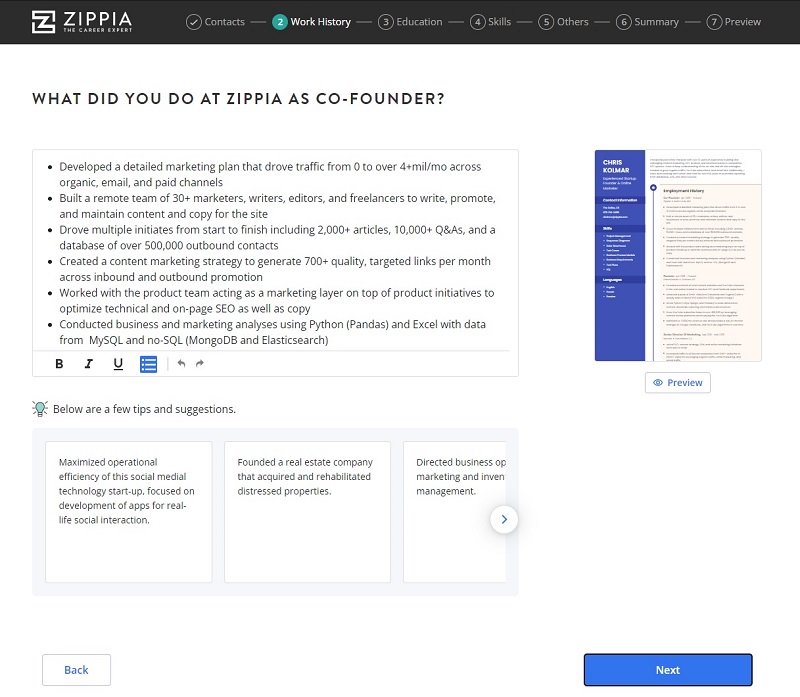
Can listing publications on a resume help me get a job?
Yes, listing publications on a resume can help you get a job. Particularly if you are applying to positions in the academic field, including publications on your resume can help you stand out.
Even if you are not specifically applying to academic positions, listing publications on your resume can demonstrate your accomplishments and boost your credibility.
Should I include every publication I have on my resume?
No, you should not include every publication you have on your resume. As with any other section of your resume, the publications section should only list relevant information. Tailor your resume to each specific application to make sure that the publications you choose fit the position.
Of course, these are just a few examples of how various publications can look. Depending on your specific type of publication, yours might look slightly different. It’s always a good idea to look at industry-specific examples of how this might look.
If you can ask a colleague or friend to take a look at publications listed on their resume, that’s a great starting place to help tailor your own CV or resume.
University of Missouri – How to Put Research on Your Resume
How useful was this post?
Click on a star to rate it!
Average rating / 5. Vote count:
No votes so far! Be the first to rate this post.

Caitlin Mazur is a freelance writer at Zippia. Caitlin is passionate about helping Zippia’s readers land the jobs of their dreams by offering content that discusses job-seeking advice based on experience and extensive research. Caitlin holds a degree in English from Saint Joseph’s University in Philadelphia, PA.
Don Pippin is an executive and HR leader for Fortune 50 and 500 companies and startups. In 2008, Don launched area|Talent with a focus on helping clients identify their brand. As a Certified Professional Resume Writer, Certified Digital Career Strategist, and Certified Personal Branding Strategist, Don guides clients through career transitions.
Recent Job Searches
- Registered Nurse Jobs Resume Location
- Truck Driver Jobs Resume Location
- Call Center Representative Jobs Resume Location
- Customer Service Representative Jobs Resume
- Delivery Driver Jobs Resume Location
- Warehouse Worker Jobs Resume Location
- Account Executive Jobs Resume Location
- Sales Associate Jobs Resume Location
- Licensed Practical Nurse Jobs Resume Location
- Company Driver Jobs Resume
Related posts

Functional Resume: Examples And Tips

Resume Pictures: Should You Put A Picture On Your Resume?

Creative Resumes (With Examples)
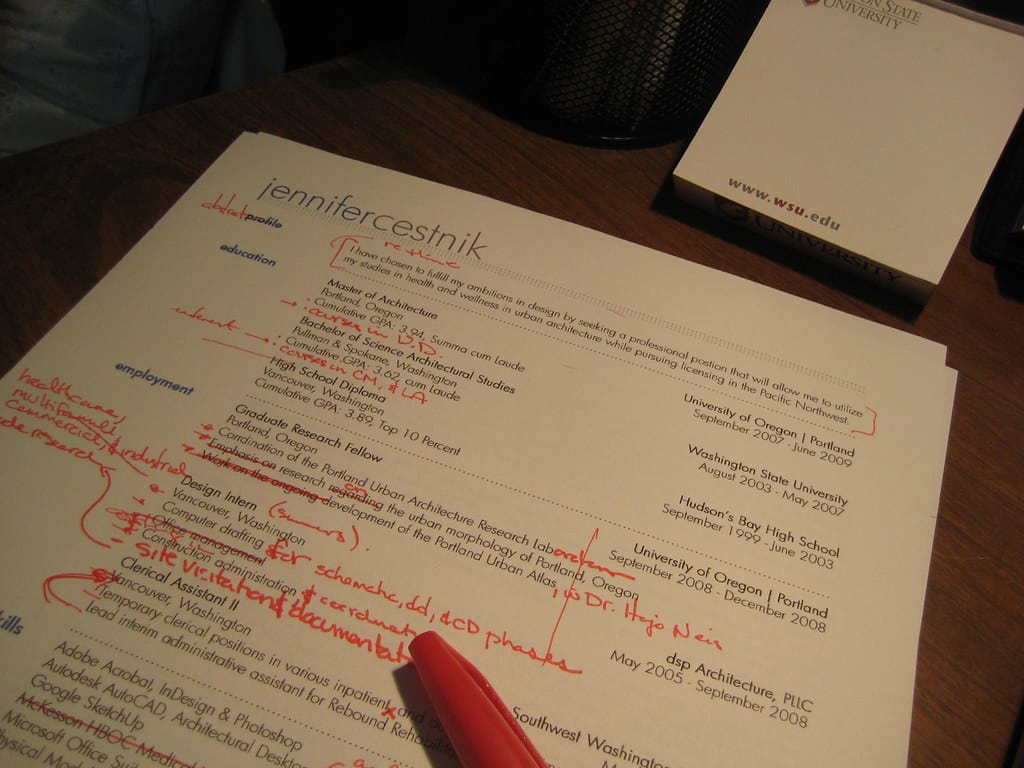
Resume Examples To Get The Job You Want
- Career Advice >
- Resume Structure >
- Parts Of A Resume >
The opinions expressed are solely those of Find My Profession. Click to see our Advertising Disclosure.

How to Add Publications to a Resume or CV (+ Examples)
Publications make your resume competitive and give you an edge over competitors. Find out when, where, and how to add publications on resume or CV.

Employers today are on the lookout for candidates with solid research and writing skills.
To be more “hireable,” you must prove that you possess these skills.
That’s where knowing how to list publications on your resume or CV comes in.
A publication in your name shows that you’re capable of researching a topic, writing about it excellently, and proving your expertise in the subject matter!
In essence, it makes your resume more competitive and gives you the edge you need in securing your dream job.
In this post, you’ll find out when, where, and how to include publications on your resume or CV.
What Is a Publication?
The word “publication” generally refers to a written or digital production made available for distribution. It is an intellectual work that has been researched, written, and published.
Publications make your resume more competitive and keep you ahead of other applicants.
That said, for a publication to be deemed eligible for your resume or CV, it must:
- Be published or in the process of being published
- Be relevant to the job you’re applying for
- Have you listed as an author or collaborator
When you include publications on your resume and CV, they show your research, writing, and logical skills, all of which are in high demand in the corporate world today.
When to Include Publications on Your Resume or CV
Although this depends on the job you are pursuing, as well as the significance of your publication to the industry, these guides will help you determine when to list a publication on your resume or CV:
- If you’re applying for a job in the scientific or academic industry, you should list publications.
- If you’re applying for a job outside the scientific or academic industry, you may still add a publication to boost your resume or CV. However, the publication must be relevant to the job you’re applying for.
While creating your resume or CV, always try to stay as tightly relevant to the job you are applying for as possible.
Where to Put Publications on Resume and a CV
As a general rule, you will list publications after your education. This is because they help to complement your education and show employers how you utilized the knowledge you acquired.
On the other hand, you would not list your publications in the education section if your articles have been published in magazines or other nonscientific periodicals.
Also, if your publications are not really relevant to the job you are applying for, you should add them to the “additional information” section of the resume.
Finally, if you have more than one peer-reviewed publication, you can create a different section on your resume or CV labeled “Publications.”
Then, follow the steps listed in the “How to List Publications on a CV” and “How to List Publications on a Resume” sections below.
Before we jump into that, let’s first discuss the difference between utilizing the accomplishment of published works on a resume versus a CV.
Publications on a Resume vs a CV
Publications on a resume are similar to, yet also different from, publications on a CV.
For one, listing publications on a CV is often more important than listing them on resumes. This is because CVs are generally more encompassing and longer.
So, the more actual proof of knowledge and experience you can provide, the better.
Publications on CVs are also more common than on resumes due to the fact that people who list publications are often looking to get a job in scientific or academic fields.
These industries usually require a CV, so job seekers have to opt for a more detailed representation of their skills and experiences.
In other words, the people most likely to list a publication are looking to acquire academic jobs, and the jobs themselves are better approached with a CV than with a resume.
How to List Publications on a Resume
Listing publications on a resume is a lot simpler than listing them for a CV.
First of all, note that there is no universal layout for listing your publications on your resume, but it is vital to include your publication’s title and where it was published. This will give your potential employer access to the publication, if necessary.
Here’s the process for listing relevant publications on your resume:
- Create a section on your resume titled “Publications.”
- Use reverse chronological order when listing, starting with your most recent published works.
- Use a new bullet point for each publication.
- Pick only publications that are relevant and showcase applicable skills or knowledge.
- Pick a listing style, such as the common MLA or APA styles. You can also just include the respective works’ titles, publisher’s name, and date without following a specific style guide. Make sure your publications have the same formatting as your other sections.
- When listing publications that are in the process of being printed but are not presently available, you should list them as “in press.”
- Do not include written works on a resume if they have not been approved or accepted for publishing!
- Finally, if your publications are not relevant enough to the position you are applying for, it’s advisable not to create a “Publications” section solely for them in your resume or CV. Instead, summarize them in the “Other Activities” section and include details such as the title, the name of the magazine/journal, date of publication, etc.
Now, let’s have a look at an example.
Example of How to List Publications on a Resume
Publications
- “Simplifying the Jargons of Coding,” TekPoint, April 2017.
- “Write to Appeal: A Guide to Evoking Emotion,” Ink HousePress, 2019.
- “From Trash to Cash: How to Sell What People Hate,” Marketing eXpo, 2020.
The above example shows a separate section on resume titled “Publications”. But the formatting of each of the entries shown above will be the same no matter where you put them on your resume.
How to List Publications on a CV
To list your publications on your CV, follow this simple guide:
- Choose your style. You can use a specific formatting style such as the MLA, Chicago, IEEE, or APA format.
- Use a reverse chronological order : List your most recently published works first.
- Don’t list out-of-date publications that are no longer relevant to your field.
- Feel free to add your pending works. Make sure that you note they are “in press.”
- Make your byline noticeable : When listing publications with more than one author, put your name in bold, but do not omit any other authors’ names.
The two most common formats are the MLA and APA formats.
The Modern Language Association (MLA) format is generally used by people in the humanities field, including history, arts, and philosophy.
The MLA format looks like this:
[Last Name], [First Name]. “[Article Title].” [ Journal Name ], [Volume Number], [Issue Number], [Year], [Pages]
The American Psychological Association (APA) format, on the other hand, is typically used by individuals in the science and engineering fields.
The APA format looks like this:
[Last Name], [First Initial]. [(Year)]. [Article title]. [ Journal Name ] [Volume Number] ([Issue Number]), [Pages].
Examples of How to List Publications on a CV
The MLA format:
Rothenberg, W. “Pop Music: The Impact on the Teenage Mind.” Journal of 20th Century Music History , 19 July 2020, pp. 27-33.
Rothenberg, W. “The Origin of Social Media.” Cambridge University Press , 2015.
The APA format:
Dorothy, T. & Richmond, O. (2017). Bullying and Parenting Style. Journal of Basic Psychology, 22 (9), 15-19.
Richmond, O. & Matthew, K. PTSD and the home factor. Journal of PTSD and Treatments (In press).
How Do You Put a Research Paper on Your Resume?
A research paper generally consists of practical research that showcases new findings. As similar as this may seem to a published work, a research paper is not a publication.
Follow these guidelines to add a research paper to your resume:
- Check the job description to determine what particular research skills the employer wants.
- Make a list of the research-related skills they want.
- Add your research to your resume under the “Education” section.
- If you have a lot of relevant research, put these works in a separate section titled ‘Research.” By setting them apart, you help to focus attention on these skills.
- Detail each research paper in a different bullet point.
- List paid research under “Work Experience” when listing research papers in your resume.
Unlike publications, research papers aren’t published by default. That is, a research paper may or may not be published.
Additionally, while research papers are often done in a doctrinal method by students at universities where the work is assigned, publications are written by experts in a particular field.
Key Takeaways
As tempting as it may be to cite all your literary achievements, you need to take a moment to step back and ensure you’re on the right track.
Make sure you only include research and publications relevant to the position you are applying for, and don’t forget that all the information you provide must be completely accurate.
While these tips and techniques are great, sometimes what you need is expert assistance in putting together your resume.
If you need more help formatting your resume or CV’s publications list, you can reach out to us at Find My Profession.
We have helped thousands of career professionals craft job-winning resumes and CVs with our resume writing service , and we can help you do the same.
Recommended Career Advice For You

8 Best Entry-Level Resume Writing Services (2024)

Ways to Crush Your Intro Call With a Recruiter

11 Best Resume Writing Services in Chicago, IL (2024)
- Executive Resume Writing
- Cover Letter Writing
- LinkedIn Profile Writing
- Resume Editing
- Our Writers
- Our Company
- +1 (917) 900 11 89
Everyday 8 am - 4 pm EST
How to List Publications on a Resume or CV
- Resume Tips
When writing a resume or CV, the applicant can use different methods to distinguish their document from others. One such way is listing publications. However, this option is not very popular.
Publications can validate a job seeker’s skills and experience. Adding publications to your resume or CV will make your document more competitive. Knowing how to list publications on a CV or resume can help you stand out in the recruiting process. To make sure that your document is perfectly written and all the publications are listed in a correct way, you may also seek assistance at resume services that know for sure how to help you with making your resume impressive.

Resume vs. CV
Contrary to popular belief, resume and CV are different documents. The resume includes the relevant information that is needed to obtain a specific position. The resume should be as concise as possible, usually no more than 1 or 2 pages. In most cases, job hunters bring their last jobs to the top.
In CV or curriculum vitae, job seekers present all information in chronological order. The length of the CV varies from two to ten pages.
CV describes education, work experience, volunteer work experience, awards, achievements, research, participation in professional associations, and presentations at conferences. It is advisable to indicate the publications, especially in journals. Recruiters and hiring managers will also appreciate the applicant’s inventions if they have any.
Unlike a resume, a CV is not a flexible document. The applicant should correctly draw up a cover letter to emphasize the desire to take up a particular position.
It would be best if you write a CV, not a resume, in case you want to get a position in:
- Academic area
- Scientific area
- Medical area
Related: How to Write an Academic CV
Why are Curriculum Vitae Publications Important?
Publications play an important role because they prove that the applicant has certain competencies. Moreover, they are essential if a job seeker wants a position that requires a lot of research. Some recruiters and hiring managers specifically ask applicants to list publications. Publications increase their confidence in job hunters as professionals.
Apart from this, publications also prove that applicants are good at analyzing and writing. Their articles reflect skills such as literacy, a good education, the ability to work for the result and complete tasks.
Publications will become an essential part of your professional biography when applying for graduate, college, or university work.
If you want to work in a scientific field, you should list all scientific articles written. They will demonstrate your competence level and become an example of involvement in this area.
What Publications Would be Helpful?
There are no strict rules by which to determine which publications you should list on the CV. However, job hunters should only list authoritative and relevant papers. This means that experts must assess them. For example, you can include a list of such publications:
- Academic books
- Research papers for journals
- Research papers not yet published
- Scientific articles
- Papers presented at conferences
Applicants should not include articles and research that were published in magazines. If job seekers want, they can indicate them in the Education section.
The situation with blogs is also controversial. Without a doubt, blog authors can provide reliable information. However, third parties are unlikely to verify this. That is why it is up to each job seeker to decide whether a blog is a suitable publication in their CV. If the applicant chooses not to include it in the Publications section, they can also post information about blogs in the Education section.
How to List Publications on CV?
If you want to add publications to your CV, you should read a few tips for formatting them.
- Choose the correct format. If you do not have many publications, you can describe them in the “Research and Publications” section. As new papers appear, you will need to sort them and create separate lists of related publications
- Select a consistent style for your posts. Remember that the MLA style is used for humanities. The APA style is more common in the field of technology and science
- Use the reverse-chronological method to list publications from most new to earliest
- Do not indicate outdated publications or those that are not related with your professional activity
- Indicate any papers awaiting publication. Highlight in italics those that you forwarded for analysis, but do not indicate the name of the journal to which you sent them
- Please indicate your co-authorship in bold, and do not forget to include the names of other co-authors
How to Cite Publications in the CV?
You can use the APA or the MLA style. The APA style is a form of academic writing developed by the American Psychological Association and is widespread in the social sciences.
MLA style is a standard format for paperwork and citation of humanities sources in the West. The Association of Modern Languages developed it.
Journal publications in APA style :
- First, provide your last name and initials
- Write the year of publication in brackets
- Specify the title of the article
- State in italics in which journal the article was published and the volume (issue), page range
Journal publications in MLA style:
- Write your name
- State the title of the article in quotation marks
- Specify in italics in which journal the article was published, volume, issue, date, pages
- Add co-authors, separate them with commas, and add “and” before the last author’s name.
Published books in APA style:
- Write your last name and initials
- In parentheses, indicate the year of publication
- Indicate the title of the book and subtitle
- Specify the publisher
Note that in APA style, capital letters in post titles are used only in the first word.
Published books or sections in MLA style:
- Start with your name with a period and an underscore at the end
- Include the title of the book and a subtitle with a period and an underscore at the end
- Write publisher, the year with a dot at the end
Where to Put Publications on Resume?
We will share the basic rules for formatting publications while writing a resume.
- Use a special Publications section so that it would be easier for a recruiter or hiring manager to find this information;
- Build a list of the new and relevant papers using reverse chronological order, i.e., from the last post to the first.
- Choose a suitable layout for your listing. Unlike a CV, you don’t need to use styles like MLA or APA. You should list the titles of your publication, as well as where and when they were published.
How to List Publications on Resume?
The structure of the list of published publications will be as follows:
- The title of the article or section
- The title of a scientific journal/popular magazine/newspaper/website
- The surname of the author
- The name and patronymic or initials
- Year of publication
- Issue or publisher number
- Volume and page numbers
- If the article is available online, be sure to add the URL
How to introduce an article presented at the conference:
- Indicate if you were presenter, panelist, or main speaker;
- Write the topic that you discussed;
- Add the name of the conference;
- Specify the place and time when the event was held.
The Final Words
The publications will increase your professional value in the employer’s eyes and will tell them about your interest in the chosen field. There are many ways to list publications on a resume or CV. Thanks to them, a potential employer must see the employee’s involvement and interest in their work.
Regardless of which presentation style you choose, adhere to a structure and a clear statement of all information about yourself and your activities. Structure the section so that the recruiter immediately sees your merits and understands the information you want to convey.
If you are having trouble writing a CV, you can get your CV professionally written by the ResumeEdge team.

Resume Format Guide

How to Write a Summary for a Resume

How To Write a Federal Resume
How To List Publications on a Resume
Listing publications on your resume can help demonstrate your accomplishments and your industry knowledge. Publications are especially highly regarded in the academic and scientific fields, although there are many different instances where adding your publications to your resume can be beneficial.
This article will cover when to list publications on your resume, what kind of publications to include, and how to do so effectively.
When Should You List Publications on Your Resume (or CV)?
It’s a good idea to list publications on your resume whenever they are relevant to the job that you are applying for. Adding your pertinent publications shows potential employers that you are experienced in the industry and that you have strong written communication skills . Publications can also demonstrate analytical skills, research abilities, and subject matter expertise.
If you are applying to a job in an academic, scientific, or medical field, you may be asked to submit a curriculum vitae (CV) instead of a resume. In other parts of the world, ‘resume’ and ‘CV’ are used interchangeably. But, in the United States and Canada, a resume is a short document that is used for applying for jobs in any industry, while CVs are longer, more comprehensive documents that are specifically used in the three fields mentioned above.
If you are asked to submit a CV for a job application in the United States or Canada, you should absolutely create a section for your publications and include all authoritative works that you have authored, co-authored, or contributed to.
It’s acceptable for your CV to be several pages in length since it is essentially a history of your entire education and professional experience. You will likely be asked to submit a CV and should definitely include your publications if you are applying for roles such as:
- Researcher or research assistant
- Professor or assistant professor
- Dean or other higher education administrative/leadership positions
- Laboratory director
- Medical doctor
However, if you are asked to submit a resume for one of those types of professions or for any other role, you can still include your publications if they are relevant and if you have the space to do so without making your resume too long . Your resume should be no longer than one page if you have less than 10 years of experience, and no longer than two pages if you have more experience than that.
What Kind of Publications Should You List on a Resume or CV?
The types of publications that should be included with your job application differ depending on whether you are submitting a CV or a resume.
For a CV, include works that are authoritative, peer-reviewed, and published or about to be published, such as:
- Scholarly articles
- Conference papers
- Research papers or studies (including your published thesis or dissertation)
- Academic books
On your CV, do not include online or print articles that were published in non-scientific or non-academic publications, such as blog posts or magazine articles.
If you are submitting a resume, you can include a broader range of publications types, as long as they are appropriate and relevant to the job you are applying for. For example, you can include:
- Books or portions of books that you’ve authored
- Articles published in trade association magazines or on relevant websites
- Works that have been published in industry journals
- Blogs, blog posts, magazine articles, or websites (especially if you are applying to a writing, content marketing, or similar role)
- Journalistic publications like newspaper or news website articles
- Other published examples of your work that are pertinent to your job application
Where To List Publications
On a CV, you can create a research and publications section within the body of the document, or you can add a separate page at the end for your publications. Especially if you have a large body of work, creating a separate page can help keep your CV organized and readable.
If you are submitting a resume, you can simply create a publications section and list your works there.
Tips for Listing Publications on Your CV or Resume
Here are some tips for adding publications to your CV:
- Choose the appropriate citation style for your field. Most science and engineering fields use APA style while humanities fields (philosophy, history, language, etc.) typically use MLA style. Regardless of which format you choose, use it consistently for every publication on your CV.
- List your publications in reverse chronological order, with the most recent at the top and working backwards in time from there. You can include pending publications - simply italicize that entry and omit the name of the journal or publication that you have submitted it to. You may choose to leave off publications that are old, irrelevant to your target position or field, or no longer useful.
- Draw attention to your byline, especially if you co-authored a publication. Add all author names, but put your name in bold so it stands out.
If you are adding publications to your resume, you don’t need to use a specific citation style. Instead, simply list the name of the piece, where it was published, and the date of publication. Again, use reverse chronological order when listing your publications.
Citation Style Templates
As a reference, here are the different style guidelines to follow when listing your publications on a CV:
APA Style - Journal Publication
Author last name, First initial. Middle initial. (Year of publication). Article title. Journal title, Volume (Issue), Page range.
APA Style - Book
Author last name, First initial. Middle initial. (Year of publication). Book title: Subtitle . Location: Publisher.
MLA Style - Journal Publication
Author last name, First name. “Article Title.” Journal Title , Volume, Issue, Date, Pages.
MLA Style - Book
Author last name, First name. Book Title: Subtitle . Publisher, Year.
Key Takeaways
Listing publications on your resume or CV can be helpful for demonstrating your experience, writing ability, analytical skills, and expertise in your field. Depending on the position you are applying for and whether the employer asks for a CV or a resume, there are different guidelines as far as how and where to list your publications. Ensure that any publications that you list are relevant, professional, and appropriate for your target role.
Need help formatting your publications on your resume? Consider using Jobseeker ’s professional resume tool to create a polished resume or CV. It has templates and prompts to help you list your publications, and you can easily switch between different styles and layouts . Then download your resume instantly and get started applying for jobs right away!
Get ahead of the competition
Make your job applications stand-out from other candidates.

How To Write an Eye-Catching Headline For a Resume

The Benefits of Using a C.A.R. Method Resume

The Importance of an Effective Freelancer Resume
Worldwide Research on Australopiths
- Review Article
- Open access
- Published: 20 April 2024
Cite this article
You have full access to this open access article
- José Luis Guil-Guerrero 1 &
- Francisco Manzano-Agugliaro ORCID: orcid.org/0000-0002-0085-030X 2
Australopiths are a group of early human ancestors that lived approximately 4 to 2 million years ago and are considered a key transitional form between apes and humans. Studying australopiths can help to understand the evolutionary processes that led to the emergence of humans and gain insights into the unique adaptations and characteristics that set humans apart from other primates. A bibliometric-based review of publications on australopiths contained in the Scopus database was conducted, analyzing approximately 2000 of them. The main authors, institutions, and countries researching this subject were identified, as well as their future development. The connections between authors, countries, and research topics were also analyzed through the detection of communities. The more frequent keywords in this subject are hominid, animal, human, South Africa, and Australopithecus afarensis . Four main research clusters were identified in the field of australopiths: palaeobiology, cranial evolution, locomotion, and mandible evolution and morphometry. The most important countries in terms of collaboration networks are South Africa, the UK, France, and Germany. Research on australopiths is ongoing, and new research clusters are expected to emerge, such as those focused on pre-australopiths and the molecular evolution and taxonomy of australopiths. Overall, this work provides a comprehensive overview of the state of research on australopiths and offers insights into the current direction of the field.
Les australopithes sont un groupe de premiers ancêtres humains qui vivaient il y a environ 4 à 2 millions d'années et sont considérés comme une forme de transition essentielle entre les singes et les humains. L'étude des australopithes peut aider à comprendre les processus évolutifs qui ont conduit à l'émergence de l'homme et à mieux comprendre les adaptations et les caractéristiques uniques qui distinguent l'homme des autres primates. Une étude bibliométrique des publications sur les australopithes contenues dans la base de données Scopus a été réalisée, analysant environ 2000 d'entre elles. Les principaux auteurs, institutions et pays menant des recherches sur ce sujet ont été identifiés, ainsi que leur évolution future. Les liens entre les auteurs, les pays et les sujets de recherche ont également été analysés par la détection de communautés. Les mots-clés les plus fréquents dans ce domaine sont hominid, animal, human, South Africa et Australopithecus afarensis. Quatre groupes de recherche principaux ont été identifiés dans le domaine des australopithes: paléobiologie, évolution crânienne, locomotion, et évolution et morphométrie de la mandibule. Les pays les plus importants en termes de réseaux de collaboration sont l'Afrique du Sud, le Royaume-Uni, la France et l'Allemagne. Les recherches sur les australopithes se poursuivent et de nouveaux groupes de recherche devraient voir le jour, comme ceux qui se concentrent sur les pré-australopithes et sur l'évolution moléculaire et la taxonomie des australopithes. Dans l'ensemble, ce travail fournit une vue d'ensemble de l'état de la recherche sur les australopithes et donne un aperçu de l'orientation actuelle.
Avoid common mistakes on your manuscript.
Introduction
The family Hominidae (hominids, great apes) contains the subfamily Ponginae (Asian hominids, which has only one extant genus, Pongo -orangutans-), and the subfamily Homininae (hominines), to which belongs the tribe Gorillini (gorillas, chimpanzees, bonobos, and their evolutionary ancestors), the tribe Panini (the chimpanzee lineage), and the tribe Hominini (hominins) (Almecija et al., 2021 ). The tribe Hominini includes the subtribe Hominina (hominians), and this included the genus Homo , which is the only genus having a current species, and the questioned subtribe Australopithecina (australopiths). Within this last group included the genera Australopithecus , Paranthropus , and Kenyanthropus (Wood, 2010 ), as well as the earlier Ardipithecus , Orrorin , and Sahelanthropus . All these closely related species are now sometimes collectively termed australopiths or homininians (Mongle et al., 2019 ; Strait, 2010 ). The term australopithecine is now underused because this refers to a formal taxonomic group, the subfamily Australopithecinae, which is taxonomically unrecognized. In contrast, the term australopith does not refer to a taxonomic group and is a more appropriate term for all these species (Strait, 2010 ; Wood & Richmond, 2000 ). They are close relatives to current humans and, with the extant genus Homo , comprise the hominin clade. Members of Paranthropu s are called the “robust australopiths,” while the term “gracile australopiths” is used to refer to other hominins such as Australopithecus , Kenyanthropus , or Homo (Wynn et al., 2020 ). Evaluating the hominin status of the pre-australopiths seems to be a very complex task, given that hominid fossils predating the emergence of australopiths are scarce. Ardipithecus ramidus , whose fossils were recovered from Ethiopia’s Afar Rift, has been considered its probable ancestor until recently, but today, this hypothesis is controversial. This hominin combined arboreal climbing with a bipedalism more primitive than that of Australopithecus (White et al., 2009 ).
Australopiths comprise ~ 10 Plio-Pleistocene hominin species who inhabited eastern, central, and southern Africa from ~ 4.2 million to ~ 1.0 million years ago (mya), and fossils have been found in Ethiopia, Chad, Kenya, Tanzania, and South Africa. They were highly diverse, having a large occurrence area, and they developed during periods of pronounced climate change (Strait, 2010 ). Although responses of hominins to climate change have been difficult to test, there are some well-documented cases. For instance, through high-resolution pollen data from Hadar, Ethiopia, it has been shown that Australopithecus afarensis successfully adapted to strong environmental variability between 3.4 and 2.9 mya. Such environmental change consisted of a large biome shift: up to 5 °C cooling and a 200- to 300-mm/year rainfall increase (Bonnefille et al., 2004 ).
Although australopiths do not belong to the genus Homo , they are hominins that share a suite of morphologies with Homo and several others with apes. Undoubtedly, they lacked several features that characterize current Homo , i.e., large brain and sophisticated tool use (Strait, 2010 ). Today, australopiths are considered an adaptive radiation of hominins that were terrestrial bipeds and able to better process hard-to-chew foods than their predecessors. Such conjunction of features allowed them to be successful and could have provided an appropriate setting for the emergence of Homo (Ward, 2018 ). Then, the evolutionary history of australopiths was influenced by their dietary adaptations (Paine & Daegling, 2023 ). Overall, australopiths comprise a grade (i.e., they show similar adaptations) rather than a clade of early hominin, as they do not constitute the descendant of a single common ancestor, while all these features induce to consider australopiths more related to Homo than with earlier apes or hominins. For instance, they are bipedal apes that show, to a greater or lesser degree, large molar and premolar teeth compared to the size of the incisors and canines (hyper-megadontia), and other associated modifications to their feeding apparatuses (Strait, 2010 ).
The genus Australopithecus was first identified in 1925, with the discovery of the fossil known as the Taung skull, which took place in South Africa. This species was named Australopithecus africanus , or “southern ape from Africa” by Dart ( 1925 ), and the name Australopithecus integrates the words austral, “from the south” and pithekos, “ape”. The Taung skull was identified as belonging to a new genus, Australopithecus , given its distinctive characteristics, including a foramen magnum (the hole through which the spinal cord exits the skull) that was tucked underneath the cranium. This suggested that this ape was able to stand and move upright on two feet (Tobias, 1965 ). The Taung skull also had molar teeth, reduced anterior teeth, and a shorter face compared to those of apes. These features led researchers to conclude that the Taung skull belonged to a hominin. Nevertheless, it shows a much smaller brain and larger postcanine teeth in comparison to that of Homo , as is for this that Dart classified it into a new genus (Ward, 2015 ). Australopiths were quickly credited with new abilities compared to those displayed by apes. For instance, the ability to throw was probably achieved at this stage of human evolution. While this ability is poorly developed in apes, anatomical studies suggest that the hand of A. afarensis was adapted to throw with precision and force (Isaac, 1987 ).
From the middle twentieth century, discoveries continued in southern Africa, and the australopiths range reached eastern Africa. For instance, in Olduvai Gorge, in Tanzania, a skull was discovered that undoubtedly belonged to a new genus of australopiths, which was initially classified as Zijanthropus boisiei (Leakey, 1959 ). This hominin is currently known as Paranthropus boisei , which has been found in locations ranging from Ethiopia to Malawi and exhibits a combination of primitive and derived features. Its anatomy is similar to that of Australopithecus , but it shows distinctive cranial and dental morphology, and for some morphological regions, such as the mandible and the mandibular dentition, the samples are relatively well typified (Richmond et al., 2020 ; Wood & Constantino, 2007 ). Fossils of this taxon show a relatively long and curved ulna, an oblique scapular spine, the absence of a third metacarpal styloid process, a gracile thumb metacarpal, and curved manual phalanges. It is thought that P. boisei had strong upper limb muscles, which allowed them to climb trees to a greater extent than earlier australopiths. The anatomy of the hand suggests that P. boisei , like earlier australopiths, had the manual dexterity to make stone tools, but lacked the robust thumb of Homo erectus (Richmond et al., 2020 ).
Some australopiths species are undoubtedly related to the Oldowan stone tool industry. The early tools belonging to this period were simple, usually made with one or a few flakes chipped off with another stone. Oldowan tools occurred during the Lower Paleolithic, dated to 2.9–1.7 mya in several areas of Africa. This technological industry was followed by the more sophisticated Acheulean industry, dated to 1.5–1.26 mya, which is associated with H. erectus (Semaw et al., 2020 ). The oldest Oldowan stone sites occurred within Ethiopia’s Afar Triangle, but recently, sites at Nyayanga (Kenya) have been found dated to 3.0–2.6 mya, and far away from this location. Hippopotamoid butchery proofs were found at such sites associated with Paranthropus sp. (Plummer et al., 2023 ).
Australopiths disappear after 1.4 mya. Probably, the last surviving species were P. boisei in eastern Africa and P. robustus in southern Africa (Strait, 2010 ). The extinction of P. boisei occurred when C4 grasslands dominated landscapes of the Eastern African Rift System. P. boisei was an herbivorous C4 specialist, and paradoxically, its demise coincided with habitats favorable to its dietary ecology. However, the long-term rise of C4 grasslands was disrupted by short periods of warmer temperatures that increased C3 vegetation by the Mid-Pleistocene Transition (1.3–0.7 mya). Such shortage of C4 grasslands increased dietary competition among abundant C4-feeders, and this fact could have influenced P. boisei demise (Quinn & Lepre, 2021 ).
Research on australopiths is timely since it is doubtless that some species belonging to this group constitute the ancestor of all Homo species, thus, knowing the initial stages of differentiation of the former with respect to the apes will help to understand the crucial steps of our evolution. This work aims to provide knowledge about global trends on australopiths research, the most important milestones, and the interrelationships between researchers and countries currently developing knowledge on this topic. Furthermore, bibliometric research can help to identify the most influential and highly cited works in the field, allowing researchers to focus their attention on the most impactful and relevant studies. This can be particularly useful for researchers who are new to the field, as it can help them to quickly become familiar with the most important works in the field and to understand the current state of knowledge on australopiths.
Materials and Methods
There are two main scientific databases, Scopus and WoS (Web of Science). Both provide access to a wide range of scholarly literature, including journal articles, conference proceedings, and other academic publications. Both databases cover a broad range of scientific disciplines, and they both use similar methods to index and organize the literature they contain. As a result, there is a significant overlap between the two databases in terms of the content they provide access to. However, Scopus and WoS do differ in some keyways. For example, Scopus has a larger database and covers more publication sources than WoS. Additionally, Scopus offers more advanced search and discovery tools, while WoS has a stronger focus on citation analysis and impact metrics. Some authors (Cascajares et al., 2021 ; Mongeon & Paul-Hus, 2016 ) have found that Scopus overlaps or matches WoS (Web of Science) in many scientific areas by more than 90% in the indexing of published papers. Scopus has been widely used in various fields for bibliometric studies, including engineering (Zapata-Sierra et al., 2021 ), medicine (Garrido-Cárdenas et al., 2018 ; 2019 ), biology (Salmerón-Manzano et al., 2020 ), and social science (Muyor-Rodríguez et al., 2019 ). As a result, most bibliometric research worldwide relies on Scopus or another database, which is why it was chosen for this study. The Scopus API was utilized to retrieve the data due to the large number of results. The methodologies previously developed by Montoya et al. ( 2018 ) and Cascajares et al. ( 2021 ) were followed. The query used in this study was ((TITLE-ABS-KEY (australopit*) OR TITLE-ABS-KEY ( paranthropus ))). The methodology used is outlined in Fig. 1 . About keywords, or the relationship between countries or between authors, this has been carried out using the VosViewer SW, which applies the analysis of scientific communities or grouping by means of clusters (Salmeron-Manzano & Manzano-Agugliaro, 2019 ). Vosviewer is a software tool that is used to visualize and analyze bibliometric data. It is commonly used in research to identify patterns and trends in scientific literature, such as the most influential papers, authors, and institutions in a particular field. Vosviewer allows users to create maps and diagrams that represent the relationships between different papers, authors, and institutions and to identify clusters or communities within the data. It can also be used to perform a range of analyses, such as identifying trends over time, comparing different fields or disciplines, and analyzing the impact of research. Overall, Vosviewer is a valuable tool for understanding the structure and dynamics of scientific literature and for identifying key trends and patterns in research. The software tool Vosviewer has an algorithm for detecting communities in large networks using modularity. The modularity function was first introduced by Newman and Girvan, and Newman suggested using it to detect communities through the optimization of a modularity function (Waltman & Van Eck, 2013 ). Community detection is the process of identifying groups or clusters of related objects within a larger dataset. In many cases, these communities represent natural divisions within the data, and detecting them can provide valuable insights into the structure and organization of the underlying dataset. One common approach to community detection is to use the optimization of a modularity function. Modularity is a measure of the strength of a division within a network, and optimization of a modularity function involves finding the division that maximizes this measure. This approach can be useful for identifying communities because it can effectively capture the underlying structure of the network and identify groups of nodes that are densely connected to each other but less densely connected to nodes in other groups. In general, the optimization of a modularity function is a powerful tool for detecting communities in complex networks and can provide valuable insights into the underlying structure of the data.
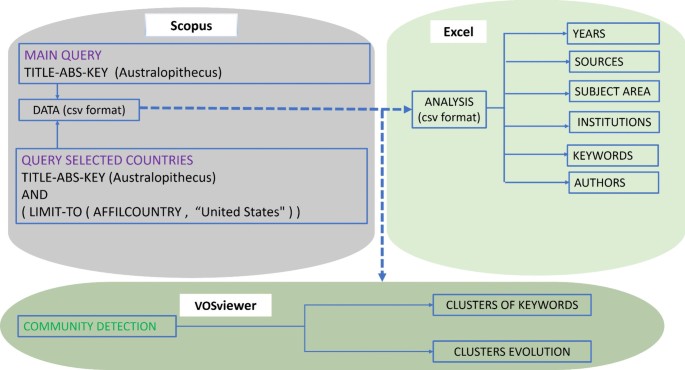
Methodology
Global Evolution Trend
From 1925 to 2022, there are 2246 studies published on australopiths. The research trend for this subject is depicted in Fig. 2 . Notice that there was a steady increase in published papers from 1970 to 2016, with just over 1945 papers in total. After this period, the number of published works has remained relatively stable at around 65 per year. The year in which the discoveries of the various australopiths species take place are indicated in the graphic. A. africanus and P. robustus were the earliest discovered species, in 1925 and 1942, respectively. Between 1976 and 1999, several species were dated, and the more recent one, A. sediba , was discovered in 2010.
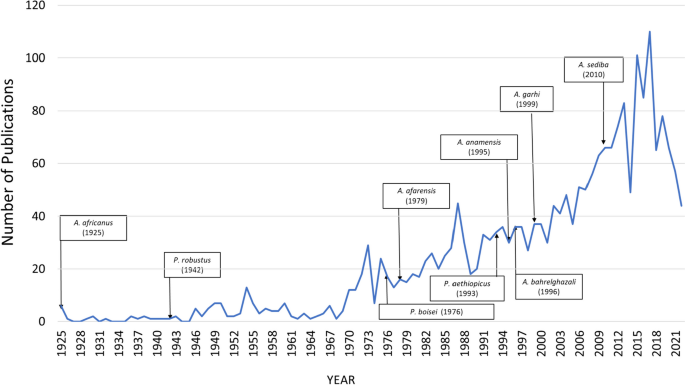
Worldwide temporal evolution of australopiths publications
Document Types and Languages
The various document types used for disseminating knowledge on australopiths are summarized in Table 1 . Notice that the more frequent document type is an article, with more than 80% of the total document types. Article, book chapter, and review modalities represent more than 90% of the total. All these publications have been written in fourteen different languages: English (96%), French (3.5%), and others under 1% as German, Italian, Spanish, Chinese, Danish, Hungarian, Japanese, Polish, Portuguese, Russian, Swedish, or Ukrainian.
Global Subject Category
After analyzing results on australopiths according to the Scopus database categories (Fig. 3 ), it is concluded that the Social Sciences category was the more frequent one with 27% of the total, followed closely by Agricultural and Biological Sciences, with 25%. Other significant categories having relative relevance were Medicine (13%), Earth and Planetary Sciences and Multidisciplinary (9%), Biochemistry, Genetics and Molecular Biology (8%), Arts and Humanities and Environmental Science (3%). All other categories had a representation of less than 1%, including Immunology and Microbiology, Dentistry, Engineering, and Psychology.
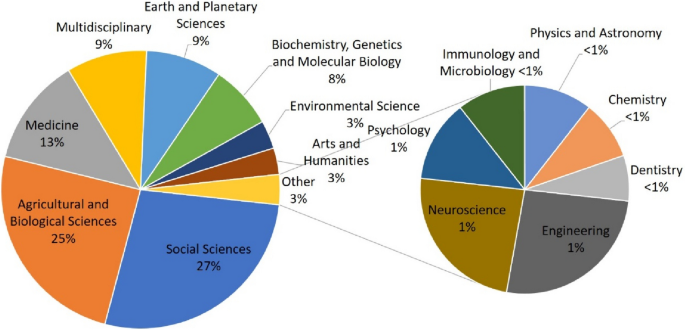
Global subject category of australopiths publications
Distribution of Publications on Australophits by Countries
This topic has been researched by authors belonging to 63 countries. Figure 4 shows the countries that have published on this subject, and Fig. 4 shows the number of publications related to this topic. The USA stands out ~ with 1300 publications. The publications from authors of this country were focused on hominid* , *human* , animal* , Australopithecus , fossil* , evolution , A. afarensis , and morphology . The second most productive country was South Africa, with approximately 500 publications related to this subject. The most frequent keywords in these publications were hominid* , South Africa , Australopithecus , fossil* , animal* , *human , A. africanus , evolution , and Anatomy and Histology . The UK was in the third position with ~ 370 publications, and the main keywords were as in the previous country, but excluding A. africanus and South Africa and including Biological Evolution . France, with ~ 300 publications related to this subject was in the fourth position. The main keywords that French researchers used were hominid* , Australopithecus , fossil* , animal* , *human , evolution , South Africa , bone , and Pliocene . Germany holds the fifth position, with ~ 200 publications in this subject. For such works, the more frequent keywords were hominid* , animal* , fossil* , South Africa , human* , Australopithecus , Anatomy and Histology , evolution , morphology , and P. boisei . The previous countries are followed in intensity of research on this topic by Spain, Australia, Italy, and Kenya with 103, 95, 69, and 62 publications, respectively.
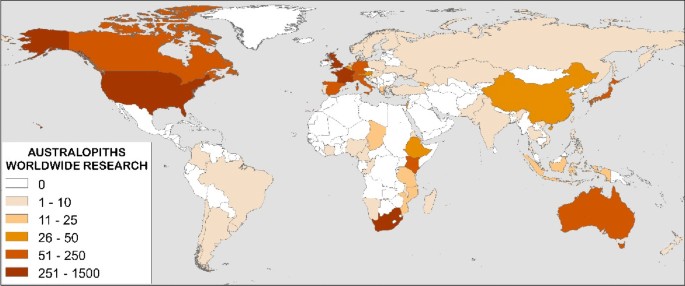
Worldwide australopiths number of publications by country until year 2022
The number of publications from the top 6 countries (those with more than 100 publications) from 1980 to 2022 is depicted in Fig. 5 . This group includes the USA (1104), South Africa (430), the UK (337), France (268), Germany (193), and Spain (102). The USA maintained the greatest number of publications throughout this period. It is noticeable that from this group, the five remaining countries tended to stabilize at about 10–20 publications by year.
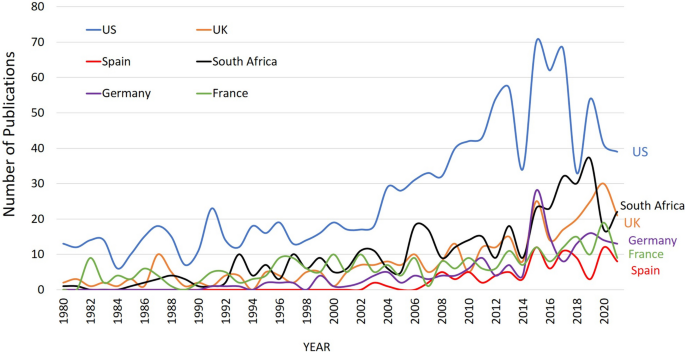
Temporal evolution on australopiths publications for top 6 countries
The analysis of the top 6 countries in accordance with the scientific categories in which their researchers have published is shown in Fig. 6 . Notice that for the USA and France, Social Sciences is the main category for publishing research, followed by Agricultural and Biological Sciences, Medicine, Multidisciplinary, Biochemistry, Genetics and Molecular Biology, Earth and Planetary Sciences, Environmental Sciences, and Arts and Humanities. All these categories are shared by all researchers on the topic, but for investigators from South Africa, the UK, Germany, and Spain, the first one was Agricultural and Biological Sciences.
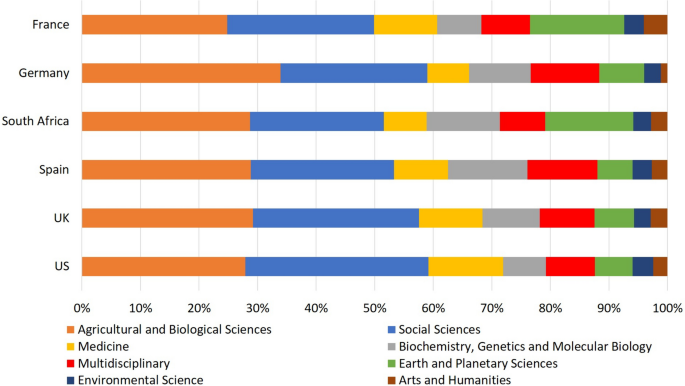
Distribution of publications on australopiths by scientific categories according to top 6 countries
Affiliations (Institutions)
In the previous section, the distribution of publications by country was analyzed. However, the investigations produced at Scopus-indexed institutions have not yet been discussed. Table 2 shows the 19 institutions with more than 50 publications, with 11 from the USA, 2 from France, the UK, and South Africa, and 1 from Germany and Kenya. The 4 most relevant keywords for these institutions show a close similarity in the research being conducted: hominid* , animal* , Australopithecus , and fossil* . Interestingly, South Africa was included in the top 4 main keywords only in the University of the Witwatersrand (Johannesburg, South Africa), while A. afarensis appears in the 4th position in the Arizona State University. The first position considering the intensity of research was for the University of the Witwatersrand, with 348 published papers and 4433 citations. This institution was followed by the CNRS (Centre National de la Recherche Scientifique, France), the Stony Brook University (US), and the Max-Planck-Institut für evolutionäre Anthropologie (Germany). The latter institutions have published 129, 125, and 118 documents on this topic and were cited by 2571, 3767, and 2347 papers, respectively. Interestingly, although the USA holds 11 institutions among the top 20 ones (ordered considering the number of papers related to the topic), the two first positions are for South Africa and France. The more relevant position for the UK institutions is hold by the University College (London), in 7th position, with 87 documents and 2224 citations.
Table 3 shows the researchers who accredit at least 30 papers on the subject. The lead author is L.R. Berger, from the University of the Witwatersrand (Johannesburg, South Africa), with 74 papers, followed by F.E. Grine, from the Stony Brook University (Stony Brook, US), with 58 papers. Interestingly, the highest h-index, i.e., the number of papers ( h ) published in a journal that has been cited at least h times, is held by B.A. Wood (h-index of 59), from the Center for the Advanced Study of Human Paleobiology (Washington, D.C., US), who published 39 works on australopiths. It is also interesting to note that authors from the University of the Witwatersrand occupy 3 of the top 4 positions in this table.
The collaboration network among authors who published more than 30 documents on this subject is shown in Fig. 7 , so, clusters are centered around a main author and the connecting scholars are individuals who have collaborated with that individual. Table 4 summarizes the main authors detected in each cluster, which were built using the various keywords, and the number of authors that make up each of them.

Collaborative network of authors with over 30 publications on australopiths
There were 9 clusters identified, with the largest being the red cluster, which included 29 authors. The main authors in this cluster were R.J. Clarke and J.F Thackeray, both from the University of the Witwatersrand, with 49 and 48 papers each. Other relevant authors within this cluster were T.R. Pickering and K.J. Carlson, with 33 and 31 publications in the topic, both belonging to the previous institution. The second relevant cluster is depicted in light green, which is composed of 21 authors, in which stands out W.H. Kimbel (Institute of Human Origins) and C.O. Lovejoy (Kent State University), both from the USA, who performed 46 and 42 publications on this topic, respectively. Other notable authors within this cluster are H.M. McHenry (University of California, Davis, USA) with 41 published articles on the subject, White, T.D. (University of California, Berkley, USA) with 33 published articles, and G. Suwa (The University of Tokyo, Japan) with 31 publications on this topic. The third cluster, in blue, consists of 20 authors, in which the main authors are F.E. Grine (Stony Brook University) and M. Sponheimer (University of Colorado Boulder), both from the USA, who made 58 and 35 publications on this topic, respectively. Included in this cluster is also C.V. Ward (University of Missouri, Columbia, USA), with 33 papers related to the subject. The fourth cluster (yellow) consists of 19 authors, with B.D. Richmond (American Museum of Natural History, NY, USA) and B.A. Wood (Center for the Advanced Study of Human Paleobiology, WA, USA) as the central authors, having published 27 and 39 papers on this subject, respectively. The fifth cluster (purple) also includes 19 authors, with L.R. Berger (University of the Witwatersrand, Johannesburg, South Africa) and S.E. Churchill (Duke University, Durham, USA) as the leading authors, having published 74 and 29 papers on this subject, respectively. The sixth cluster is blue light-colored, and it is composed of 16 authors, being the most relevant author D.S. Strait (University of Johannesburg, South Africa), who developed 26 publications on this topic. The seventh cluster is colored in orange, and it contains 14 researchers, and its central author is B. Wood (Center for the Advanced Study of Human Paleobiology, WS, USA), who published 39 papers on australopiths. Note that this author is probably the same as the author of the aforementioned cluster four as he has the same surname, and his first initial and works are in the same institution. The eighth cluster is brown-colored and contains 13 authors and is led by P.V. Tobias (School of Clinical Medicine, Johannesburg, South Africa) and D. Falk (Florida State University, Tallahassee, USA), with 36 and 34 papers, respectively. Finally, the ninth group of authors is colored in pink and contains 8 authors whereas the central one is Y. Haile-Selassie (Institute of Human Origins, Tempe, USA), who published 26 papers on this topic.
Source (Journals)
Scientific journals play a pivotal role in the dissemination of research findings, serving as crucial platforms for sharing knowledge across the global scientific community. The selection of the right journal for publishing scientific articles holds paramount importance, as it determines the reach and impact of the research (Nievas-Soriano et al., 2023 ). The indexing of a journal in reputable databases, that is, Web of Science or Scopus, enhances its visibility and accessibility, ensuring that the research is discoverable by fellow researchers, practitioners, and policymakers (Marín-Buzón et al., 2021 ). One metric often used to gauge the influence of a journal is the Journal Citation Reports (JCR) impact factor, which measures the average number of citations received per article published in that journal over a specific time frame.
This factor provides insights into the journal’s significance within its field. Moreover, the categorization of journals based on subject areas assists researchers in locating articles relevant to their interests.
Table 5 details the main journals where more than 60 scientific articles related to australopiths research have been published. This table presents the following: N , the number of articles published on this topic, SJR (SCImago Journal Rank) developed by SCImago Lab and based on Scopus data, JCR (Journal Impact Factor) established by Clarivate Analytics and based on Web of Science, Category of JCR, and the rank in this category. Notice that the two journals with the highest number of publications fall within the Anthropology category, as expected. However, it is noteworthy that the following four belong to the Multidisciplinary category, and two of them are the top two within this lasts category. This highlights the significant general interest in this topic.
Keywords as Global Perspective
One of the goals of bibliometric studies is to analyze the keywords included in papers in order to establish relationships among various publications on a given topic and to identify scientific communities or clusters related to the specific subject. By extracting keywords from publications, we can get an overview of the most common keywords related to the australopith topic (Fig. 8 ). As expected, the search terms are among the main ones, and other head indexing terms were also identified, including Hominid , Hominidae , Human* , Animal* , Evolution , Female , Skull , Bone , Fossil* , Diet , Ape , Male , Australopithecus , and South Africa .
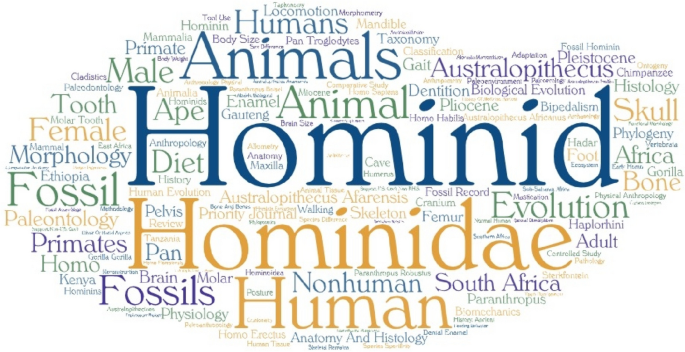
Word cloud of keywords in australopiths research
Table 6 presents the results of analyzing the keywords by country, and it details the five main keywords for the main countries that have conducted research on this topic. To create this table, search terms were not included. It is notable that the most prominent keywords include hominid* , human* , fossil , evolution , Paleolithic , and Pleistocene .
Scientific Communities or Clusters
The clusters were built through the various keywords, and each of them shares similar research trends, which allowed their classification. The documents published between 1925 and 2022 built four-colored clusters drawn in Fig. 9 , and their main keywords collected are detailed in Table 7 .
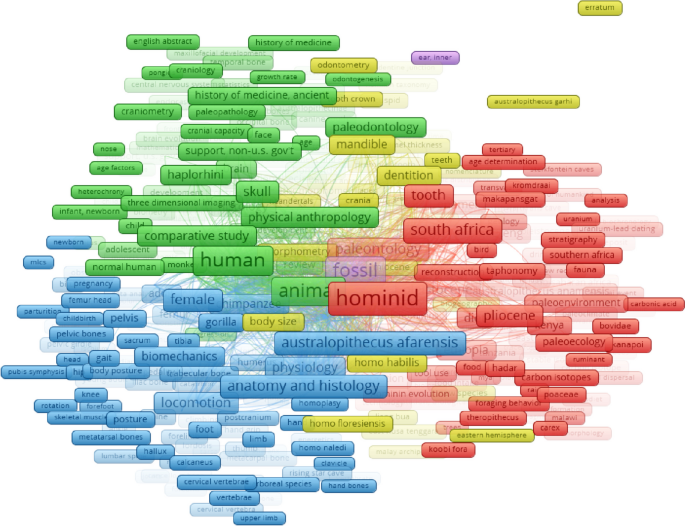
Network of keywords in australopiths publications
Cluster 1: Palaeobiology
The first cluster, “Palaeobiology,” is depicted in red and is built by 313 keywords, being the main ones are as follows: Hominid , South Africa , Hominin evolution , Pliocene , tooth , taphonomy , paleontology , paleoecology , carbon isotopes , Makapansgat , stratigraphy , and diet .
Hominin evolution is a prominent topic within this cluster. The establishment of hominin phylogeny is an open process, which is revived as new fossil discoveries take place. This happens especially when the existence of new species is confirmed, and therefore the paleontological discoveries made in the last decade have greatly expanded the known diversity of extinct taxa (Mongle et al., 2023 ). Currently, there are several uncertainties in hominin phylogeny, for instance, the phylogenetic relationships of Australopithecus spp. with their possible ancestor Ardipithecus (e.g., White et al., 2009 ), and their presumably descendant ( Homo and Paranthropus ) taxa (e.g., Villmoare et al., 2015 ) promote hot debates. Given that A. ramidus became extinct later than 4.3 mya, while Australopithecus appeared earlier than 4.2 mya or earlier, the two genera overlapped in time and, thus, a phyletic evolution seems infeasible between them (Bobe & Wood, 2022 ). On the other hand, a link between Australopithecus and other archaic hominins such as Orrorin tugenensis and Sahelanthropus tchadensis does not seem plausible, judging by their morphology (Strait, 2013 ). Lately, the study of new craniodental material led to the consideration of A. ramidus as being derived relative to Sahelanthropus and as the sister taxon of all later hominins (Mongle et al., 2019 ). At this point, new fossils are expected to help stabilize the origin of Australopithecus .
A remarkable attempt to build australopith’s phylogeny was effected through parsimony analyses on sixty craniodental and mandibular characters (Strait et al., 1997 ). Authors have found evidence for a Paranthropus clade, with Australopithecus being paraphyletic and specimens attributed to A. afarensis being reclassified as P. africanus , which is believed to be the sister of later hominids. In addition, Paranthropus was positioned as the sister of Homo and A. africanus as the sister of the Homo + Paranthropus clade. However, it was noted that certain aspects of hominid evolution remain enigmatic.
In addition to the previous attempt, there have been other ones to establish the phylogeny of hominids (e.g., Mongle et al., 2019 , 2023 ; Strait & Grine, 2004 ; Villmoare, 2018 ). Figure 10 shows a cladogram based on a recently published phylogenetic analysis using currently available morphological craniodental data (Mongle et al., 2023 ; Fig. 5 : Results of iteration 4 Bayesian inference analysis). In this analysis, A. sediba was reconstructed in a polytomy at the Homo + Paranthropus node, while H. habilis and H. rudolfensis were recovered in a polytomy at the base of the genus Homo . A. africanus and A. platyops (syn. Kenyanthropus platyops ) were reconstructed together as sister taxa to a clade containing A. sediba , Paranthropus , and Homo . Such matrix was consistent with previous ones (e.g., Mongle et al., 2019 ; Strait & Grine, 2004 ). The main conclusion was that probably, A. sediba constitutes the end of a lineage sharing a common ancestor with the first Homo spp.
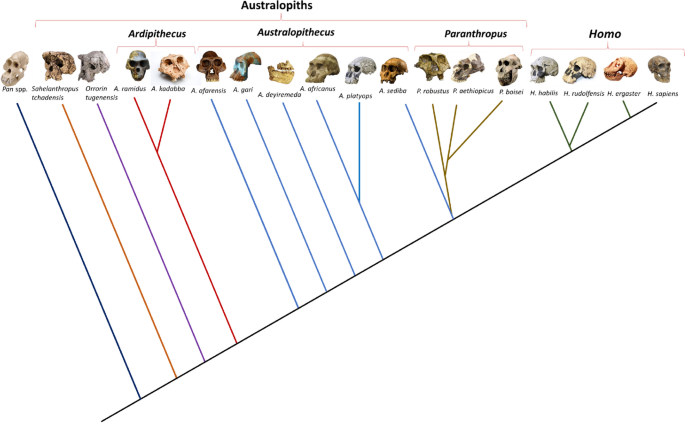
Cladogram representing a recently published phylogeny for hominins (adapted from Mongle et al., 2023 )
While for Paranthropus , there is a wide consensus that it constitutes a distinct monophyletic genus (e.g., Strait et al., 1997 ; Wood & Constantino, 2007 ); the phylogenetic relationships between Australopithecus taxa are the subject of deep controversy. Careful interpretations of the fossil record of Australopithecus accurately recognize five species, which is supported by the presence of uniquely derived, or unique combinations of shared derived, morphological features: A. afarensis , A. africanus , A. garhi , A. platyops , and A. sediba (e.g., Alemseged, 2023 ; Berger et al., 2010 ).
One challenge in classifying fossil hominid material is sexual dimorphism, as the morphological variation in the hominid fossil record exhibits greater sexual dimorphism than exists among modern humans (Brace, 1973 ; Johanson & White, 1979 ).
Some time ago, it was considered that A. anamensis and A. afarensis were separate species in an anagenetic series (e.g., Kimbel et al., 2006 ), and it was believed that the former was the oldest species of Australopithecus , which was discovered in Kanapoi and Allia Bay (Kenya). Bipedalism for this species was established through the study of a tibia (Leakey et al., 1995 ). A. anamensis remains showed a mosaic of primitive and derived features that led to considering this species as an ancestor to A. afarensis , and given that more than one early hominid species could have coexisted at any one time, this discovery suggested that A. ramidus was a sister species to A. anamensis and all later hominids (Leakey, 1995). Later, the study of a lower first deciduous molar (dm1) allowed, confirming that A. anamensis was morphologically intermediate between A. ramidus and A. afarensis , and age estimation was ~ 4 mya (Leakey et al., 1998 ; Ward et al., 1999 ). However, today A. anamensis and A. afarensis are interpreted as one single taxon because the changes noted over time in the cranium, mandible, and dentition in A. anamensis to A. afarensis are interpreted as an intraspecies temporal change. Therefore, the former would represent a synonym of the latter (Alemseged, 2023 ; Kimbel, et al., 2006 ).
Traditionally, A. afarensis (from the Afar region of Ethiopia) has been considered one primitive australopith species and the common ancestor of A. africanus , A. platyops , A. garhi , Paranthropus , and H. habilis (Alemseged, 2023 ; Johanson & White, 1979 ). However, the stratigraphic analysis necessary for accurate dating of karst cave sites in South Africa is highly complex, so this phylogenetic assumption may be uncertain. In this regard, the study of Australopithecus fossils from Sterkfontein (South Africa) led other authors to question that A. africanus descended from A. afarensis , and that there was a coexistence of these two species, which suggests a highly complex family tree in human evolution (Granger et al., 2022 ).
From time to time, new species of such hominins have appeared, yielding new insights about the origins of early Homo . For instance, the discovery of ~ 2.5 mya hominins remains in Hata beds of Ethiopia’s Middle Awash allowed the recognition of a new Australopithecus species: A. garhi . It is believed that this species is descended from A. afarensis and was considered one of the possible ancestor candidates of Homo since it presents intermediate traits between Australopithecus and Homo : humanlike humeral/femoral ratio and an apelike upper arm-to-lower arm ratio (Asfaw et al., 1999 ).
A controversial case is related to the taxonomy of A. platyops . At first, it was found enough morphological distance between it and A. afarensis to reflect a different dietary adaptation, thus, justifying the naming of a new genus, i.e., Kenyanthropus (Leakey et al., 2001 ). However, subsequent discoveries remain, i.e., a maxilla, reduced morphological differences with Australopithecus , for instance, between K. platyops and A. deyiremeda . Thus, it was proposed to rename K. platyops as A. platyops (Alemseged, 2023 ).
Regarding the paleoecology of australopiths, environmental reconstructions suggest that Australopithecus had a high environmental adaptability. For example, in Kanapoi (Rift Valley, Kenya), the habitats of Australopithecus were characterized by a seasonal climate, abundant inland waters, and diverse fauna, and a competition for resources probably occurred (Dumouchel et al., 2021 ). Overall, Australopithecus was adapted to a diversity of habitats such as forests, savannahs, and grassland environments such as that of Kanapoi, than to more humid and forest-rich habitats such as those of the Omo Mursi Formation (southwestern Ethiopia) (e.g., Dumouchel et al., 2021 ; Fillion et al., 2022 ). Such adaptability may have favored to early Australopithecus populations to disperse and adapt to a variety of ecological niches, which allowed several speciation events. Then, the later Australopithecus , i.e., A. africanus , A. sediba , and A. garhi and early Paranthropus and Homo , successfully exploited resources from various environments (Alemseged, 2023 ). An environmental shift to more prevalent aridity took place after 3 mya, and this might have triggered the emergence of several new Australopithecus species, Homo , and Paranthropus , and perhaps the extinction of A. afarensis (Alemseged, 2023 ; Alemseged et al., 2020 ).
Other studies ascribed to this cluster are devoted to the relative size of the posterior teeth to diet. All australopiths had jaws with densely enameled teeth, as those of anatomically modern humans (AMH), but they showed also ape-like canines and molars, which has long been interpreted as an adaptation an omnivorous behavior (Kay, 1985 ). Relative tooth size was modeled for forest and savanna primates and Homo and was also calculated for Australopithecus using posterior maxillary area sums and size. It was found that these hominins were adapted to a diet that included heavily chewed grains, roots, and scavenged animal protein (Wolpoff, 1973 ). In the same year, it was suggested that robust and gracile australopiths had different diets, being Paranthropus vegetarians and Australopithecus omnivorous, given that their range was in different adaptive zones (Kay, 1985 ; Wallace, 1973 ). The dietary habits of A. robustus ( P. robustus ) were also assessed through the 13 C/ 12 C ratio analysis of structural carbonate in tooth enamel, as its robust masticatory apparatus and dental features suggest a specialized dietary niche. The results for P. robustus showed a more generalized or omnivorous diet compared to other australopiths (Lee-Thorp et al., 1994 ). Later on, stable carbon isotope analysis of A. africanus from Makapansgat Limeworks, South Africa, indicated that this hominin ate huge amounts 13 C-rich foods such as grasses or animals that ate these plants, or both. Thus, it was suggested that probably such hominins consumed animal foods before the development of stone tools by Homo species (Sponheimer & Lee-Thorp, 1999 ). Furthermore, studies through carbon isotopes of A. africanus from Sterkfontein (~ 2.5–2.0 mya) showed that this hominin intensively exploited the savanna food web (Van der Merwe et al., 2003 ). Interestingly, the cranial and dental features of australopiths between 4.4 and 2.3 mya indicated that the dietary capabilities of such earliest hominids evolved in a wide variety of habitats, making them well adapted for using the various resources associated with climatic fluctuations (Teaford & Ungar, 2000 ).
Dental microwear texture was used a long time ago as an adequate tool to identify the diets of gracile and robust australopiths (Henry et al., 2012 ; Scott et al., 2005 ). It was hypothesized that differences in occlusal microwear indicate that the diets of both Paranthropus and Australopithecus were qualitatively different (Grine, 1986 ). However, this assumption was rebutted, arguing that A. africanus dental microwear texture is more anisotropic but also more variable in anisotropy than that of P. robustus . This implies that A. africanus ate more tough foods, while P. robustus consumed more hard and brittle items, but both had similar diets (Scott et al., 2005 ). It is likely that stone tools helped such food behaviors, and the oldest direct evidence of their manufacture (2.6 and 2.5 mya) comes from Gona (Ethiopia) where identification of several cut-marked bones indicates stone tool use and stone-tool-assisted consumption of ungulates by A. afarensis (McPherron et al., 2010 ). Some authors indicate that probably, both gracile and robust australopiths consumed the same foods, but based on dental differences, it is though that P. robustus would have required higher energy to break down most usually consumed foods, given by orthognathism and larger chewing muscles, as well as a thicker enamel for resisting such chewing energy (Berthaume & Kupczik, 2021 ). Although doubts for any carnivory behavior after the appearance of Homo erectus have been exposed (Barr et al., 2022 ), as above mentioned, hippopotamoid butchery proofs were found associated with Paranthropus sp., while a tooth from this species possessed carbon isotopic values indicative of a C4 foods-rich diet. Then, the processing of diverse foods, including megafauna, may have been quite usual for Paranthropus sp. (Plummer et al., 2023 ).
The diet of A. sediba was carefully assessed. The combined analysis of plant phytoliths from dental calculus, stable carbon isotope, and dental microwear texture revealed that this hominin consumed C3 foods in preference to widely available C4 resources diet. Thus, the diet of this species was similar to that of A. ramidus and modern savanna chimpanzees (Henry et al., 2012 ).
Cluster 2: Cranial Evolution
The second cluster, “Cranial evolution,” is depicted in green and is built by 228 keywords, being the main ones are as follows: human, animal, skull, physical anthropology, paleodontology, haplorhini, allometry, craniometry, and cranial capacity . Early research that can be included in this cluster is related to the redetermination of the endocranial volume of the Taung skull, which was set to 405 cm 3 , instead of the previously reported 525 cm 3 , and for an adult, the volume was estimated to have 440 cm 3 . This value, added to other australopith measures, lowers the average to 442 cm 3 and increased the statistically significant differences from both robust australopithecines and the Olduvai Gorge hominid, which belongs to the Homo genus ( H. erectus ) (Holloway, 1970 ).
In all cases, the cranial capacity of australopiths was much less than those of Homo species. For instance, A. africanus had a mean cranial volume of 451 cm 3 , although some individuals reached 515 cm 3 . Paranthropus had a mean cranial volume of 479.4 cm 3 , and the range was from 410 ( P. boisei ) to 530 cm 3 ( P. robustus and P. boisei ), while for Paranthropus aethiopicus , there were intermediate values. It needs to be considered that the cranial volume of modern gorillas is 484 cm 3 , while for an AMH, it is ~ 1450 cm 3 (Falk et al., 2000 ). Although the cranial volume of all australopiths is closer to that of the great apes than to that of the AMH, the brain morphology of A. africanus appears more human-like than that of Paranthropus in terms of overall frontal and temporal lobe shape. Then, the former could have been ancestral to Homo (Falk et al., 2000 ).
It needs to be considered that the taxonomic separation of australopiths based on cranial and facial features is questionable due to the limited number of samples available for analysis. For example, A. boisei (syn. P. boisei ), which was originally described based on a cranium found in Olduvai Gorge, Tanzania in 1959, is known for its robust masticatory apparatus. However, some fossil remains discovered in Konso, Ethiopia, including a cranium and associated mandible, showed significant variation within this species. Moreover, these fossils extend the known geographical range of P. boisei , suggesting that P. boisei and H. erectus may have coexisted (Suwa et al., 1997 ). This highlights the importance of considering multiple samples when examining the taxonomy of ancient hominids.
A. sediba was selected to study the brain enlargements and organization from australopiths to Homo . Reports on their craniodental and postcranial skeletons from ~ 1.95 to 1.78 mya led to believe that this hominin descended from A. africanus and shares more derived features with early Homo than any other australopith species (Berger et al., 2010 ). A. sediba brain shows a gradual evolution in the orbitofrontal region from Australopithecus to Homo , though the small endocast volume of A. sediba suggests that brain enlargement occurred after this reorganization (Carlson et al., 2011 ).
Cluster 3: Locomotion
The third cluster, in blue, was labeled “Locomotion,” given significant keywords performing such cluster, which contains 134 items: A. afarensis , anatomy and histology, biomechanics, locomotion, physiology, pelvis, posture, and pelvic bones . Within this grouping, the most cited publications are related to the locomotion of australopiths. Research on this subject started on Early Pleistocene hominids from East and South Africa and was based primarily on the foot and leg bones from Olduvai Gorge (Preuschoft, 1971 ). Early research on the biomechanics of Australopithecus locomotion was focused on the pelvis and femur, and it was concluded that the gait pattern of AMH and the two recognized forms of Australopithecus were indistinguishable. This suggests that the differences in morphology between Australopithecus and AMH having biomechanical significance appear to be related to the combination of a fully bipedal striding gait with different degrees of encephalization, rather than to differences in the gait pattern itself (Lovejoy et al., 1973 ).
Important research within this cluster is related to the bodily proportions of australopiths, which support phylogenetic interpretations of their evolution. In this regard, the skeleton of A. afarensis (AL 288–1; “Lucy”) recovered in 1974 from the Hadar area of Ethiopia (Johanson & Taieb, 1976 ) allowed direct assessment of body size, limb proportions, and skeletal allometry of this species, which has been widely researched to study the biomechanics of australopiths. The body proportions of A. afarensis , as represented by the skeleton of Lucy (AL 288–1), are suitable for bipedalism but differ from those of modern Homo . The reduced relative stride length of Lucy may suggest that bipedal locomotion required more energy for A. afarensis compared to AMH (Jungers, 1982 ). Overall, there is a wide consensus among researchers that the earliest recognized hominins exhibited adaptations indicating habitual bipedalism. Such behavior was attributed also to their supposed ancestor, A. ramidus , which is thought to combined arboreal climbing with primitive bipedalism (White et al., 2009 ).
Probably, australopiths inhabited the oases of the African savannah where trees remained and some other plant foods, and traditionally, this fact has been considered the cause of why they started descending from the trees to walking upright (Reynolds et al., 2011 ). The ability to stand upright would have favored their survival, as they can travel long distances to feed as scavengers, to collect fallen fruit, insects, and many other resources far from the trees (Cordain et al., 1998 ). This latter behavior would have provided the ability for migration to exploit other less explored food resources, as well as to anticipate predators in the savannah, given their ability to look up (Shillington, 2019 ).
However, the various features of bipedal locomotor behavior in fossil hominins constitute a hot topic, for instance, the degree of arboreal behavior among the various australopiths and the locomotor variability across different species. All studies of the locomotor skeleton of australopiths indicated both arboreal climbing/suspension and terrestrial bipedalism. Evidence supports the idea that A. afarensis , represented by the postcranial skeleton and footprints found in the Laetoli Beds of Tanzania, had adaptations for both tree climbing and terrestrial bipedalism. Such bipedalism differed from that of AMH in that it involved less extension at the hip and knee than occurs in modern humans and only limited transfer of weight onto the medial part of the ball of the foot (Stern & Susman, 1983 ). Sexual differences in locomotor behavior, likely due to marked size dimorphism, were also observed, with males possibly engaging in less arboreal activity and more terrestrial bipedalism (Stern & Susman, 1983 ; Susman et al., 1984 ). This suggests that A. afarensis had a unique combination of characteristics that allowed for flexible movement in both trees and on the ground, although it was argued that the evidence presented for arboreal behavior was not conclusive (Ward, 2002 ). For A. afarensis , there were clear proofs for bipedal locomotion, as the foot and other evidence from the lower limb provide, and most authors believed that this hominin had an arboreal behavior, as the gorilla-like scapula and long and curved manual phalanges suggest (e.g., Alemseged et al., 2006 ).
A nearly complete wrist and hand of an adult female A. sediba from South Africa (dating to 1.977 mya) exhibit both Australopithecus -like features, such as a strong flexor apparatus for arboreal locomotion, and Homo -like features, such as a long thumb and short fingers associated with precision gripping and potentially stone tool production. This suggests that A. sediba had a unique combination of adaptations that may have allowed for flexible movement in both trees and on the ground, as well as the ability to produce and use tools. Thus, A. sediba was considered a candidate for early stone tool use and production (Kivell et al., 2011 ). Moreover, through the study of an articulated partial foot and ankle and other bones from this hominin recovered in the Malapa site, South Africa, it was deduced that it may have practiced a unique form of bipedalism and some degree of arboreality (Zipfel et al., 2011 ).
Recently, a study was developed on hip joint loading conditions of AMH, baboons, and fossil hominins attributed to A. africanus , P. robustus , and Hom o. The conclusions were that australopiths had human-like bipedal locomotion, although other features of their musculoskeletal systems exhibit ape-like characteristics (Ryan et al., 2018 ). It is believed that bipedalism evolved in an arboreal context, associated to a foraging strategy, which was concluded through the study of the positional behavior and terrestrially in a savanna-mosaic community of chimpanzees ( Pan troglodytes schweinfurthii ) (Drummond-Clarke et al., 2022 ). Such bipedalism has been linked to an adaptation for locomotion on flexible branches. In this regard, orangutans react to branch flexibility like humans running on springy tracks by increasing knee and hip extension, while all other apes do the reverse. Then, more than an innovation, human bipedalism seems to be an exploitation of a locomotor behavior retained from the common great ape ancestor (Thorpe et al., 2007 ).
However, strong controversy about the origin of bipedalism in australopiths exists. There are investigations whose results diverge from this last hypothesis, arguing that bipedalism in australopiths evolved as a dry-habitat foraging strategy. To test this hypothesis, the measure of femoral shaft obliquity in humans, forest chimpanzees, and dry-habitat (Semliki) chimpanzees was recently investigated (Hunt et al., 2021 ). It was found strong evidence that such human obliquity develops in response to forces generated during bipedal positional behavior. Given their close phylogenetic proximity, obliquity among the Semliki chimpanzees could develop via the same mechanism, thus, suggesting that Semliki chimpanzees engage in bipedalism more often than forest chimpanzees. It was found that dry-habitat chimpanzee femora were intermediate between forest chimpanzees and humans. Furthermore, human femoral obliquity was compared with the values of six australopiths, and angles of australopiths were not significantly greater than those of humans. Thus, femoral obliquity among dry-habitat chimpanzees is consistent with the hypothesis that bipedalism evolved as a dry-habitat foraging strategy (Hunt et al., 2021 ).
Cluster 4: Mandible Evolution and Morphometry
The fourth cluster, in yellow, includes 134 keywords, and among these standout H. habilis , mandible, morphometry, body size, dentition, odontometry, and teeth ; thus, it was named “Mandible evolution and morphometry.” Research on this topic includes the study of the body of such hominins and the use of mandibles for determining phylogeny. Clearly, this cluster partially overlaps with the first one, given some keywords belonging to the latter, as tooth and diet. Therefore, some information given here complements that of the first cluster.
A. ramidus was selected as a model with Paleobiological implications for understanding the earliest stages of human evolution through the study of its teeth, including associated maxillary and mandibular sets. Interestingly, the postcanine megadontia of Australopithecus is absent in A. ramidus . For the latter, an omnivorous/frugivorous niche was suggested through the dental morphology and wear pattern, while the canine/lower third premolar complex indicates a reduction of canine size and honing capacity early in hominid evolution, probably directed by a selection toward the male upper canine (Suwa et al., 2009 ).
The compact bone distribution and biomechanics of early hominid mandibles help to understand the differentiation in hominin’s evolution. The distribution of compact bone in the postcanine mandibular corpus of A. africanus and P. robustus was analyzed using computed tomography to examine its effects on the biomechanical properties of these bones (Daegling & Grine, 1991 ). The compact bone contours were used to calculate cross-sectional biomechanical properties, and it was found that the mechanical properties of the jaws of A. africanus and P. robustus are distinct: A. africanus had less cortical bone than P. robustus , suggesting that the phenomenon of mandibular “robusticity” in australopiths may be due to postcanine megadontia and/or reduced canine size (Daegling & Grine, 1991 ). Traditionally, the craniofacial morphology of australophits has been considered a dietary adaptation for feeding on either small, hard objects, or on large volumes of food (Grine, 1986 ). Therefore, the evolution of australopith craniofacial form has been attributed to the loads applied to the premolars during feeding. However, some researchers have proposed that certain aspects of australopith craniofacial morphology may have evolved in response to the ingestion and initial processing of large, mechanically protected food items like nuts and seeds. These foods may have been important sources of sustenance for australopiths during times of food scarcity (Strait et al., 2009 ). In this regard, using a combination of physical testing and finite element analysis, it has been formulated the hypothesis that australopith occlusal morphology may not represent adaptations for inducing fractures in large, hard food items, but rather for resisting fractures in the tooth crown (Berthaume et al., 2010 ).
Recently, geometric morphometrics and finite element analysis have been used to analyze mandible morphology and chewing biomechanics for establishing the variation within eight fossil hominin species. By relating stress and shape variables and grouping fossil individuals into broad categories based on the hardness of their diet, researchers were able to conclude that some hominins previously thought to consume hard foods, such as those belonging to the Paranthropus clade, actually relied on softer foods. This finding is consistent with other studies using microwear and stable isotope analyses (Marcé-Nogué et al., 2020 ).
Morphometry and body size are also research belonging to this cluster. Traditionally, evolutionary models argued that body size increased from Australopithecus to early Homo , while sexual dimorphism in body size decreased (e.g., McHenry & Coffing, 2000 ; Pilbeam & Gould, 1974 ). Through the relationship between various measures of skeletal size and body mass in modern ape and human specimens of known body weight, the male and female average weights of some australopiths were determined by McHenry ( 1992 ), who calculated much higher weights for australopith males. Later, Grabowski et al. ( 2015 ) stated that many early hominids had smaller bodies than previously thought and provided evidence that large modern human-like size first appeared at least 3 to 3.5 mya in some individuals of A. afarensis . Through equations based on a large ( n = 220) sample of modern humans of known body masses, Grabowski et al. ( 2015 ) estimated male and female average weights: A. afarensis 49.5 and 31.2 kg, A. africanus 38.9 and 25.8 kg, P. robustus (syn. A. robustus ) 32.3 and 24 kg, and A. boisei 45.1 and 30.9 kg, thus questioning the widely accepted evolutionary model of the increase in body size from Australopithecus to the first Homo . Besides body-size dimorphism, canine-size dimorphism is a feature of all australopiths species (e.g., McHenry, 1996 ). Both morphologic characteristics have been interpreted as a mating system involving a low degree of male-male competition and social structure, especially in A. afarensis , as the body weight of males is estimated almost twice than that of females. This level of dimorphism is similar to that of chimpanzees and gorillas, indicating intense male-male competition and polygyny (Plavcan et al., 2005 ), although there is some discrepancy in this hypothesis, arguing failures in methods that are used to estimate body size (e.g., Reno & Lovejoy, 2015 ). Interesting findings derived from the mandible study defining the range for A. afarensis , whose occurrence was first ascribed to the eastern Rift Valley from Tanzania to Ethiopia. The distribution area of such australopith was enlarged through the discovery of a mandible associated with a fauna biochronologically estimated to be 3.0–3.5 mya old in Chad, in the region of Bahr el Ghazal (2,500 km west of the Rift Valley) (Brunet et al., 1995 ).
Concerning mandibular evolution, important research is related to masticatory muscles. Australopithecus and Paranthropu s had these muscles like most primates. Conversely, Homo species showed smaller masticatory muscles. The evolutionary process for the reduction of the masticatory apparatus was in parallel to an encephalization in early Homo . The gene encoding the main myosin heavy chain (MYH) expressed in certain muscles was inactivated after the human and chimpanzee lineages diverged, approximately 2.4 million years ago. This mutation predates the emergence of AMH morphology (Stedman et al., 2004 ). This suggests that the inactivation of this gene may have been a factor in the evolution of human anatomy.
Finally, the study of mandibular postcanine dentition for australopiths from the Shungura formation, Ethiopia, yielded evidence about an incipient robust taxon, A. aethiopicus , that emerged at ~ 2.9 mya, which was largely plesiomorphic: its dentitions had a larger size than that of A. robustus (Suwa et al., 1996 ).
Evolution of Recent Australopith Research
The trend in the evolution of australopith research from the year 2000 until present is depicted in Fig. 11 . The legend shows that there is a color gradation from purple (the oldest keywords) to yellow (the more recent ones). Notice that the oldest terms for australopith* research were human , physical anthropology , comparative study , and paleodontology . It is likely that such terms reflect that research on this subject was focused mainly on the knowledge of differences in morphology among australopiths and with respect to that of Homo spp. In the intermediate period, the more outstanding keywords were hominid , biomechanics , locomotion , female , and A. afarensis , which reflects an interest in the biomechanics of the locomotion. Recently, the more frequent search term was anatomy and physiology , which indicates a growing interest in such features of australopith beings (Cofran, 2019 ).
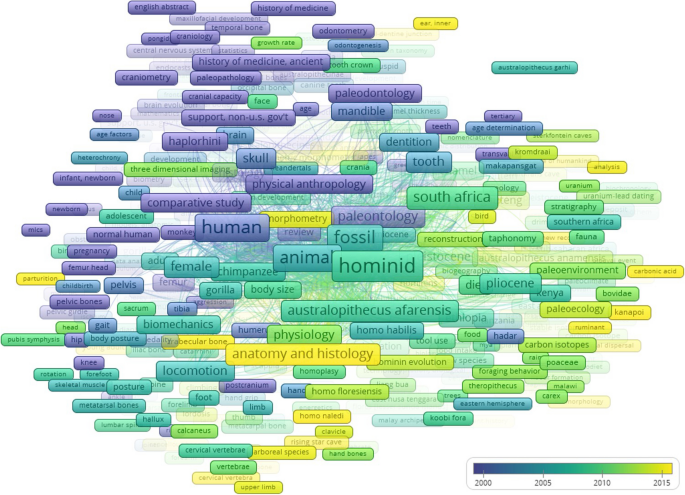
Evolution trend of keywords in australopiths publications
Collaboration Network of Countries Involved in Australopith Research
Figure 12 shows the collaborative network among the various countries that perform research on australopiths. Table 8 details the countries belonging to each grouping and the leader country in each cluster. The countries most central to this network of collaboration are the USA, Kenya, Australia, France, and the UK. Notice the importance relative to the USA, although practically, it performs research in an independent way. The largest cluster is led by Kenya, with 8 collaborative countries, but without significant weight in research on this topic. This cluster was closely followed by those led by Australia, France, and the UK, with 7, 6, and 5 attached countries. In this figure, it can be appreciated that the proximity of the investigations are performed between South African and UK researchers.
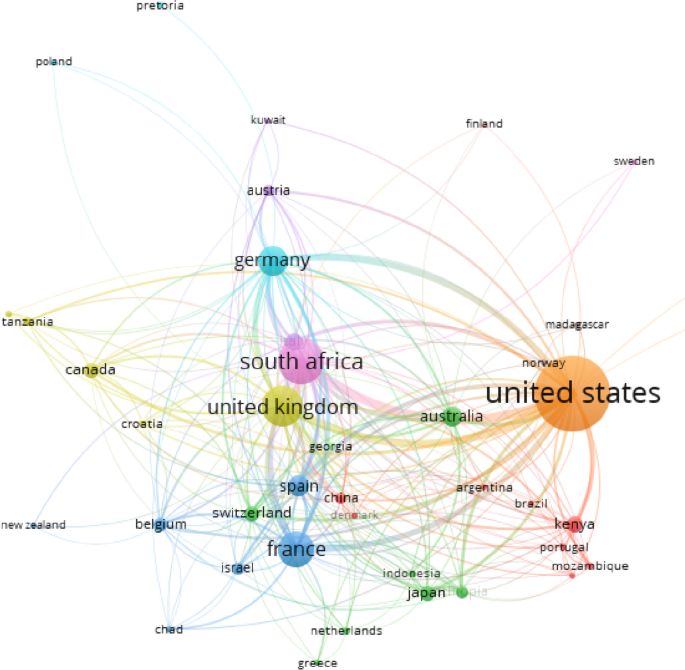
Countries’ network collaboration in australopiths publications
Conclusions
Australopiths as a research topic proved to be of high scientific interest as demonstrated by the fact that it has been investigated by researchers from 63 different countries. The analysis of the scientific literature included in the Scopus database about australopiths showed a continuous increase from 1925 to 2022, with 2246 studies published on this topic. Then, a continuous increase from 1970 to 2016 takes place with just over 1945 papers. After this period, published works were stabilized at approximately 65 each year. The research on australopiths shows nine collaborative clusters among western countries and other ones from Africa and Australia. The main terms indexed when developing research on australopiths are hominid , animal , human , South Africa , and Australopithecus afarensis . From the analysis of the keywords of all these documents, four clusters were found (i) “Palaeobiology,” having as main keywords tooth , taphonomy , paleontology , paleoecology , diet , and carbon isotopes ; (ii) “Cranial evolution,” having keywords as the skull , physical anthropology, paleodontology , craniometr y, and cranial capacity ; (iii) “Locomotion,” in which significant keywords were anatomy and physiology, biomechanics, locomotion, pelvis, posture, and pelvic bones ; (iv) “Mandible evolution and morphometry,” in which the outstanding keywords were mandible, morphometry, body size, dentition, odontometry, and teeth . These clusters demonstrate the diversity and depth of research being conducted on australopiths and highlight the importance of these early human ancestors in our understanding of human evolution. Future research in this field has the potential to continue shedding light on the lives and adaptations of these interesting hominins and to further our understanding of our own evolutionary history. Overall, the research on australopiths is essential for our understanding of human evolution and for providing context and insights into the unique characteristics and adaptations that make us human. By continuing to study and learn about these early human ancestors, knowledge of our own evolutionary history will be expanded and placed in the natural world.
Data Availability
The data have been extracted from the Scopus scientific database and are available to all those who have access to it. However, they will be made available upon reasoned request.
Alemseged, Z., Wynn, J. G., Geraads, D., Reed, D., Andrew Barr, W., Bobe, R., ... & Mohan, J. (2020). Fossils from Mille-Logya, Afar, Ethiopia, elucidate the link between Pliocene environmental changes and Homo origins. Nature communications, 11, 2480. https://doi.org/10.1038/s41467-020-16060-8
Alemseged, Z. (2023). Reappraising the palaeobiology of Australopithecus . Nature, 617 , 45–54. https://doi.org/10.1038/s41586-023-05957-1
Article Google Scholar
Alemseged, Z., Spoor, F., Kimbel, W. H., Bobe, R., Geraads, D., Reed, D., & Wynn, J. G. (2006). A juvenile early hominin skeleton from Dikika, Ethiopia. Nature, 443 , 296–301. https://doi.org/10.1038/nature05047
Almécija, S., Hammond, A. S., Thompson, N. E., Pugh, K. D., Moyà-Solà, S., & Alba, D. M. (2021). Fossil apes and human evolution. Science, 372 , eabb4363. https://doi.org/10.1126/science.abb4363
Asfaw, B., White, T., Lovejoy, O., Latimer, B., Simpson, S., & Suwa, G. (1999). Australopithecus garhi : A new species of early hominid from Ethiopia. Science, 284 , 629–635. https://doi.org/10.1126/science.284.5414.629
Barr, W. A., Pobiner, B., Rowan, J., Du, A., & Faith, J. T. (2022). No sustained increase in zooarchaeological evidence for carnivory after the appearance of Homo erectus . Proceedings of the National Academy of Sciences, 119 , e2115540119. https://doi.org/10.1073/pnas.211554011
Berger, L. R., De Ruiter, D. J., Churchill, S. E., Schmid, P., Carlson, K. J., Dirks, P. H., & Kibii, J. M. (2010). Australopithecus sediba : A new species of Homo -like australopith from South Africa. Science, 328 , 195–204. https://doi.org/10.1126/science.1184944
Berthaume, M., Grosse, I. R., Patel, N. D., Strait, D. S., Wood, S., & Richmond, B. G. (2010). The effect of early hominin occlusal morphology on the fracturing of hard food items. The Anatomical Record: Advances in Integrative Anatomy and Evolutionary Biology, 293 , 594–606. https://doi.org/10.1002/ar.21130
Berthaume, M. A., & Kupczik, K. (2021). Molar biomechanical function in South African hominins Australopithecus africanus and Paranthropus robustus . Interface Focus, 11 , 20200085. https://doi.org/10.1098/rsfs.2020.0085
Bobe, R., & Wood, B. (2022). Estimating origination times from the early hominin fossil record. Evolutionary Anthropology: Issues, News, and Reviews, 31 , 92–102. https://doi.org/10.1002/evan.21928
Bonnefille, R., Potts, R., Chalié, F., Jolly, D., & Peyron, O. (2004). High-resolution vegetation and climate change associated with Pliocene Australopithecus afarensis . Proceedings of the National Academy of Sciences, 101 , 12125–12129. https://doi.org/10.1073/pnas.040170910
Brace, C. L. (1973). Sexual dimorphism in human evolution. Yearbook of Physical Anthropology, 16 , 31–49.
Google Scholar
Brunet, M., Beauvilain, A., Coppens, Y., Heintz, E., Moutaye, A. H., & Pilbeam, D. (1995). The first australopithecine 2,500 kilometres west of the Rift Valley (Chad). Nature, 378 , 273–275. https://doi.org/10.1038/378273a0
Carlson, K. J., Stout, D., Jashashvili, T., De Ruiter, D. J., Tafforeau, P., Carlson, K., & Berger, L. R. (2011). The endocast of MH1, Australopithecus sediba . Science, 333 , 1402–1407. https://doi.org/10.1126/science.12039
Cascajares, M., Alcayde, A., Salmerón-Manzano, E., & Manzano-Agugliaro, F. (2021). The bibliometric literature on Scopus and WoS: The medicine and environmental sciences categories as case of study. International Journal of Environmental Research and Public Health, 18 , 5851. https://doi.org/10.3390/ijerph18115851
Cofran, Z. (2019). Brain size growth in Australopithecus . Journal of Human Evolution, 130 , 72–82. https://doi.org/10.1016/j.jhevol.2019.02.006
Cordain, L., Gotshall, R. W., & Eaton, S. B. (1998). Physical activity, energy expenditure and fitness: An evolutionary perspective. International Journal of Sports Medicine, 19 , 328–335. https://doi.org/10.1055/s-2007-971926
Daegling, D. J., & Grine, F. E. (1991). Compact bone distribution and biomechanics of early hominid mandibles. American Journal of Physical Anthropology, 86 , 321–339. https://doi.org/10.1002/ajpa.1330860302
Dart, R. A. (1925). Australopithecus africanus : The man-ape of South Africa. Nature, 115 , 195–199. https://doi.org/10.1038/115195a0
Drummond-Clarke, R. C., Kivell, T. L., Sarringhaus, L., Stewart, F. A., Humle, T., & Piel, A. K. (2022). Wild chimpanzee behavior suggests that a savanna-mosaic habitat did not support the emergence of hominin terrestrial bipedalism. Science Advances, 8 , eadd9752. https://doi.org/10.1126/sciadv.add975
Dumouchel, L., Bobe, R., Wynn, J. G., & Barr, W. A. (2021). The environments of Australopithecus anamensis at Allia Bay, Kenya: A multiproxy analysis of early Pliocene Bovidae. Journal of Human Evolution, 151 , 102928. https://doi.org/10.1016/j.jhevol.2020.102928
Falk, D., Redmond, J. C., Jr., Guyer, J., Conroy, C., Recheis, W., Weber, G. W., & Seidler, H. (2000). Early hominid brain evolution: A new look at old endocasts. Journal of Human Evolution, 38 , 695–717. https://doi.org/10.1006/jhev.1999.0378
Fillion, E. N., Harrison, T., & Kwekason, A. (2022). A nonanalog Pliocene ungulate community at Laetoli with implications for the paleoecology of Australopithecus afarensis . Journal of Human Evolution, 167 , 103182. https://doi.org/10.1016/j.jhevol.2022.103182
Garrido-Cardenas, J. A., Cebrián-Carmona, J., González-Cerón, L., Manzano-Agugliaro, F., & Mesa-Valle, C. (2019). Analysis of global research on malaria and Plasmodium vivax . International Journal of Environmental Research and Public Health, 16 , 1928. https://doi.org/10.3390/ijerph16111928
Garrido-Cardenas, J. A., Mesa-Valle, C., & Manzano-Agugliaro, F. (2018). Human parasitology worldwide research. Parasitology, 145 , 699–712. https://doi.org/10.1017/S0031182017001718
Grabowski, M., Hatala, K. G., Jungers, W. L., & Richmond, B. G. (2015). Body mass estimates of hominin fossils and the evolution of human body size. Journal of Human Evolution, 85 , 75–93. https://doi.org/10.1016/j.jhevol.2015.05.005
Granger, D. E., Stratford, D., Bruxelles, L., Gibbon, R. J., Clarke, R. J., & Kuman, K. (2022). Cosmogenic nuclide dating of Australopithecus at Sterkfontein, South Africa. Proceedings of the National Academy of Sciences, 119 , e2123516119. https://doi.org/10.1073/pnas.2123516119
Grine, F. E. (1986). Dental evidence for dietary differences in Australopithecus and Paranthropus : A quantitative analysis of permanent molar microwear. Journal of Human Evolution, 15 , 783–822. https://doi.org/10.1016/S0047-2484(86)80010-0
Henry, A. G., Ungar, P. S., Passey, B. H., Sponheimer, M., Rossouw, L., Bamford, M., ... & Berger, L. (2012). The diet of Australopithecus sediba . Nature, 487, 90–93. https://doi.org/10.1038/nature11185
Holloway, R. L. (1970). Australopithecine endocast (Taung specimen, 1924): A new volume determination. Science, 168 , 966–968. https://doi.org/10.1126/science.168.3934.966
Hunt, K. D., Dunevant, S. E., Yohler, R. M., & Carlson, K. J. (2021). Femoral bicondylar angles among dry-habitat chimpanzees ( Pan troglodytes schweinfurthii ) resemble those of humans: Implications for knee function, australopith sexual dimorphism, and the evolution of bipedalism. Journal of Anthropological Research, 77 , 303–337. https://doi.org/10.1086/715398
Isaac, B. (1987). Throwing and human evolution. African Archaeological Review, 5 , 3–17. https://doi.org/10.1007/BF01117078
Johanson, D. C., & Taieb, M. (1976). Plio-pleistocene hominid discoveries in Hadar, Ethiopia. Nature, 260 , 293–297. https://doi.org/10.1038/260293a0
Johanson, D. C., & White, T. D. (1979). A systematic assessment of early African hominids. Science, 203 , 321–330. https://doi.org/10.1126/science.104384
Jungers, W. L. (1982). Lucy’s limbs: Skeletal allometry and locomotion in Australopithecus afarensis . Nature, 297 , 676–678. https://doi.org/10.1038/297676a0
Kay, R. F. (1985). Dental evidence for the diet of Australopithecus . Annual Review of Anthropology, 14 (1), 315–341.
Kimbel, W. H., Lockwood, C. A., Ward, C. V., Leakey, M. G., Rak, Y., & Johanson, D. C. (2006). Was Australopithecus anamensis ancestral to A. afarensis ? A case of anagenesis in the hominin fossil record. Journal of Human Evolution, 51 , 134–152. https://doi.org/10.1016/j.jhevol.2006.02.003
Kivell, T. L., Kibii, J. M., Churchill, S. E., Schmid, P., & Berger, L. R. (2011). Australopithecus sediba hand demonstrates mosaic evolution of locomotor and manipulative abilities. Science, 333 , 1411–1417. https://doi.org/10.1126/science.1202625
Leakey, L. S. (1959). A new fossil skull from Olduvai. Nature, 184 , 491–493.
Leakey, M. G., Feibel, C. S., McDougall, I., & Walker, A. (1995). New four-million-year-old hominid species from Kanapoi and Allia Bay, Kenya. Nature, 376 , 565–571. https://doi.org/10.1038/376565a0
Leakey, M. G., Feibel, C. S., McDougall, I., Ward, C., & Walker, A. (1998). New specimens and confirmation of an early age for Australopithecus anamensis . Nature, 393 , 62–66. https://doi.org/10.1038/29972
Leakey, M., Spoor, F., Brown, F., Gathogo, P. N., Kiarie, C., Leakey, L. N., & McDougall, I. (2001). New hominin genus from eastern Africa shows diverse middle Pliocene lineages. Nature, 410 , 433–440. https://doi.org/10.1038/35068500
Lee-Thorp, J. A., van der Merwe, N. J., & Brain, C. K. (1994). Diet of Australopithecus robustus at Swartkrans from stable carbon isotopic analysis. Journal of Human Evolution, 27 , 361–372. https://doi.org/10.1006/jhev.1994.1050
Lovejoy, C. O., Heiple, K. G., & Burstein, A. H. (1973). The gait of Australopithecus . American Journal of Physical Anthropology, 38 , 757–779. https://doi.org/10.1002/ajpa.1330380315
Marcé-Nogué, J., Püschel, T. A., Daasch, A., & Kaiser, T. M. (2020). Broad-scale morpho-functional traits of the mandible suggest no hard food adaptation in the hominin lineage. Scientific Reports, 10 (1), 1–11. https://doi.org/10.1038/s41598-020-63739-5
Marín-Buzón, C., Pérez-Romero, A., Lopez-Castro, J. L., Ben Jerbania, I., & Manzano-Agugliaro, F. (2021). Photogrammetry as a new scientific tool in archaeology: Worldwide research trends. Sustainability, 13 , 5319. https://doi.org/10.3390/su13095319
McHenry, H. M. in The archaeology of human ancestry: Power, sex and tradition (eds Shennan, S. & Steele, J.) 82–99 (Routledge, 1996).
McHenry, H. M. (1992). Body size and proportions in early hominids. American Journal of Physical Anthropology, 87 , 407–431. https://doi.org/10.1002/ajpa.1330870404
McHenry, H. M., & Coffing, K. (2000). Australopithecus to Homo : Transformations in body and mind. Annual Review of Anthropology, 29 , 125–146. https://doi.org/10.1016/j.jhevol.2015.05.005
McPherron, S. P., Alemseged, Z., Marean, C. W., Wynn, J. G., Reed, D., Geraads, D., ... & Béarat, H. A. (2010). Evidence for stone-tool-assisted consumption of animal tissues before 3.39 million years ago at Dikika, Ethiopia. Nature, 466, 857–860. https://doi.org/10.1038/nature09248
Mongeon, P., & Paul-Hus, A. (2016). The journal coverage of Web of Science and Scopus: A comparative analysis. Scientometrics, 106 , 213–228. https://doi.org/10.1007/s11192-015-1765-5
Mongle, C. S., Strait, D. S., & Grine, F. E. (2019). Expanded character sampling underscores phylogenetic stability of Ardipithecus ramidus as a basal hominin. Journal of Human Evolution, 131 , 28–39. https://doi.org/10.1016/j.jhevol.2019.03.006
Mongle, C. S., Strait, D. S., & Grine, F. E. (2023). An updated analysis of hominin phylogeny with an emphasis on re-evaluating the phylogenetic relationships of Australopithecus sediba . Journal of Human Evolution, 175 , 103311. https://doi.org/10.1016/j.jhevol.2022.103311
Montoya, F. G., Alcayde, A., Baños, R., & Manzano-Agugliaro, F. (2018). A fast method for identifying worldwide scientific collaborations using the Scopus database. Telematics and Informatics, 35 , 168–185. https://doi.org/10.1016/j.tele.2017.10.010
Muyor-Rodriguez, J., Manzano-Agugliaro, F., & Garrido-Cardenas, J. A. (2019). The state of global research on social work and disability. Social Work in Health Care, 58 , 839–853. https://doi.org/10.1080/00981389.2019.1659904
Nievas-Soriano, B. J., Martín-Latorre, M. D. M., Martín-González, M., Manzano-Agugliaro, F., & Castro-Luna, G. (2023). Worldwide research trends on bronchiolitis in pediatrics. Pediatric Pulmonology, 58 , 2189–2203. https://doi.org/10.1002/ppul.26453
Paine, O. C., & Daegling, D. J. (2023). The game of models: Dietary reconstruction in human evolution. Journal of Human Evolution, 174 , 103295. https://doi.org/10.1016/j.jhevol.2022.103295
Pilbeam, D., & Gould, S. J. (1974). Size and scaling in human evolution: Homo sapiens is a peculiar large primate; however, all australopithecines are versions of the “same” animal. Science, 186 , 892–901. https://doi.org/10.1126/science.186.4167.89
Plavcan, J. M., Lockwood, C. A., Kimbel, W. H., Lague, M. R., & Harmon, E. H. (2005). Sexual dimorphism in Australopithecus afarensis revisited: How strong is the case for a human-like pattern of dimorphism? Journal of Human Evolution, 48 , 313–320. https://doi.org/10.1016/j.jhevol.2004.09.006
Plummer, T. W., Oliver, J. S., Finestone, E. M., Ditchfield, P. W., Bishop, L. C., Blumenthal, S. A., ... & Potts, R. (2023). Expanded geographic distribution and dietary strategies of the earliest Oldowan hominins and Paranthropus . Science, 379(6632), 561–566. https://doi.org/10.1126/science.abo7452
Preuschoft, H. (1971). Body posture and mode of locomotion in early Pleistocene hominids. Folia Primatologica, 14 , 209–240.
Quinn, R. L., & Lepre, C. J. (2021). Contracting eastern African C4 grasslands during the extinction of Paranthropus boisei . Scientific Reports, 11 , 1–10. https://doi.org/10.1038/s41598-021-86642-z
Reno, P. L., & Lovejoy, C. O. (2015). From Lucy to Kadanuumuu: Balanced analyses of Australopithecus afarensis assemblages confirm only moderate skeletal dimorphism. PeerJ, 3 , e925. https://doi.org/10.7717/peerj.925
Reynolds, S. C., Bailey, G. N., & King, G. C. (2011). Landscapes and their relation to hominin habitats: Case studies from Australopithecus sites in eastern and southern Africa. Journal of Human Evolution, 60 , 281–298. https://doi.org/10.1016/j.jhevol.2010.10.001
Richmond, B. G., Green, D. J., Lague, M. R., Chirchir, H., Behrensmeyer, A. K., Bobe, R., ... & Braun, D. R. (2020). The upper limb of Paranthropus boisei from Ileret, Kenya. Journal of Human Evolution, 141, 102727. https://doi.org/10.1016/j.jhevol.2019.102727
Ryan, T. M., Carlson, K. J., Gordon, A. D., Jablonski, N., Shaw, C. N., & Stock, J. T. (2018). Human-like hip joint loading in Australopithecus africanus and Paranthropus robustus . Journal of Human Evolution, 121 , 12–24. https://doi.org/10.1016/j.jhevol.2018.03.008
Salmerón-Manzano, E., Garrido-Cardenas, J. A., & Manzano-Agugliaro, F. (2020). Worldwide research trends on medicinal plants. International Journal of Environmental Research and Public Health, 17 , 3376. https://doi.org/10.3390/ijerph17103376
Salmerón-Manzano, E., & Manzano-Agugliaro, F. (2019). The role of smart contracts in sustainability: Worldwide research trends. Sustainability, 11 , 3049. https://doi.org/10.3390/su11113049
Scott, R. S., Ungar, P. S., Bergstrom, T. S., Brown, C. A., Grine, F. E., Teaford, M. F., & Walker, A. (2005). Dental microwear texture analysis shows within-species diet variability in fossil hominins. Nature, 436 , 693–695. https://doi.org/10.1038/nature03822
Semaw, S., Rogers, M. J., Simpson, S. W., Levin, N. E., Quade, J., Dunbar, N., ... & Everett, M. (2020). Co-occurrence of Acheulian and Oldowan artifacts with Homo erectus cranial fossils from Gona, Afar, Ethiopia. Science Advances, 6(10), eaaw4694. https://doi.org/10.1126/sciadv.aaw4694
Shillington, K. (2019). Early prehistory of Africa. In History of Africa (pp. 9–22). Palgrave, London.
Sponheimer, M., & Lee-Thorp, J. A. (1999). Isotopic evidence for the diet of an early hominid, Australopithecus africanus . Science, 283 , 368–370. https://doi.org/10.1126/science.283.5400.368
Stedman, H. H., Kozyak, B. W., Nelson, A., Thesier, D. M., Su, L. T., Low, D. W., ... & Mitchell, M. A. (2004). Myosin gene mutation correlates with anatomical changes in the human lineage. Nature, 428, 415–418. https://doi.org/10.1038/nature02358
Stern, J. T., Jr., & Susman, R. L. (1983). The locomotor anatomy of Australopithecus afarensis . American Journal of Physical Anthropology, 60 , 279–317. https://doi.org/10.1002/ajpa.1330600302
Strait, D. S., Weber, G. W., Neubauer, S., Chalk, J., Richmond, B. G., Lucas, P. W., … & Smith, A. L. (2009). The feeding biomechanics and dietary ecology of Australopithecus africanus. Proceedings of the National Academy of Sciences, 106(7), 2124–2129. https://doi.org/10.1073/pnas.08087301
Strait, D. S. (2010). The evolutionary history of the australopiths. Evolution: Education and Outreach, 3 , 341–352. https://doi.org/10.1007/s12052-010-0249-6
Strait, D. S. (2013). The biogeographic implications of early hominin phylogeny. In K. E. Reed, J. G. Fleagle, & R. E. Leakey (Eds.), The Paleobiology of Australopithecus (pp. 183–191). Springer.
Chapter Google Scholar
Strait, D. S., & Grine, F. E. (2004). Inferring hominoid and early hominid phylogeny using craniodental characters: The role of fossil taxa. Journal of Human Evolution, 47 , 399–452. https://doi.org/10.1016/j.jhevol.2004.08.008
Strait, D. S., Grine, F. E., & Moniz, M. A. (1997). A reappraisal of early hominid phylogeny. Journal of Human Evolution, 32 (1), 17–82. https://doi.org/10.1006/jhev.1996.0097
Susman, R. L., Stern, J. T., & Jungers, W. L. (1984). Arboreality and bipedality in the Hadar hominids. Folia Primatologica, 43 , 113–156. https://doi.org/10.1159/000156176
Suwa, G., Asfaw, B., Beyene, Y., White, T. D., Katoh, S., Nagaoka, S., ... & WoldeGabriel, G. (1997). The first skull of Australopithecus boisei . Nature, 389, 489–492. https://doi.org/10.1038/39037
Suwa, G., Kono, R. T., Simpson, S. W., Asfaw, B., Lovejoy, C. O., & White, T. D. (2009). Paleobiological implications of the Ardipithecus ramidus dentition. Science, 326 , 69–99. https://doi.org/10.1126/science.11758
Suwa, G., White, T. D., & Howell, F. C. (1996). Mandibular postcanine dentition from the Shungura Formation, Ethiopia: Crown morphology, taxonomic allocations, and Plio-Pleistocene hominid evolution. American Journal of Physical Anthropology: The Official Publication of the American Association of Physical Anthropologists, 101 , 247–282. https://doi.org/10.1002/(SICI)1096-8644(199610)101:2%3c247::AID-AJPA9%3e3.0.CO;2-Z
Teaford, M. F., & Ungar, P. S. (2000). Diet and the evolution of the earliest human ancestors. Proceedings of the National Academy of Sciences, 97 , 13506–13511. https://doi.org/10.1073/pnas.260368897
Thorpe, S. K., Holder, R. L., & Crompton, R. H. (2007). Origin of human bipedalism as an adaptation for locomotion on flexible branches. Science, 316 , 1328–1331. https://doi.org/10.1126/science.114079
Tobias, P. V. (1965). Australopithecus , Homo habilis , tool-using and tool-making. The South African Archaeological Bulletin, 20 , 167–192. https://doi.org/10.2307/3887824
Van Der Merwe, N. J., Thackeray, J. F., Lee-Thorp, J. A., & Luyt, J. (2003). The carbon isotope ecology and diet of Australopithecus africanus at Sterkfontein, South Africa. Journal of Human Evolution, 44 , 581–597. https://doi.org/10.1016/S0047-2484(03)00050-2
Villmoare, B., Kimbel, W. H., Seyoum, C., Campisano, C. J., DiMaggio, E. N., Rowan, J., ... & Reed, K. E. (2015). Early Homo at 2.8 Ma from Ledi-Geraru, Afar, Ethiopia. Science, 347, 1352–1355. https://doi.org/10.1126/science.aaa13
Villmoare, B. (2018). Early Homo and the role of the genus in paleoanthropology. American Journal of Physical Anthropology, 165 , 72–89. https://doi.org/10.1002/ajpa.23387
Wallace, J. A. (1973). Tooth chipping in the australopithecines. Nature, 244 , 117–118.
Waltman, L., & Van Eck, N. J. (2013). A smart local moving algorithm for large-scale modularity-based community detection. The European Physical Journal B, 86 , 471. https://doi.org/10.1140/epjb/e2013-40829-0
Ward, C. V. (2002). Interpreting the posture and locomotion of Australopithecus afarensis : Where do we stand? American Journal of Physical Anthropology: The Official Publication of the American Association of Physical Anthropologists, 119 , 185–215. https://doi.org/10.1002/ajpa.10185
Ward, C. V. (2015). Australopithecines. In Basics in human evolution (pp. 129–142). Academic Press. https://doi.org/10.1016/B978-0-12-802652-6.00010-4
Ward, C. V. (2018). Australopithecine/australopith. The International Encyclopedia of Biological Anthropology, 1–10. https://doi.org/10.1002/9781118584538.ieba0043
Ward, C., Leakey, M., & Walker, A. (1999). The new hominid species Australopithecus anamensis . Evolutionary Anthropology: Issues, News, and Reviews: Issues, News, and Reviews, 7 (6), 197–205. https://doi.org/10.1002/(SICI)1520-6505(1999)7:6%3c197::AID-EVAN4%3e3.0.CO;2-T
White, T. D., Asfaw, B., Beyene, Y., Haile-Selassie, Y., Lovejoy, C. O., Suwa, G., & WoldeGabriel, G. (2009). Ardipithecus ramidus and the paleobiology of early hominids. Science, 326 , 64–86. https://doi.org/10.1126/science.1175802
Wolpoff, M. H. (1973). Posterior tooth size, body size, and diet in South African gracile australopithecines. American Journal of Physical Anthropology, 39 , 375–393. https://doi.org/10.1002/ajpa.1330390306
Wood, B. A. (2010). Systematics, taxonomy, and phylogenetics: Ordering life, past and present. In A companion to biological anthropology (pp. 56–73). https://doi.org/10.1002/9781444320039
Wood, B., & Richmond, B. G. (2000). Human evolution: Taxonomy and paleobiology. Journal of Anatomy, 197 , 19–60. https://doi.org/10.1046/j.1469-7580.2000.19710019
Wood, B., & Constantino, P. (2007). Paranthropus boisei : Fifty years of evidence and analysis. American Journal of Physical Anthropology: The Official Publication of the American Association of Physical Anthropologists, 134 , 106–132. https://doi.org/10.1002/ajpa.20732
Wynn, J. G., Alemseged, Z., Bobe, R., Grine, F. E., Negash, E. W., & Sponheimer, M. (2020). Isotopic evidence for the timing of the dietary shift toward C4 foods in eastern African Paranthropus . Proceedings of the National Academy of Sciences, 117 , 21978–21984. https://doi.org/10.1073/pnas.2006221117
Zapata-Sierra, A., Cascajares, M., Alcayde, A., & Manzano-Agugliaro, F. (2021). Worldwide research trends on desalination. Desalination, 519 , 115305. https://doi.org/10.1016/j.desal.2021.115305
Zipfel, B., DeSilva, J. M., Kidd, R. S., Carlson, K. J., Churchill, S. E., & Berger, L. R. (2011). The foot and ankle of Australopithecus sediba . Science, 333 , 1417–1420. https://doi.org/10.1126/science.12027
Download references
Funding for open access publishing: Universidad de Almería/CBUA.
Author information
Authors and affiliations.
Food Technology Division, University of Almeria, ceiA3, 04120, Almeria, Spain
José Luis Guil-Guerrero
Department of Engineering, University of Almeria, ceiA3, 04120, Almeria, Spain
Francisco Manzano-Agugliaro
You can also search for this author in PubMed Google Scholar
Contributions
José Luis Guil-Guerrero: conceptualization, investigation, writing—review and editing, project administration, formal analysis, supervision, and validation. Francisco Manzano-Agugliaro: writing—review and editing, software, formal analysis, supervision, investigation, and visualization.
Corresponding author
Correspondence to Francisco Manzano-Agugliaro .
Ethics declarations
Competing interests.
The authors declare no competing interests.
Additional information
Publisher's note.
Springer Nature remains neutral with regard to jurisdictional claims in published maps and institutional affiliations.
Rights and permissions
Open Access This article is licensed under a Creative Commons Attribution 4.0 International License, which permits use, sharing, adaptation, distribution and reproduction in any medium or format, as long as you give appropriate credit to the original author(s) and the source, provide a link to the Creative Commons licence, and indicate if changes were made. The images or other third party material in this article are included in the article's Creative Commons licence, unless indicated otherwise in a credit line to the material. If material is not included in the article's Creative Commons licence and your intended use is not permitted by statutory regulation or exceeds the permitted use, you will need to obtain permission directly from the copyright holder. To view a copy of this licence, visit http://creativecommons.org/licenses/by/4.0/ .
Reprints and permissions
About this article
Guil-Guerrero, J.L., Manzano-Agugliaro, F. Worldwide Research on Australopiths. Afr Archaeol Rev (2024). https://doi.org/10.1007/s10437-024-09580-x
Download citation
Accepted : 28 March 2024
Published : 20 April 2024
DOI : https://doi.org/10.1007/s10437-024-09580-x
Share this article
Anyone you share the following link with will be able to read this content:
Sorry, a shareable link is not currently available for this article.
Provided by the Springer Nature SharedIt content-sharing initiative
- Australopithecus
- Australopiths
- Paranthropus
- Bibliometric
- Find a journal
- Publish with us
- Track your research
We've detected unusual activity from your computer network
To continue, please click the box below to let us know you're not a robot.
Why did this happen?
Please make sure your browser supports JavaScript and cookies and that you are not blocking them from loading. For more information you can review our Terms of Service and Cookie Policy .
For inquiries related to this message please contact our support team and provide the reference ID below.
An official website of the United States government
Official websites use .gov A .gov website belongs to an official government organization in the United States.
NOAA confirms 4th global coral bleaching event
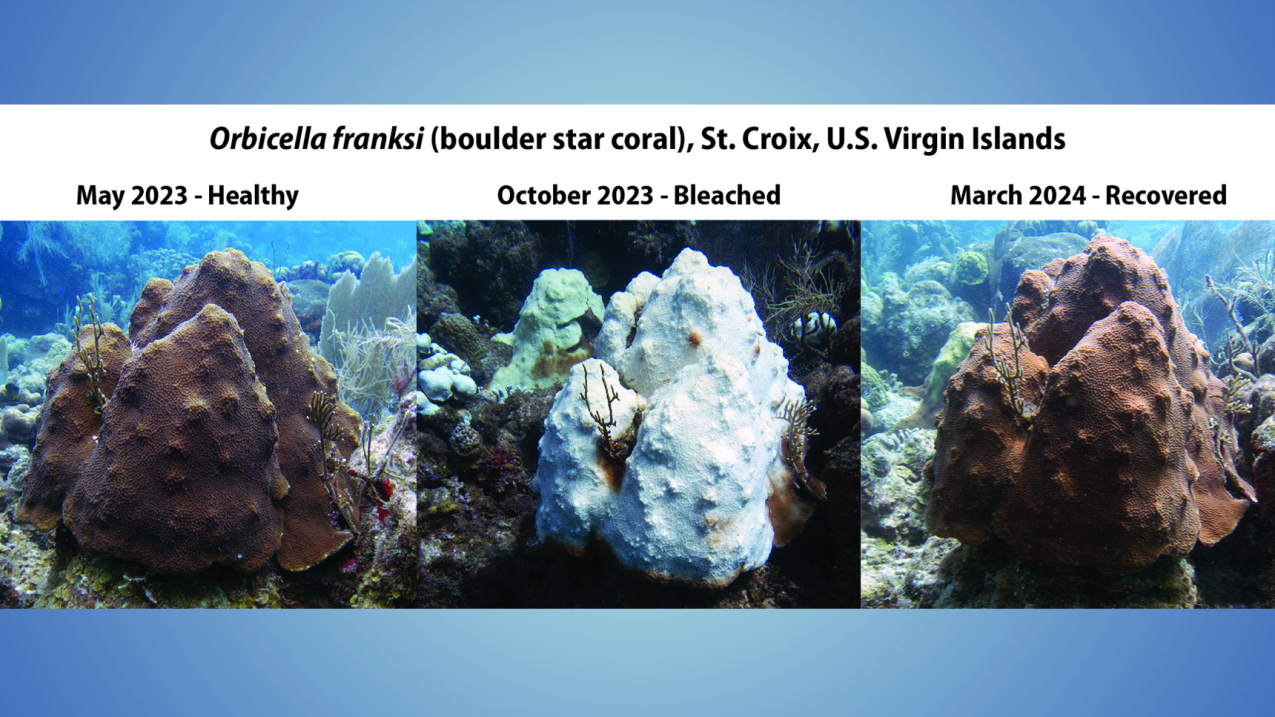
This three-panel image shows a boulder star coral in St. Croix, USVI, as it shifted from healthy (May 2023), to bleached (October 2023), to recovered (March 2024), following extreme marine heat stress throughout the Caribbean basin in 2023. (Image credit: NOAA)
The world is currently experiencing a global coral bleaching event, according to NOAA scientists. This is the fourth global event on record and the second in the last 10 years.
Bleaching-level heat stress, as remotely monitored and predicted by NOAA’s Coral Reef Watch (CRW), has been — and continues to be — extensive across the Atlantic, Pacific and Indian Ocean basins. CRW's heat-stress monitoring is based on sea surface temperature data, spanning 1985 to the present, from a blend of NOAA and partner satellites.
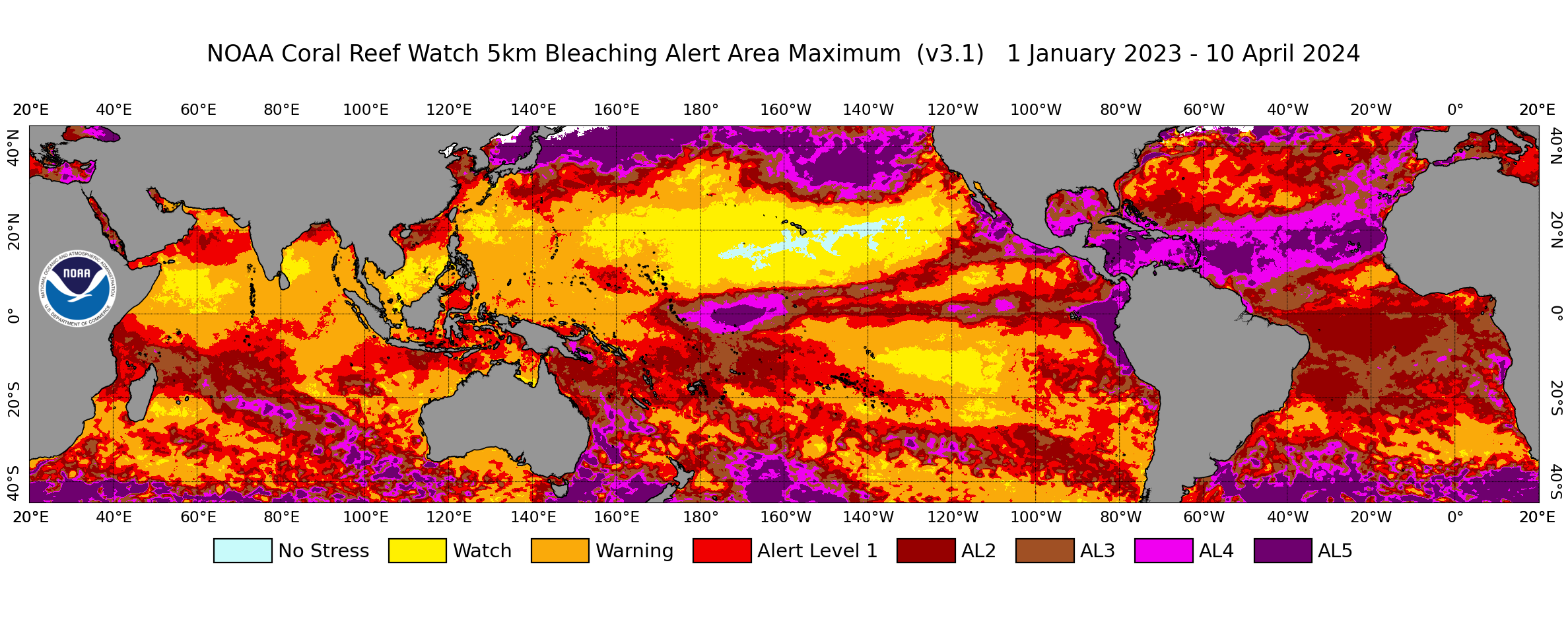
"From February 2023 to April 2024, significant coral bleaching has been documented in both the Northern and Southern Hemispheres of each major ocean basin," said Derek Manzello, Ph.D., NOAA CRW coordinator.
Since early 2023, mass bleaching of coral reefs has been confirmed throughout the tropics, including in Florida in the U.S.; the Caribbean; Brazil; the eastern Tropical Pacific (including Mexico, El Salvador, Costa Rica, Panama and Colombia); Australia’s Great Barrier Reef; large areas of the South Pacific (including Fiji, Vanuatu, Tuvalu, Kiribati, the Samoas and French Polynesia); the Red Sea (including the Gulf of Aqaba); the Persian Gulf; and the Gulf of Aden.
NOAA has received confirmation of widespread bleaching across other parts of the Indian Ocean basin as well, including in Tanzania, Kenya, Mauritius, the Seychelles, Tromelin, Mayotte and off the western coast of Indonesia.
“As the world’s oceans continue to warm, coral bleaching is becoming more frequent and severe,” Manzello said. “When these events are sufficiently severe or prolonged, they can cause coral mortality, which hurts the people who depend on the coral reefs for their livelihoods.”
Coral bleaching, especially on a widespread scale, impacts economies, livelihoods, food security and more, but it does not necessarily mean corals will die. If the stress driving the bleaching diminishes, corals can recover and reefs can continue to provide the ecosystem services we all rely on.
“Climate model predictions for coral reefs have been suggesting for years that bleaching impacts would increase in frequency and magnitude as the ocean warms,” said Jennifer Koss, director of NOAA’s Coral Reef Conservation Program (CRCP).
Because of this, the NOAA CRCP incorporated resilience-based management practices and increased the emphasis on coral restoration in its 2018 strategic plan , and funded a National Academies of Sciences’ study, which led to the publication of the 2019 Interventions to Increase the Resilience of Coral Reefs. offsite link
Koss said, “We are on the frontlines of coral reef research, management and restoration, and are actively and aggressively implementing the recommendations of the 2019 Interventions Report.”
The 2023 heatwave in Florida was unprecedented. It started earlier, lasted longer and was more severe than any previous event in that region. During the bleaching event, NOAA learned a great deal while engaging in interventions to mitigate harm to corals. Through its Mission: Iconic Reefs program offsite link , NOAA made significant strides to offset some of the negative impacts of global climate change and local stressors on Florida’s corals, including moving coral nurseries to deeper, cooler waters and deploying sunshades to protect corals in other areas.
This global event requires global action. The International Coral Reef Initiative offsite link (ICRI), which NOAA co-chairs, and its international members are broadly sharing and already applying resilience-based management actions and lessons learned from the 2023 marine heatwaves in Florida and the Caribbean. ICRI and its members are helping to advance coral interventions and restoration in the face of climate change by funding scientific research on best management practices and implementing its Plan of Action offsite link .
NOAA’s Coral Reef Conservation Program is a partnership across multiple NOAA offices and programs that brings together expertise for a multidisciplinary approach to understanding and conserving coral reef ecosystems.
Climate, weather, and water affect all life on our ocean planet. NOAA’s mission is to understand and predict our changing environment, from the deep sea to outer space, and to manage and conserve America’s coastal and marine resources.
Media contacts
John Leslie, john.leslie@noaa.gov
Kim Rodgers, kim.rodgers@noaa.gov
Related Features //
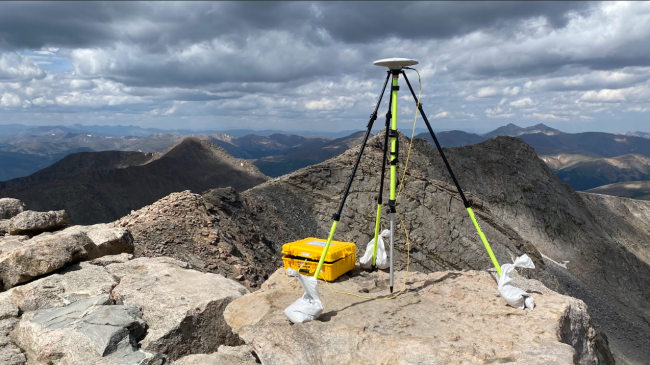

IMAGES
VIDEO
COMMENTS
Create a dedicated section. Add a component to your resume page titled "Publications.". Use reverse chronological order. List each publication as its own bullet point, starting with the most recently published. Choose only the most recent and relevant publications to avoid taking up valuable space on your resume.
The following are situations where it is beneficial to list publications on your resume: 1. When applying for an academic position. Including your publications on a resume is helpful when applying for academic positions such as lecturing or research jobs or graduate school.The publications demonstrate to the recruitment or admissions committee that you have research and writing skills.
These steps will help you add publications to your resume: 1. First, create a separate section. Just as most resumes have a section for experience and education, include a separate section with the heading 'Publications.'. If you are writing an academic resume, consider listing the publications near the top of your resume.
Put them in a separate resume section called "Publications.". Add your publications section below your education. Include each publication in a new bullet point. List the year and title. Add the name of the magazine, website, or journal. Stick with publications that show required skills.
brief. 1. Decide where to put your publications. Once you've decided to include publications on your resume, the next step is to decide where to put them. Depending on the number of publications you wish to list, you can use a dedicated publications section, or list your publications within your education section.
Write first all of the names of the authors. Then include the title of the publication. It's not a problem if there is more than one author, you can separate them with "and". List other non-peer-reviewed publications last. We said that it's best if all of your publications are peer-reviewed.
APA example citation: [last name], [first initial]. [middle initial]. (year of publication). [article title]. [journal name] [volume number] ( [issue number]) [pages]. Note that you may also want to include the URL of any website where the work is published if the publication is online.
MLA format example. The Modern Language Association (MLA) style is often used for publications on a CV. Follow this simple structure: last name, first initial, article title, journal name, volume number, issue number, year, and then page number (s). Take a look at our example below. Example.
List your publications in reverse-chronological order, with the most recent at the top. Cite the names of any authors in the order listed on the publication. Enter the name of the article, chapter, or book. Include the name of the journal, website, or conference where it was published. Add the date of publication.
A journal article listed on a resume in APA style would look like this: journals: apa. Publications. Parker, P. & Smith, S. (2018). A comparison of body structures of insects and arachnids. Journal of Insect Life, 147, 160-171. For book publications, a listing in APA style would look thus: books: apa. Publications.
Option # 3: Create a separate page for your publications. If you have a substantial number of accomplishments that involve research and publications, you could consider a separate page for those details. Simply create a list of these citations for a page titled "Publications" or "Research.". There, you can list all relevant citations in ...
If you want to add a publication that you have co-authored, add the names of its authors, separating each by a comma and adding "&" before the last name, and place your name in bold. Here is how you can include a co-authored publication on your CV: Roberts, C. C., Wilson, A. V., & Garcia, L. A. (2015).
Publications on your resume: Put them in a separate section called "Publications". Include each publication in a new bullet point. List the year and title. Add the name of the magazine, website, or journal. Only include publications that are relevant to the job you're applying for.
It's perfectly fine to omit some information if you don't have it (such as "journal name," "volume number," and similar). #4. Go For the Right Format. The final piece of the puzzle in creating an engaging publications section on your resume is selecting the appropriate format.
Structure for Written Publications. Author's last name, author's first and middle names or initials. Title of article/chapter + name of journal/magazine/website etc. Year of publication. Publishers or issue number + volume number + (if applicable) page numbers. Remember to include the URL if the publication is online.
Adding publications on a resume is a specialized qualification, usually ony for academia, marketing, or a writing position. Publications should be listed in reverse chronological order, avoid out of date articles, works not relevant to the position, and follow proper formatting guides. Published works to include a resume or CV include: books ...
List the publications in bullet points, including the title, date, and journal name. You can list academic publications more formally if you're applying to graduate school or seeking a role in academia. Related: Create a Resume Publications Section in APA and MLA. 6. Highlight research skills in the skills section.
Create a section on your resume titled "Publications.". Use reverse chronological order when listing, starting with your most recent published works. Use a new bullet point for each publication. Pick only publications that are relevant and showcase applicable skills or knowledge.
3. Choose your publication category at the top (such as Book, Book Section, and Journal Article). Then, enter details such as the Title, Year, and Publisher. 4. Click "OK" and then "New…" again as needed to enter your other publications. When you're done, click "Close" on the bottom right to exit the Source Manager menu. 5.
There are two generally accepted formats you can adopt to put publications on your resume/CV, the MLA format and APA format. 1. Written Publications. Academic books, a chapter in a book, theses, journal articles and research papers are all written publications. APA style journal articles.
Make sure you list the other author and yourself in the case of a two-author publication. Put your own name in bold. For publications with three or more authors, use the phrase ' et al '. Let's look at an example of a two-author publication if your name is Jane Doe: Publications. Smith, J., Doe, J. "Upward Trends in Crowdfunding.".
If you want to add publications to your CV, you should read a few tips for formatting them. Choose the correct format. If you do not have many publications, you can describe them in the "Research and Publications" section. As new papers appear, you will need to sort them and create separate lists of related publications.
As a reference, here are the different style guidelines to follow when listing your publications on a CV: APA Style - Journal Publication. Author last name, First initial. Middle initial. (Year of publication). Article title. Journal title, Volume (Issue), Page range. APA Style - Book. Author last name, First initial.
As with the functional resume, have your skills section at the top of the page, just after the summary. List your work experience after the skills section or toward the bottom of the page. These resumes are ideal for health care professionals seeking a mid-level job title. 6. Use a professional layout. The layout is as important as the formatting.
Table 3 Top authors in australopiths research (> 30 publications) Full size table The collaboration network among authors who published more than 30 documents on this subject is shown in Fig. 7 , so, clusters are centered around a main author and the connecting scholars are individuals who have collaborated with that individual.
The technology industry is betting on AI to create alternatives to the iPhone. But testing one high-profile attempt — the Humane Ai Pin — reveals that smartphones aren't going anywhere.
Kim Rodgers, [email protected]. The world is currently experiencing a global coral bleaching event, according to NOAA scientists. This is the fourth global event on record and the second in the last 10 years. Bleaching-level heat stress, as remotely monitored and predicted by NOAA's Coral Reef Watch (CRW), has been — and continues to be ...